Introduction
In an era where healthcare demands are rapidly evolving, automation emerges as a pivotal solution to enhance efficiency and improve patient outcomes. Automation in healthcare not only streamlines administrative tasks but also ensures that healthcare professionals can dedicate more time to direct patient care. This shift not only reduces operational costs but also significantly enhances the quality of care provided.
By integrating advanced technologies like AI and machine learning, healthcare facilities can revolutionize their operations, leading to faster, more accurate processes and substantial cost savings. This article delves into the multifaceted benefits of healthcare automation, explores real-world examples of its implementation, and addresses the challenges and best practices for integrating these technologies into healthcare systems. Discover how embracing automation can transform healthcare delivery, making it more efficient, effective, and patient-centric.
Benefits of Automation in Healthcare
Automation in medical services provides groundbreaking advantages, such as enhanced operational efficiency, decreased administrative loads, and better outcomes for individuals. By automating routine tasks, medical providers can allocate more time to patient care, ensuring that staff focus on higher-value activities that enhance service delivery. For instance, automated systems can handle prior authorizations, billing, and insurance claims, expediting processes and reducing the need for manual interventions, as evidenced by a significant decrease in physician abandonment rates from 31% to 25%.
The effect of mechanization extends to substantial cost savings. By eliminating more than 6,800 hours of manual audit work annually, healthcare organizations like The University of Kansas Health System have demonstrated the financial benefits of automation. These savings allow for reinvestment in healthcare services and advanced technologies, promoting an environment where resources are utilized more effectively.
Automation also leads to enhanced outcomes for individuals receiving care. By streamlining processes and reducing errors, individuals receive timely and accurate care. For instance, referral intake times can be significantly decreased, enabling individuals to be scheduled in minutes instead of days, thus improving satisfaction and health outcomes.
The incorporation of AI and machine learning technologies in medical care further emphasizes the potential of mechanization to transform the industry. New tools, like those recently announced by Microsoft, aim to save clinicians’ time on administrative tasks, which can constitute up to 41% of a nurse’s workload. This decrease in administrative tasks not only eases exhaustion but also enables medical professionals to devote more time to direct client support.
In summary, medical institutions that adopt automation and AI technologies will be more prepared to address the changing requirements of individuals, providing high-quality care efficiently and effectively.
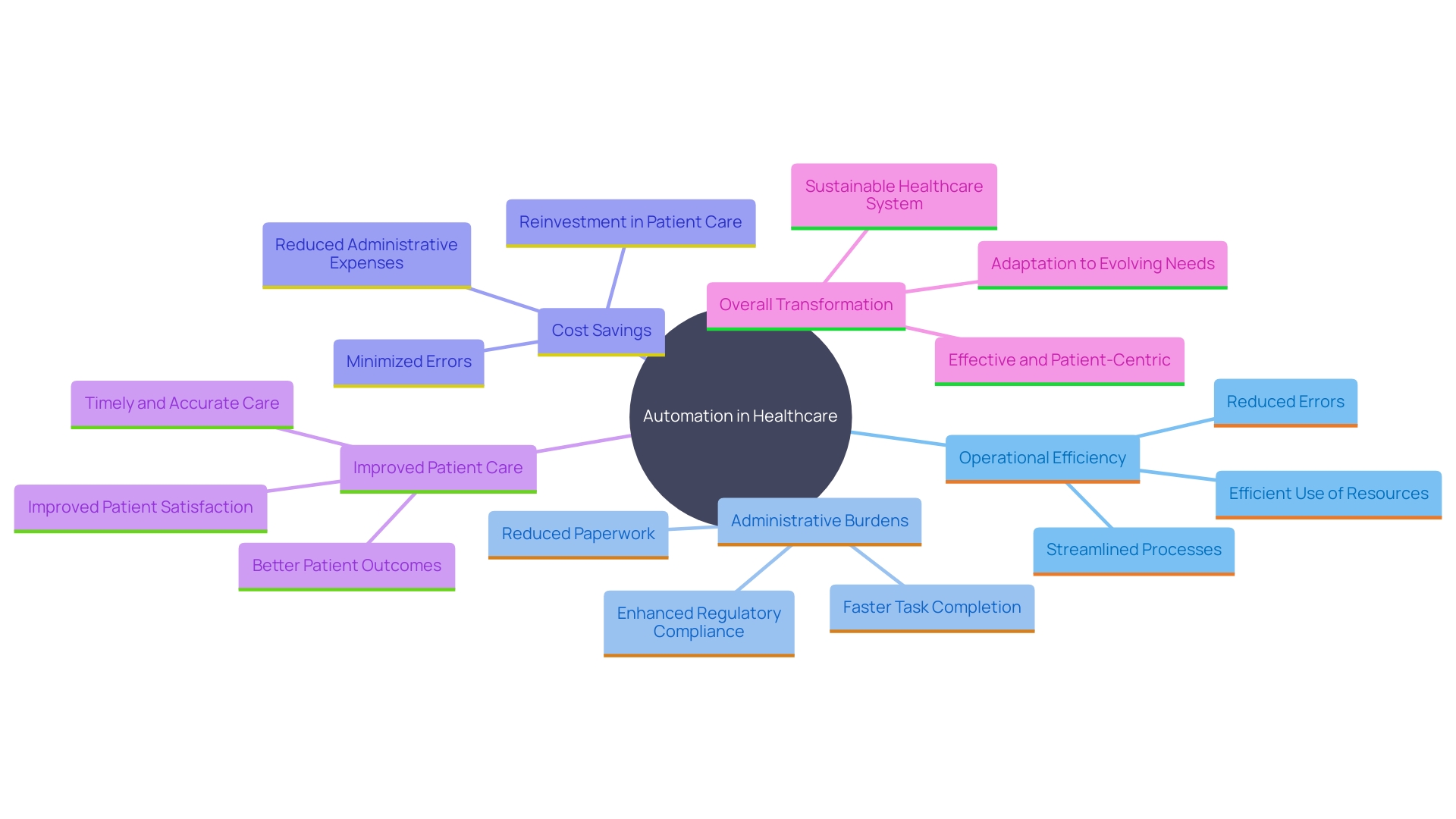
Streamlining Administrative Tasks
Administrative tasks often consume a significant portion of medical professionals’ time. Automation solutions can streamline processes such as appointment scheduling, client registration, and billing, reducing the time and effort required for these activities. By implementing automated workflows, healthcare organizations can minimize errors, enhance data accuracy, and improve client satisfaction through quicker and more efficient service.
For instance, the University of Kansas Health System has successfully implemented automated registration audits for over 38,000 visitor encounters. This innovation has enabled them to audit the performance of over 1,000 registration representatives without incurring additional costs. This automation has guaranteed individuals’ access to essential treatment, precise coding, and enhanced financial results, showcasing the concrete advantages of automation in medical services.
A recent analysis from Google Cloud and The Harris Poll emphasized that medical professionals dedicate almost 28 to 36 hours each week to administrative duties, resulting in burnout and decreased time for those they serve. Automation can ease this burden, enabling staff to concentrate more on patient support, thus enhancing patient outcomes and satisfaction. By minimizing mistakes and optimizing processes, healthcare providers can offer prompt and precise services, significantly improving health outcomes.
Furthermore, automation can lead to substantial cost savings by reducing administrative expenses and minimizing errors. These savings can be reinvested in healthcare and other vital services. As an example, automating the referral intake process ensures individuals are scheduled in minutes rather than days, leading to more efficient and effective treatment.
In summary, adopting automation in healthcare not only alleviates the administrative load but also improves the overall effectiveness, precision, and quality of services provided to individuals.
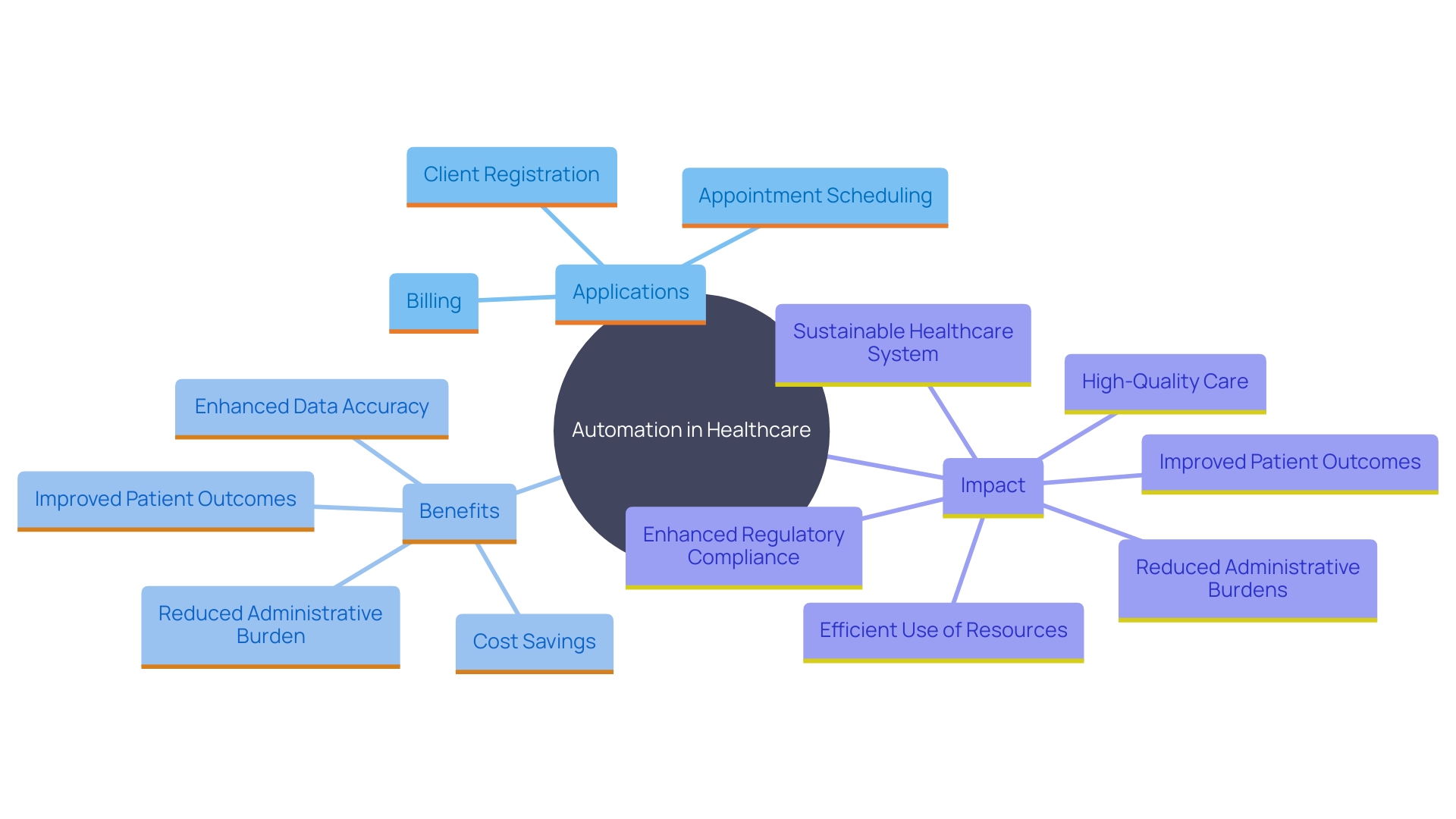
Enhancing Patient Care with Automation
Automated systems transform healthcare by ensuring timely access to critical information, facilitating personalized treatment plans, and enhancing communication between providers and individuals. Telemedicine platforms and automated reminders for medication adherence are instrumental in empowering individuals to actively manage their health, leading to improved outcomes and higher engagement.
Recent advancements in AI, such as Summer Health’s use of GPT-4 to generate visit notes, have significantly reduced administrative burdens for healthcare providers, allowing them to dedicate more time to care for individuals. This innovation has resulted in a fivefold reduction in the time required for note-taking and administrative tasks, allowing for more valuable time for direct interactions with individuals.
Furthermore, entities such as Montefiore Einstein Comprehensive Cancer Center have effectively utilized AI tools to double the colonoscopy completion rates among individuals who canceled or missed appointments. ‘This not only enhances patient outcomes but also optimizes the efficiency of medical services.’.
Studies indicate that telemedicine is comparable in quality to in-person visits, suggesting that its increased implementation can positively impact health outcomes. For instance, the readmission rates for telemedicine and conventional office visits are almost the same, highlighting telemedicine’s effectiveness in delivering continuous, quality service.
As John Squeo from CitiusTech emphasizes, the future of medical services lies in simplifying care journeys through telehealth and automation, ensuring a more streamlined, accessible, and patient-centric system. By concentrating on minimizing administrative duties and improving patient involvement, medical systems can attain improved clinical results and patient contentment.
These technological advancements underscore the critical role of automated systems and telehealth in transforming medical delivery, making it more efficient, effective, and patient-focused.
Challenges and Considerations in Healthcare Automation
While the benefits of automation in medical services are substantial, several challenges must be addressed to ensure successful implementation. Resistance to change, data privacy concerns, and integration issues with existing systems are significant hurdles. For instance, the integration of AI and digital wellness solutions like those offered by Infermedica into existing medical systems can be complex and requires careful planning. Healthcare executives must engage in long-term strategic planning that is both visionary and adaptable, considering the increasing role of big data in decision-making and the necessity for robust cybersecurity measures.
Training and support for staff are crucial to overcoming resistance to change. As noted in McKinsey’s research, 75% of health system executives place a high priority on digital and analytics transformation but lack sufficient resources or planning. Ensuring staff are comfortable with new technologies requires comprehensive training programs and continuous support.
Maintaining compliance with medical regulations is another critical aspect. The Digital Technology Assessment Checklist (DTAC) is one tool used to ensure that technology meets required standards, emphasizing the need for clear guidelines on understanding medical device status. This thorough approach reduces the risk of non-compliance and enhances the overall integration process.
Considering these points, it is clear that while mechanization offers immense potential for enhancing operational efficiency and patient care, the route to implementation must be approached with careful consideration of these challenges.
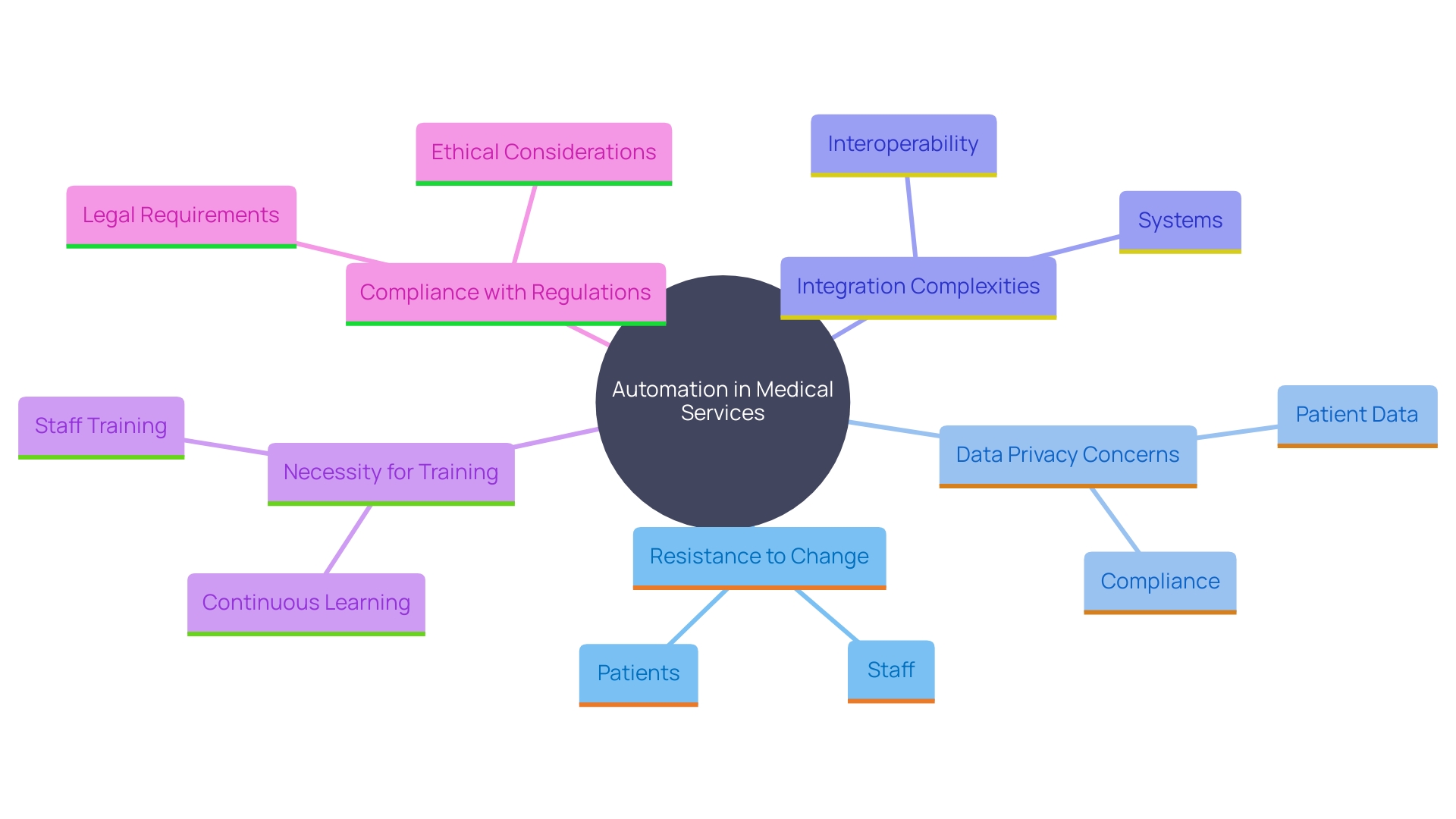
Best Practices for Implementing Healthcare Automation
To successfully implement healthcare technology, organizations should start with a clear strategy that aligns with their specific goals and operational needs. This approach is exemplified by the Mass General Brigham hospital system, which faced a bottleneck in tracking providers. They formed a team dedicated to streamlining processes that included developers and a process specialist from the finance department. This team built and managed automation tools, restructuring workflows to enhance efficiency. The new tool automatically collected and organized provider data, enabling the finance team to focus on higher-value tasks.
Engaging frontline staff in the planning process fosters buy-in and ensures that solutions are user-friendly. For instance, collaboration between departments is crucial, as highlighted by Ms. Fox, who emphasized understanding each team’s challenges and leveraging them for improvement. Continuous monitoring and feedback loops are essential for refining automated processes over time. This holistic approach not only enhances operational efficiency but also improves outcomes for individuals. By optimizing procedures and minimizing mistakes, healthcare organizations can guarantee prompt and precise treatment, resulting in improved satisfaction and health outcomes. Furthermore, automation can lead to significant cost savings by reducing administrative expenses and minimizing errors, allowing these savings to be reinvested in patient care and other essential services.
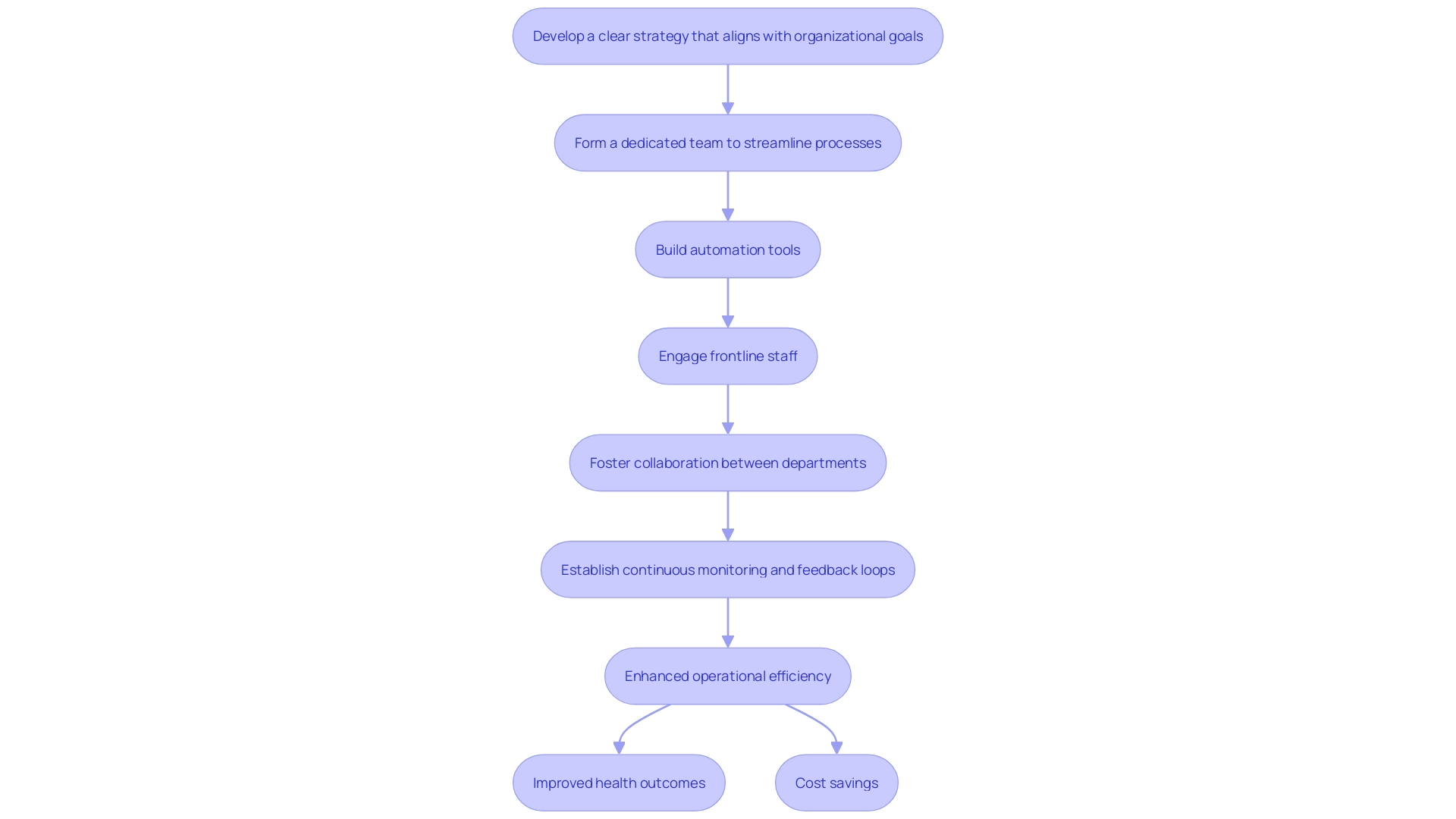
Conclusion
The integration of automation in healthcare presents a multitude of benefits that can significantly transform how care is delivered. By streamlining administrative tasks, organizations can enhance operational efficiency, reduce costs, and ultimately improve patient outcomes. The use of automated systems for tasks such as billing, appointment scheduling, and patient registration not only alleviates the administrative burden on healthcare professionals but also allows them to focus on what truly matters—providing quality patient care.
Moreover, the advent of AI and machine learning technologies has further amplified the potential of automation in healthcare. These innovations facilitate timely access to critical information, improve communication between providers and patients, and empower individuals to manage their health actively. The success stories from various healthcare organizations illustrate how automation can lead to higher patient engagement, satisfaction, and health outcomes.
However, the journey toward successful automation is not without its challenges. Resistance to change, data privacy concerns, and the complexities of integrating new systems into existing workflows must be addressed comprehensively. Organizations must prioritize training and support for staff, ensuring they are equipped to navigate these changes effectively.
By embracing best practices in planning and implementation, healthcare systems can unlock the full potential of automation, paving the way for a more efficient, effective, and patient-centric future in healthcare delivery.
Introduction
In an era where communication is paramount, chatbots have emerged as invaluable assets, revolutionizing the way organizations engage with users. These sophisticated tools, powered by natural language processing (NLP), machine learning (ML), and scripted responses, offer seamless and human-like interactions. By delving into the intricacies of chatbot architecture, the various types available, and the myriad benefits of automation, this article provides a comprehensive guide to understanding and leveraging chatbots to enhance operational efficiency and user satisfaction.
As businesses increasingly adopt this technology, the insights shared here will empower decision-makers to harness the full potential of chatbots in achieving their strategic objectives.
How Chatbots Work
Chatbots utilize a blend of natural language processing (NLP), machine learning (ML), and scripted responses to communicate effectively with individuals. By examining the individual’s input, these automated systems offer pertinent responses or actions based on predefined guidelines or data-informed trends they have acquired. This creates an interaction that closely resembles human conversation, allowing individuals to engage seamlessly with the chatbot. For instance, NLP-driven virtual assistants can adapt their responses to the user’s context and preferences, offering a more personalized experience. ‘According to Sam Altman, CEO of OpenAI, this signifies the ‘beginning of a new paradigm’ in AI, with conversational agents acting as sophisticated ‘co-pilots’ capable of handling complex tasks and delivering lightning-fast responses.’.
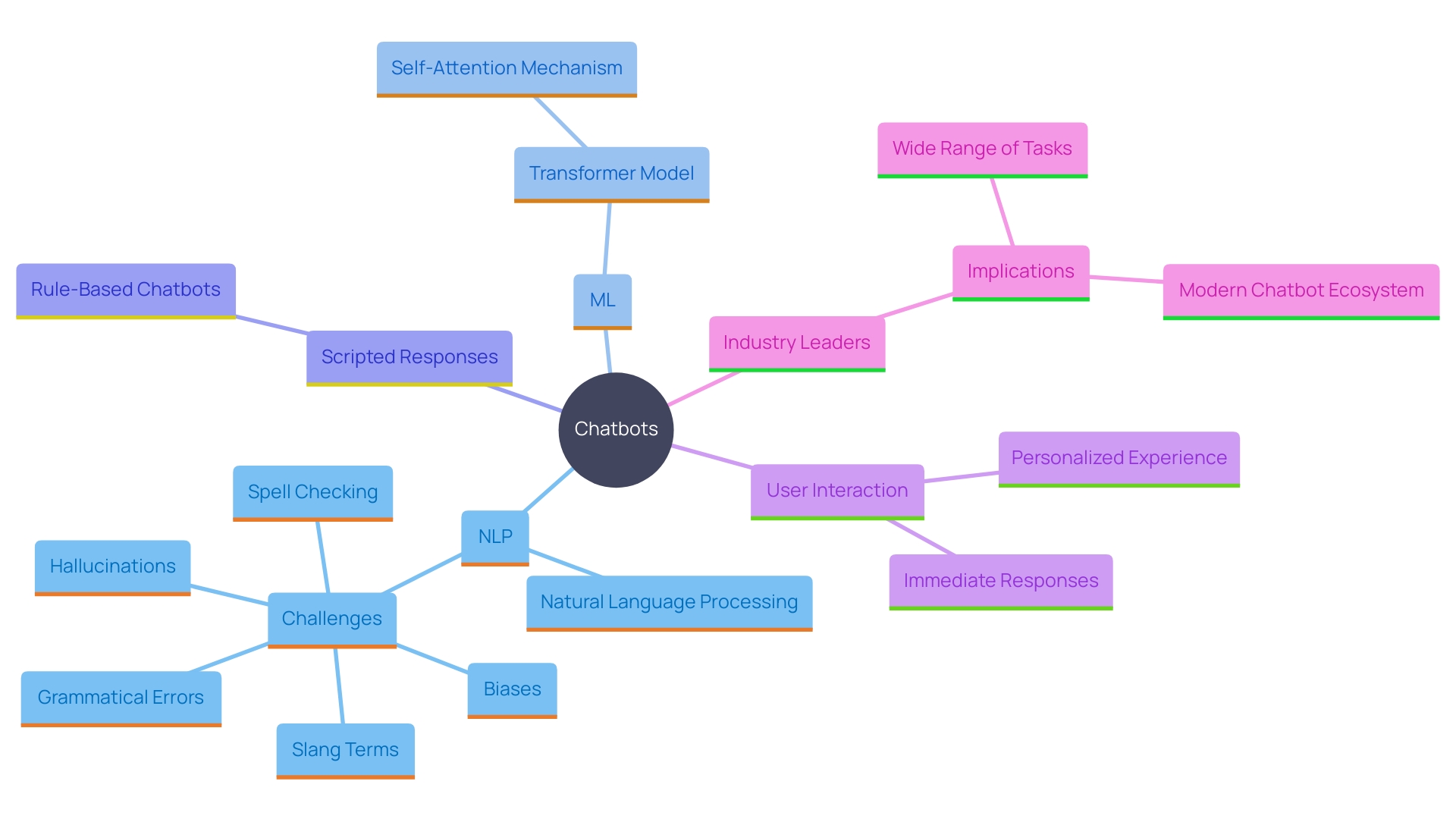
Key Components of Chatbot Architecture
The architecture of chatbots revolves around several core components that work cohesively to ensure seamless communication. At the forefront is the interface, which serves as the primary medium for interaction. This interface is crafted to be intuitive and responsive, enabling individuals to effortlessly navigate and interact with the chatbot.
Behind the scenes, the backend system takes the center stage. This system processes requests using a combination of algorithms and databases. These algorithms, often powered by advanced AI and machine learning models, interpret input from individuals and generate appropriate responses. The use of neural networks and probabilistic models enables the chatbot to understand and generate human-like language, enhancing the overall user experience.
Moreover, conversational agents leverage large language models (LLMs) like GPT-4 and ChatGPT, known for their exceptional performance in dialog systems. However, the training and fine-tuning of these models can be resource-intensive. Recent advancements have demonstrated how custom chatbots can be trained efficiently even on standard hardware, utilizing optimized methodologies and processors such as the 4th Generation Intel® Xeon® Scalable processors.
Chatbots are not just limited to simple interactions. They can manage a broad array of tasks, from responding to frequently asked questions to assisting individuals through processes and offering customer support. With the assistance of no-code platforms, establishing and personalizing automated conversation systems has become more accessible, allowing for tailored user experiences that align with business needs.
In real-world applications, virtual assistants have proven to be invaluable. For instance, a recent development involved optimizing a chatbot initially created by a third-party. This chatbot faced several technical challenges that needed to be addressed before it could be deployed successfully. By thoroughly analyzing and refining the chatbot, it was made ready for verification and deployment, showcasing the practical benefits of continuous optimization.
Statistics highlight the growing reliance on automated conversational agents, with approximately 1.4 billion individuals using them globally. Additionally, a substantial portion of customer support engagements are now managed by AI, highlighting the efficiency and effectiveness of automated messaging systems in contemporary communication.
As technology advances, the potential of conversational agents continues to grow, providing innovative solutions for improved user interaction and operational efficiency.
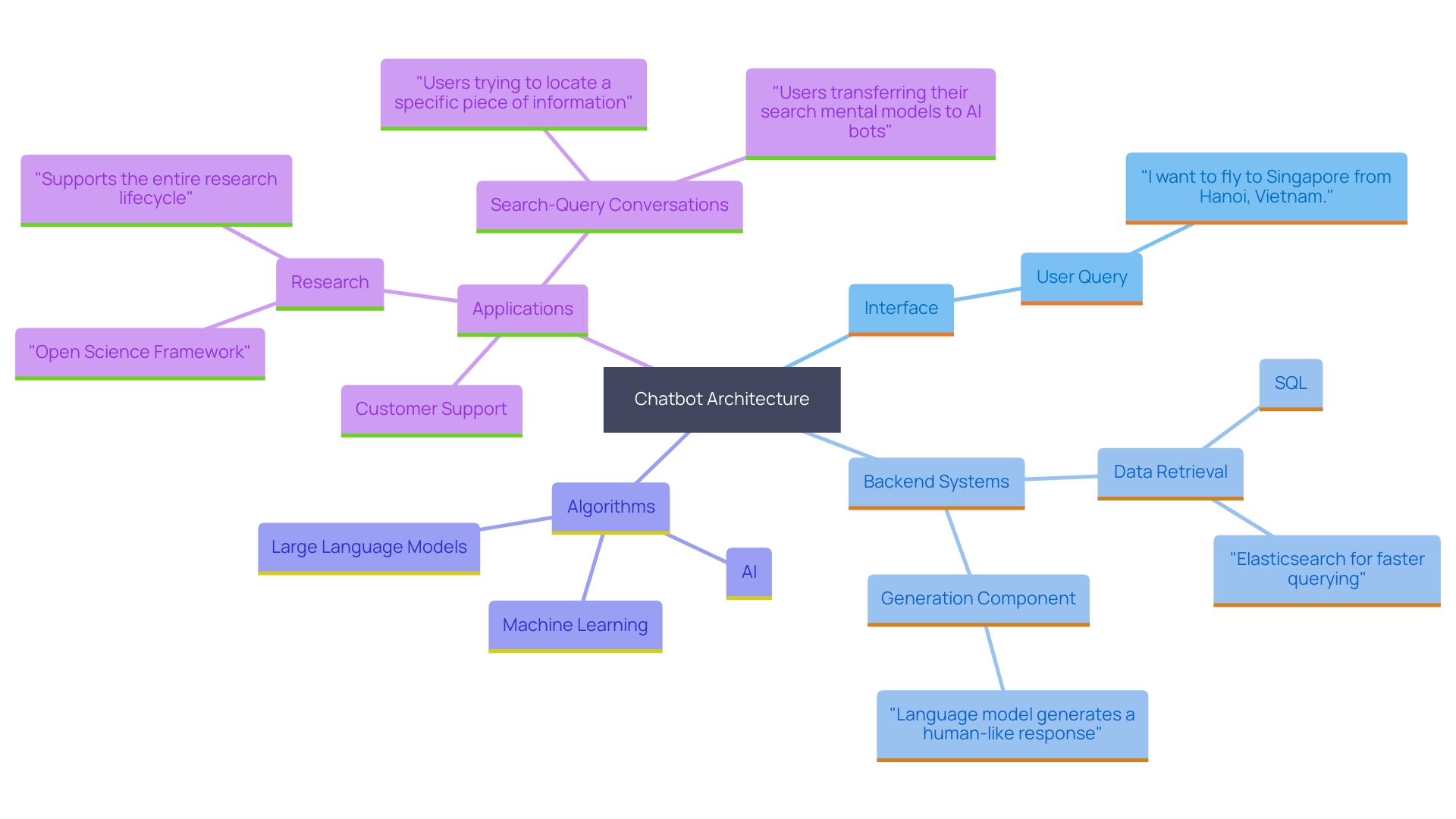
Types of Chatbots
Chatbots come in various forms, each tailored to serve distinct purposes. Rule-based virtual assistants operate on predefined scripts, managing specific inquiries through a series of if-else statements. While straightforward, they are limited in scope and flexibility. On the other hand, AI-driven virtual assistants utilize machine learning to comprehend and reply to a broader range of questions, constantly evolving to enhance precision and significance over time.
For instance, Kabannas, a collection of three hotels in the UK, implemented AI-driven virtual assistants to enhance guest interactions across their digital platforms, including webchat, WhatsApp, and email. This initiative aimed to provide 24/7 support, allowing guests to engage with the hotels at their convenience. This approach not only fostered a community feel but also significantly boosted guest satisfaction by offering immediate and relevant responses.
Statistics indicate that over fifty percent of service organizations intend to implement automated messaging systems within the upcoming eighteen months, highlighting an increasing shift towards automation in client assistance. Additionally, a study commissioned by AI voice solution Tenyx revealed that seven out of ten consumers are frustrated with current virtual agents, highlighting the need for more advanced AI conversational agents that can better understand and address user needs.
In conclusion, grasping the various kinds of conversational agents and their abilities is essential for companies aiming to improve client engagement and operational efficiency. By leveraging AI-driven chatbots, companies can provide more tailored and effective customer support, ultimately enhancing overall client experience and satisfaction.
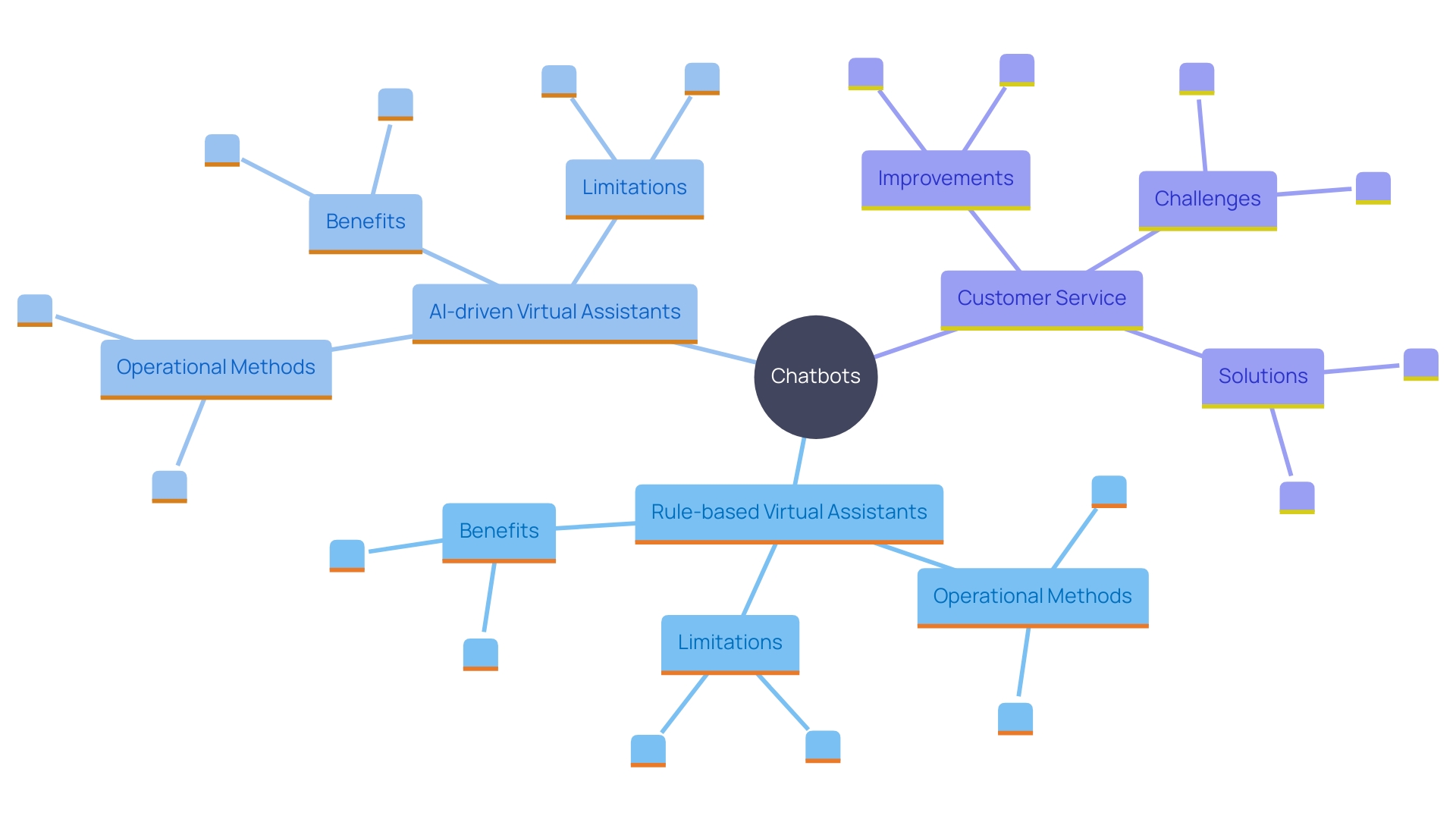
Benefits of Chatbot Automation
Chatbot automation provides significant benefits for organizations. Not only does it enhance user engagement by offering instant responses, but it also streamlines operations by addressing repetitive tasks. This technology improves efficiency, enabling human resources to focus on more complex interactions. According to research, 67% of the worldwide population has utilized automated assistants for client assistance, emphasizing their increasing importance in today’s digital environment. Furthermore, automated assistants manage 90% of complaints instantly when queries are clearly defined, which greatly reduces response times. As customer preferences continue to shift— with 33% favoring automated assistants over phone calls for reservations— it’s evident that these tools are becoming indispensable. This shift leads to a more productive environment and greater overall satisfaction for users, a trend supported by the fact that over half of service organizations intend to implement chatbots within the next 18 months.
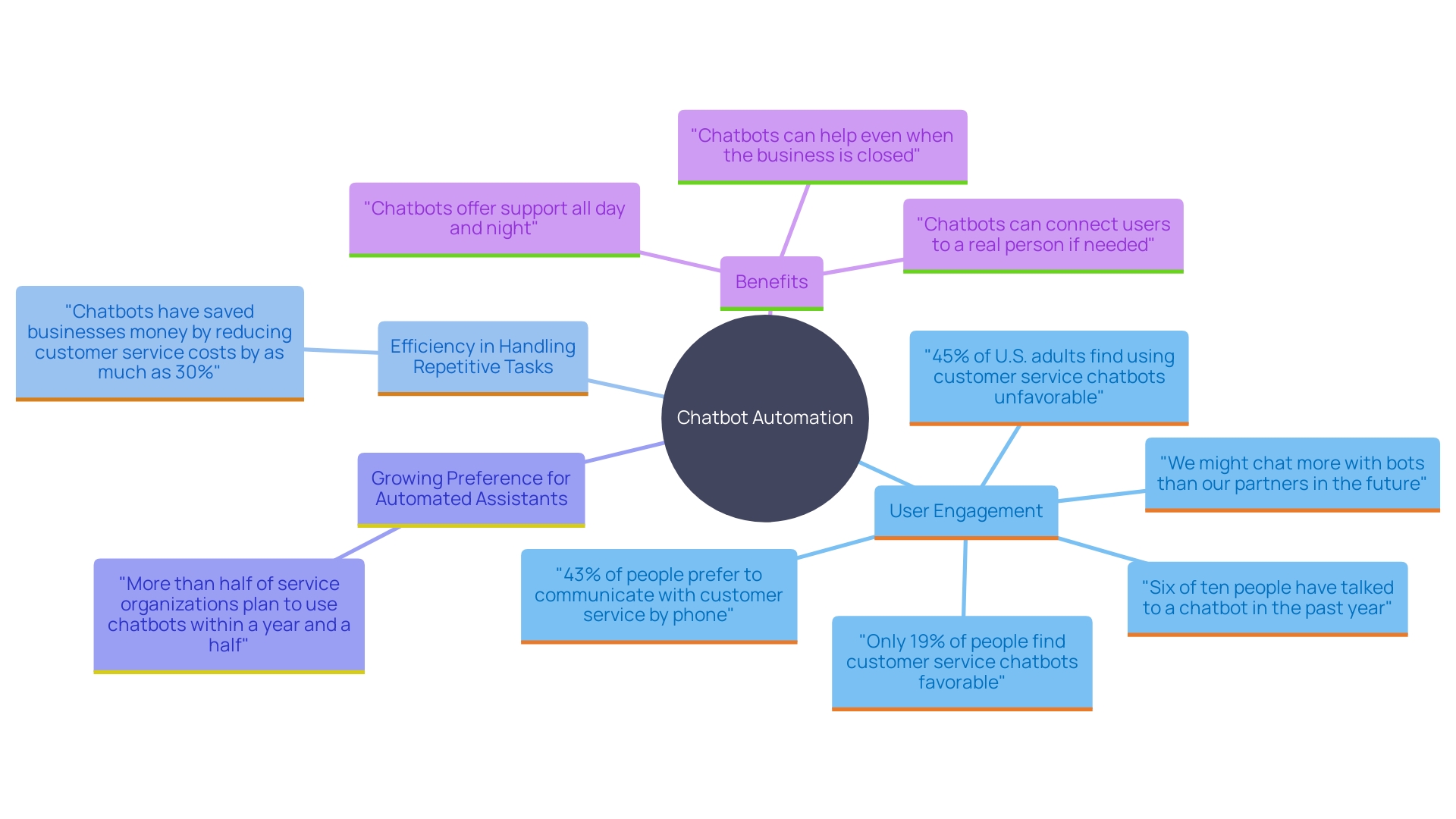
Conclusion
The exploration of chatbots reveals their transformative potential in enhancing communication and operational efficiency within organizations. By leveraging natural language processing and machine learning, chatbots facilitate seamless interactions that mimic human conversation. Their architecture, comprising intuitive user interfaces and sophisticated backend systems, enables them to deliver timely and relevant responses, making them invaluable tools in customer engagement.
Different types of chatbots cater to diverse needs, from simple rule-based systems to advanced AI-powered solutions. The effectiveness of AI chatbots, as demonstrated by real-world applications like those in the hospitality industry, underscores their ability to improve customer satisfaction and streamline service delivery. As businesses increasingly recognize the value of these technologies, the trend towards automation in customer service is gaining momentum.
The benefits of chatbot automation extend beyond mere convenience. By handling repetitive tasks and providing instant responses, chatbots free up valuable human resources to focus on more complex interactions. This not only enhances productivity but also aligns with shifting customer preferences, with a notable percentage favoring chatbots for their efficiency.
Embracing chatbot technology is not just a strategic move; it is essential for organizations aiming to thrive in a rapidly evolving digital landscape.
Introduction
In an era where operational efficiency is paramount, UiPath Action Center emerges as a critical tool, bridging the gap between automation and human involvement. This article delves into the transformative features of UiPath Action Center, highlighting how it facilitates seamless task delegation and integration with UiPath Orchestrator, thereby enhancing workflow productivity. It also explores the significant benefits of incorporating human-in-the-loop automation, emphasizing improved decision-making and error reduction.
Furthermore, the discussion extends to real-world applications across various industries, showcasing success stories that underline the tool’s versatility and impact. Finally, the article provides best practices for effective implementation, ensuring organizations can fully leverage the capabilities of UiPath Action Center to achieve optimal operational efficiency.
Key Features of UiPath Action Center
UiPath Action Center serves as a crucial connection between automated processes and personal involvement, enhancing operational efficiency through various advanced features. It excels in managing and tracking human-in-the-loop processes, allowing for seamless task delegation to users and smooth integration with UiPath Orchestrator. The interface is designed with user-friendliness in mind, ensuring effortless navigation and prioritization of tasks to guarantee critical operations are addressed promptly. Furthermore, it enhances collaboration between humans and robots by supporting notifications and reminders, ensuring everyone stays informed and aligned. This functionality has experienced greater acceptance, rising from 10% to 56% among professionals, as emphasized in the recent report on technological trends. This report, based on a global survey of 1,639 automation professionals and students, showcases the increasing dependence on tools such as UiPath Workflow Hub to streamline complex processes and enhance productivity.
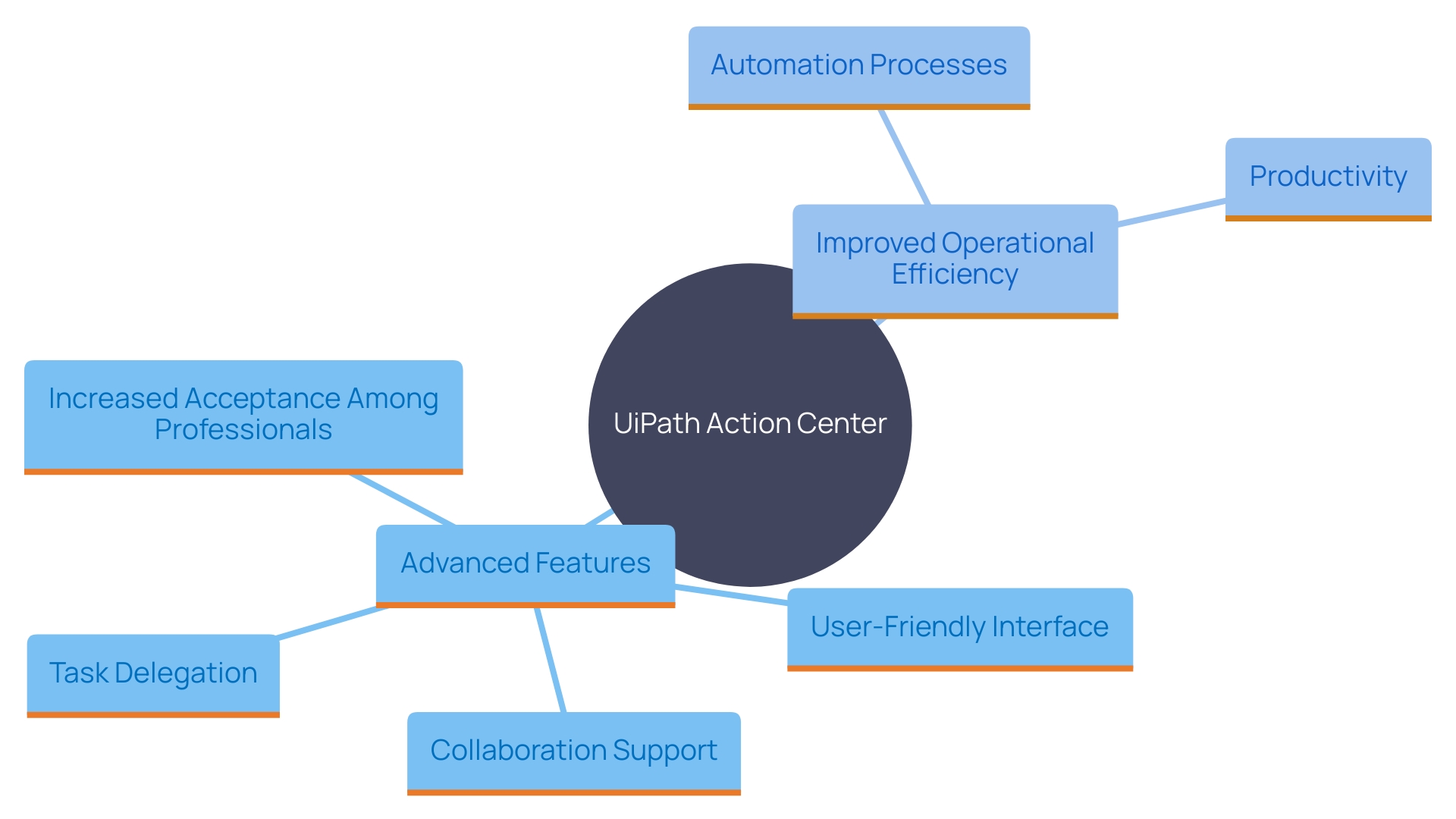
Benefits of Human in the Loop Automation
Incorporating user input into automated processes through UiPath Action Hub significantly improves operational efficiency by enabling smooth human-robot collaboration. This framework ensures that complex decisions needing personal judgment are made effectively, minimizing errors in automated workflows. According to Armstrong of the MIT Industrial Performance Center, incorporating worker feedback through participatory design practices can greatly enhance the effectiveness of these systems. Such practices not only empower employees but also foster a collaborative environment, leading to improved job satisfaction and productivity.
Furthermore, adding mechanization does not imply removing personnel positions. As noted by SS&C Blue Prism, mechanization enhances the workforce by managing repetitive, high-volume tasks, allowing employees to concentrate on value-added activities. This approach aligns with the principles of Industry 5.0, where the goal is to increase productivity without eliminating workers from the equation.
Furthermore, organizations can expand their mechanization efforts while upholding quality control. The digital workforce can flexibly adapt to varying work demands, ensuring that essential oversight is available where needed. This adaptability is crucial for maintaining operational resilience and efficiency, especially in the face of market turbulence and resource availability challenges.
Lastly, a global survey of 1,639 professionals in the field revealed that there is a growing openness to integrating AI into working activities, further supporting the trend towards intelligent processes. By utilizing cognitive automation systems that replicate intelligence, organizations can improve their decision-making processes and operational efficiency.
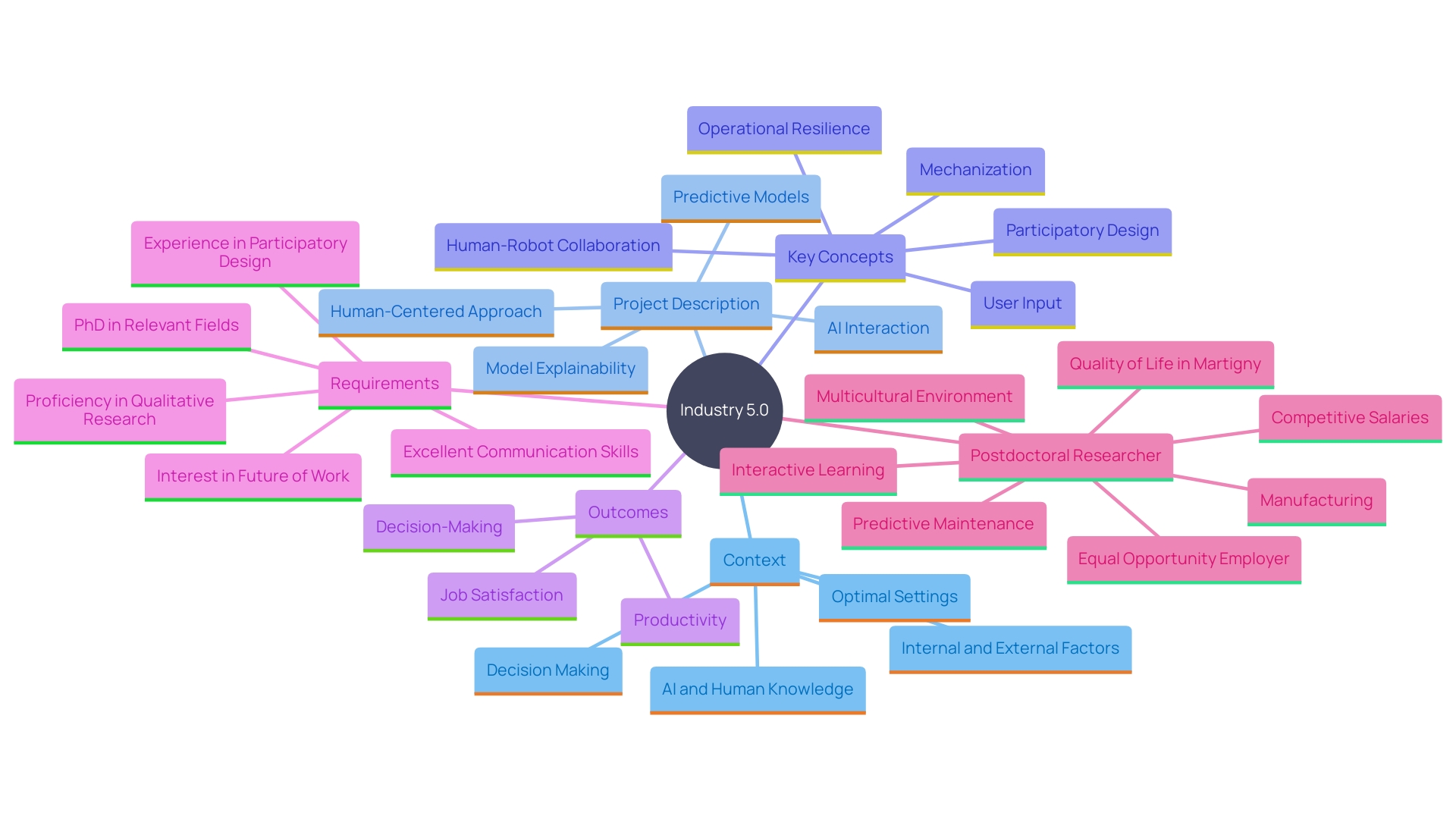
Real-World Applications and Success Stories
UiPath Task Hub has shown its capability to enhance operations across different sectors. In the finance sector, it has significantly enhanced compliance checks by allowing human reviewers to validate automated reports, thereby reducing fraudulent activities and boosting customer trust. This mirrors the success seen by a leading financial institution that employed advanced fraud detection algorithms, resulting in a notable reduction in fraudulent activities.
Healthcare has also gained advantages from UiPath’s operational hub, particularly in patient data management. Medical staff can review and approve actions taken by bots, ensuring data accuracy and seamless operations. For instance, a rural hospital underwent a relaunch of its analytic processes as part of an organizational quality project. This initiative aimed to harness the power of analytics, making it easier for leadership to gauge progress and make informed decisions, ultimately improving patient outcomes.
Moreover, UiPath’s robust growth and adoption underline its effectiveness. The company reported a 24% year-on-year revenue increase this quarter, signaling a strong market position and the growing reliance on its automation solutions. These success stories highlight the versatility and effectiveness of UiPath’s platform in tackling industry-specific challenges, establishing it as an essential resource for operational efficiency.
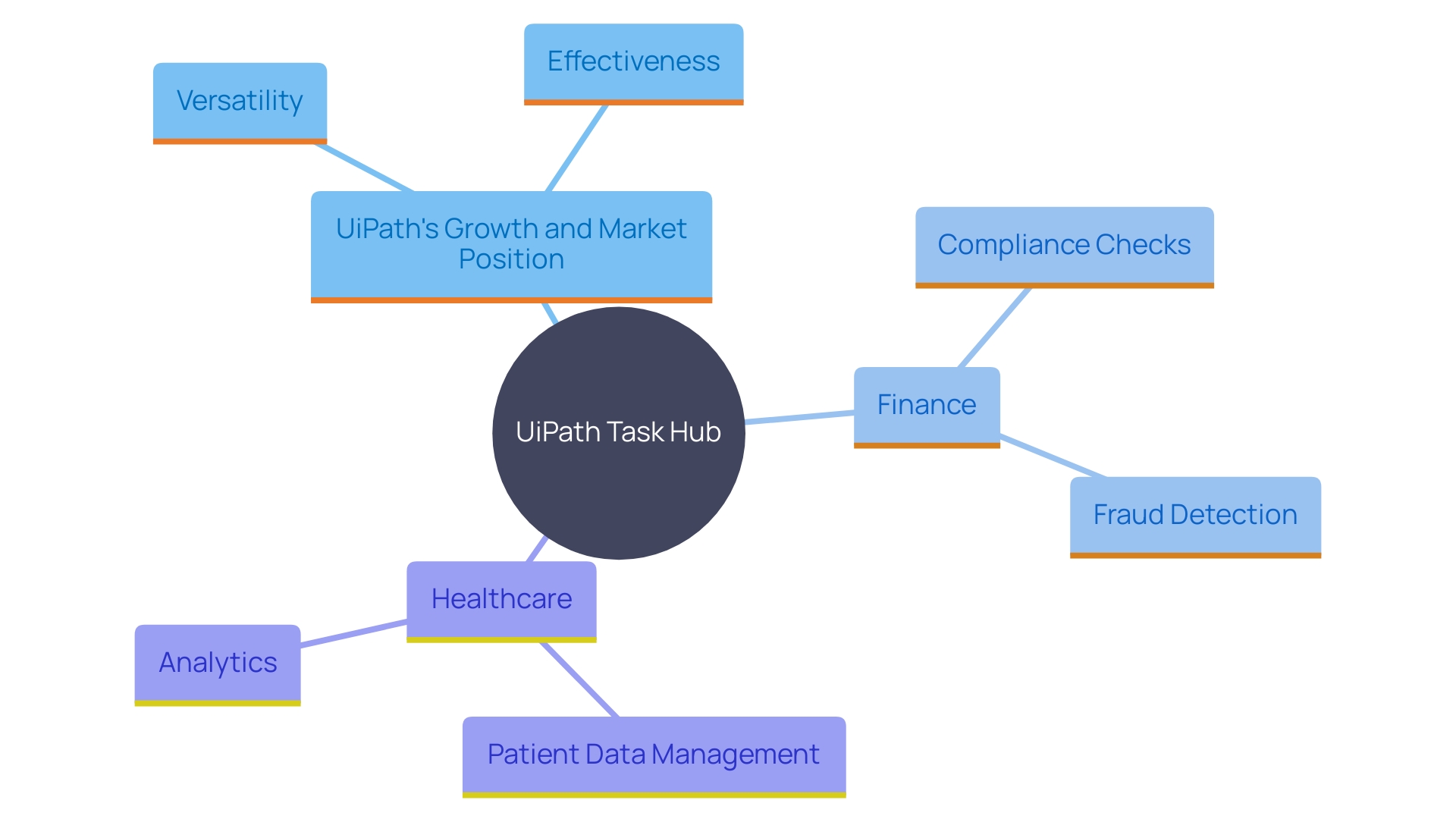
Best Practices for Action Center Implementation
To unlock the full potential of UiPath Task Hub, organizations should adhere to several best practices. Begin by meticulously identifying processes that necessitate human intervention and seamlessly integrating them into your automation workflows. Providing comprehensive training for users is crucial to ensure they are adept at navigating the Action Center interface and utilizing its functionalities effectively. Regularly assess and fine-tune task assignments based on performance metrics to maintain a balanced and efficient workload distribution. Additionally, fostering a culture of continuous feedback from users can lead to ongoing system improvements, directly addressing their evolving needs and enhancing overall productivity. By aligning the system’s capabilities with the specific tasks and goals of your workforce, you can significantly increase operational efficiency and effectiveness.
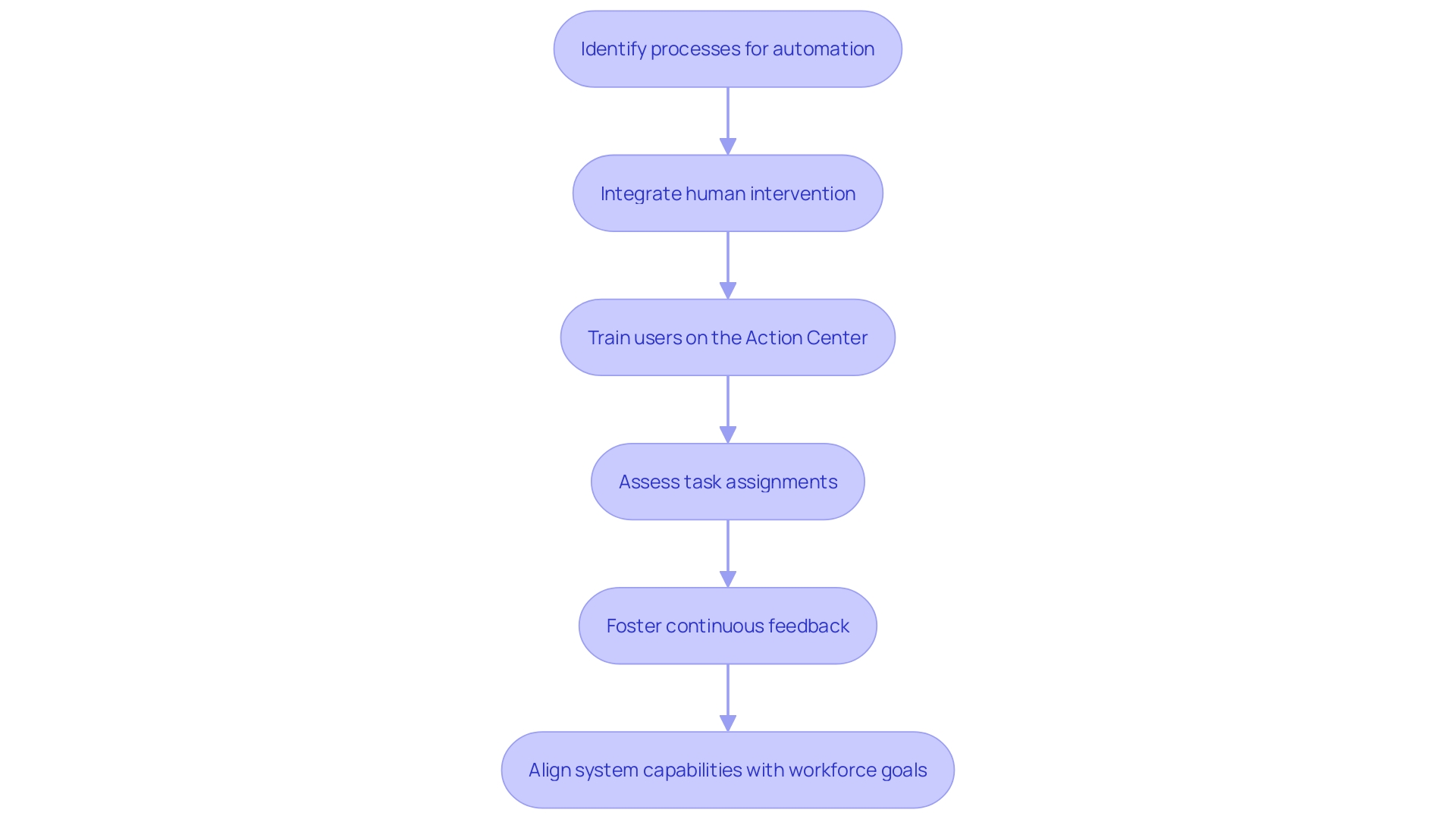
Conclusion
UiPath Action Center is essential for enhancing operational efficiency by effectively bridging automation and human involvement. With features like seamless task delegation and integration with UiPath Orchestrator, it enables organizations to manage human-in-the-loop processes efficiently. The intuitive interface ensures that critical tasks receive prompt attention, while its increasing adoption highlights its importance in streamlining complex workflows.
Incorporating human input into automation through UiPath Action Center reduces errors and enhances decision-making. This approach allows employees to focus on higher-value tasks, fostering job satisfaction and aligning with Industry 5.0 principles. The flexibility of the digital workforce ensures quality control and operational resilience, especially in dynamic market conditions.
Real-world applications in industries such as finance and healthcare demonstrate the tool’s versatility. Success stories reveal its effectiveness in improving compliance and data management, underscoring its significant impact on operational efficiency.
To fully leverage UiPath Action Center, organizations should adopt best practices, including integrating human intervention into workflows, offering comprehensive user training, and encouraging continuous feedback. By aligning the system’s capabilities with workforce needs, organizations can achieve optimal operational efficiency and position themselves for success in an increasingly automated landscape.
Introduction
In the rapidly evolving world of supply chain management, Robotic Process Automation (RPA) emerges as a game-changer, streamlining operations and driving efficiency to unprecedented levels. By automating repetitive and time-consuming tasks, RPA significantly reduces processing times and ensures higher accuracy, effectively minimizing errors in order processing and inventory management. The ability of RPA to operate around the clock without incurring additional labor costs allows organizations to handle peak periods effortlessly, leading to notable increases in throughput.
Importantly, RPA empowers human managers to focus on strategic initiatives, enhancing overall productivity.
Recent studies highlight the critical role of automation in logistics, with projections indicating that it will account for more than a third of capital spending. Companies like OnProcess exemplify the successful integration of RPA, leveraging automation, AI, and data-led decision-making to maintain visibility across the supply chain, from planning to asset recovery. However, the journey to successful RPA implementation is not without challenges.
Many automation projects fail due to a lack of cohesive vision and poor understanding of the technology. Implementing a robust strategy with clear design principles and future growth consideration is essential for harnessing the full potential of RPA in supply chain management.
Benefits of RPA in Supply Chain
Robotic Process Automation (RPA) transforms logistics management by optimizing operations and enhancing efficiency. Automating repetitive and time-consuming tasks drastically reduces processing times and ensures higher accuracy, minimizing errors in order processing and inventory management. The capability of RPA to function around the clock without additional labor costs allows organizations to handle peak periods effortlessly, leading to significant increases in throughput. Moreover, RPA’s role goes beyond simple task handling; it allows human managers to concentrate on strategic initiatives, improving overall productivity.
Recent research indicates that mechanization in logistics and fulfillment is expected to represent over a third of capital expenditures, highlighting its essential function in contemporary distribution networks. “Firms such as OnProcess, which focuses on reverse logistics and utilizes technology, AI, and data-driven decision-making, illustrate effective integration of RPA to ensure visibility from planning to asset recovery.”. As Melissa Twiningdavis, senior managing director of logistics operations at Accenture, notes, “The challenge is to drive cost efficiency while continuing to embed and accelerate resiliency.”. This is why we see the focus on supply chain operations as a vital source of competitive advantage.”
Despite its benefits, a significant portion of automation projects fail due to a lack of cohesive vision and a poor understanding of the technology. For instance, a consumer goods company faced challenges after investing more than $150 million in a fully automated warehouse due to inaccurate forecasts and misalignment between online deliveries and shipments to stores. Consequently, executing a strong plan with clear design rules and future expansion considerations is crucial for utilizing the full capability of RPA in logistics management.
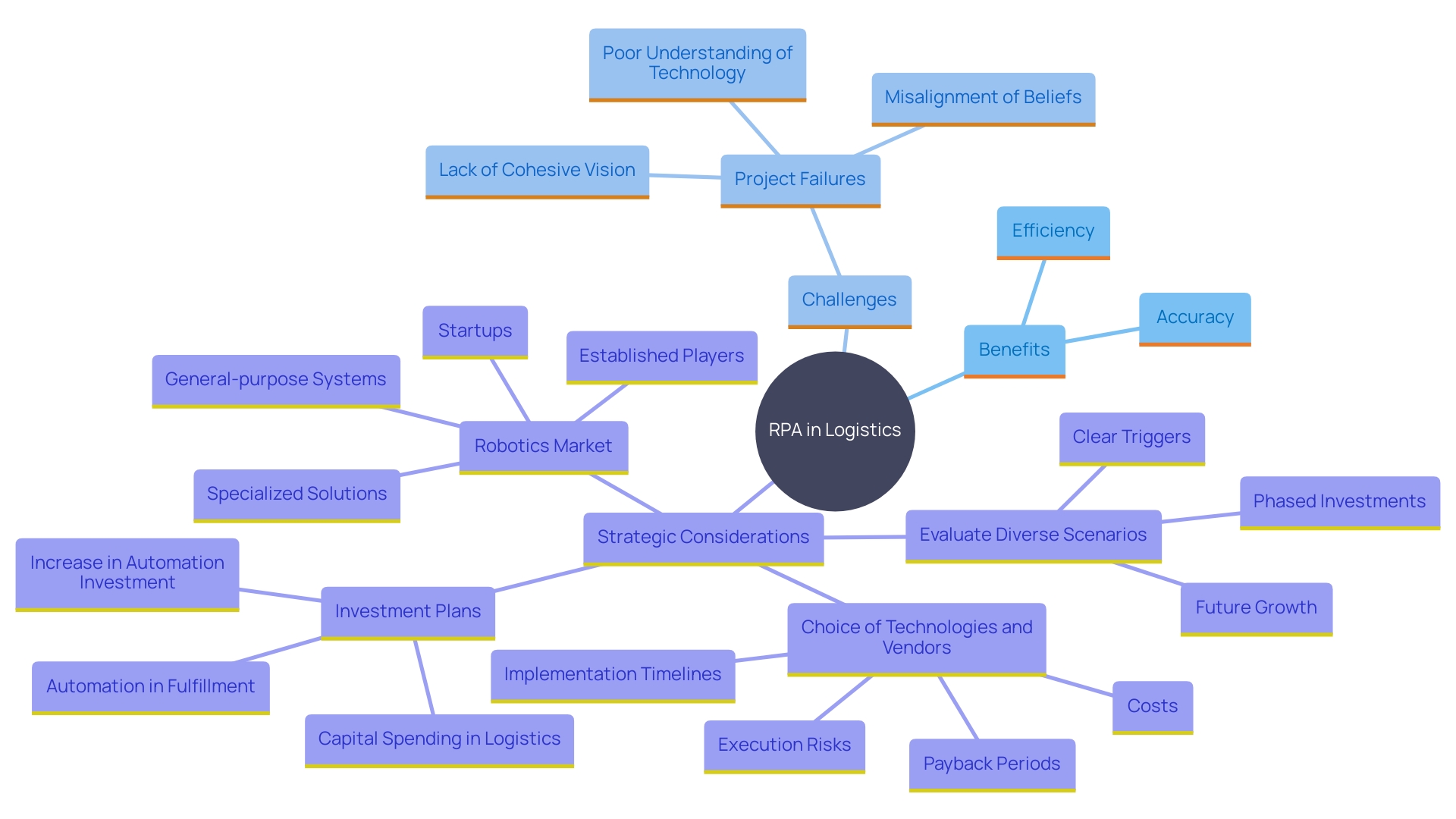
Key Applications of RPA in Supply Chain
Robotic Process Automation (RPA) can transform different logistical operations, greatly improving efficiency and precision. For instance, automating order processing, invoice management, and inventory checks helps streamline operations and reduce human error. Specific applications, such as supplier onboarding and automated customer service responses, improve the overall flow of information and customer satisfaction.
In a detailed case study, an organization leveraged a large language model (LLM) to create a consistent data taxonomy across decades of information. This enabled machine learning processes to identify similar components and make parts recommendations, optimizing order evaluation and inventory management. By integrating RPA and AI-driven solutions, they achieved faster order processing and more accurate assembly builds, cutting lead times and improving overall productivity.
Furthermore, organizations such as OnProcess are utilizing RPA to improve their logistics operations and customer experience while encouraging sustainability. Their expertise in reverse logistics and data-led decision-making ensures efficient planning and asset recovery. By integrating RPA with existing systems, organizations can eliminate bottlenecks, improve response times, and maintain a competitive edge in today’s dynamic market.
‘Melissa Twiningdavis, senior managing director of logistics operations at Accenture, emphasizes the significance of these advancements: ‘In recent years, logistics have emerged as one of the most crucial business functions on the CEO agenda.’. The challenge is to drive cost efficiency while continuing to embed and accelerate resiliency.’ This sentiment highlights the essential role of RPA in modernizing logistics and promoting sustainable growth.
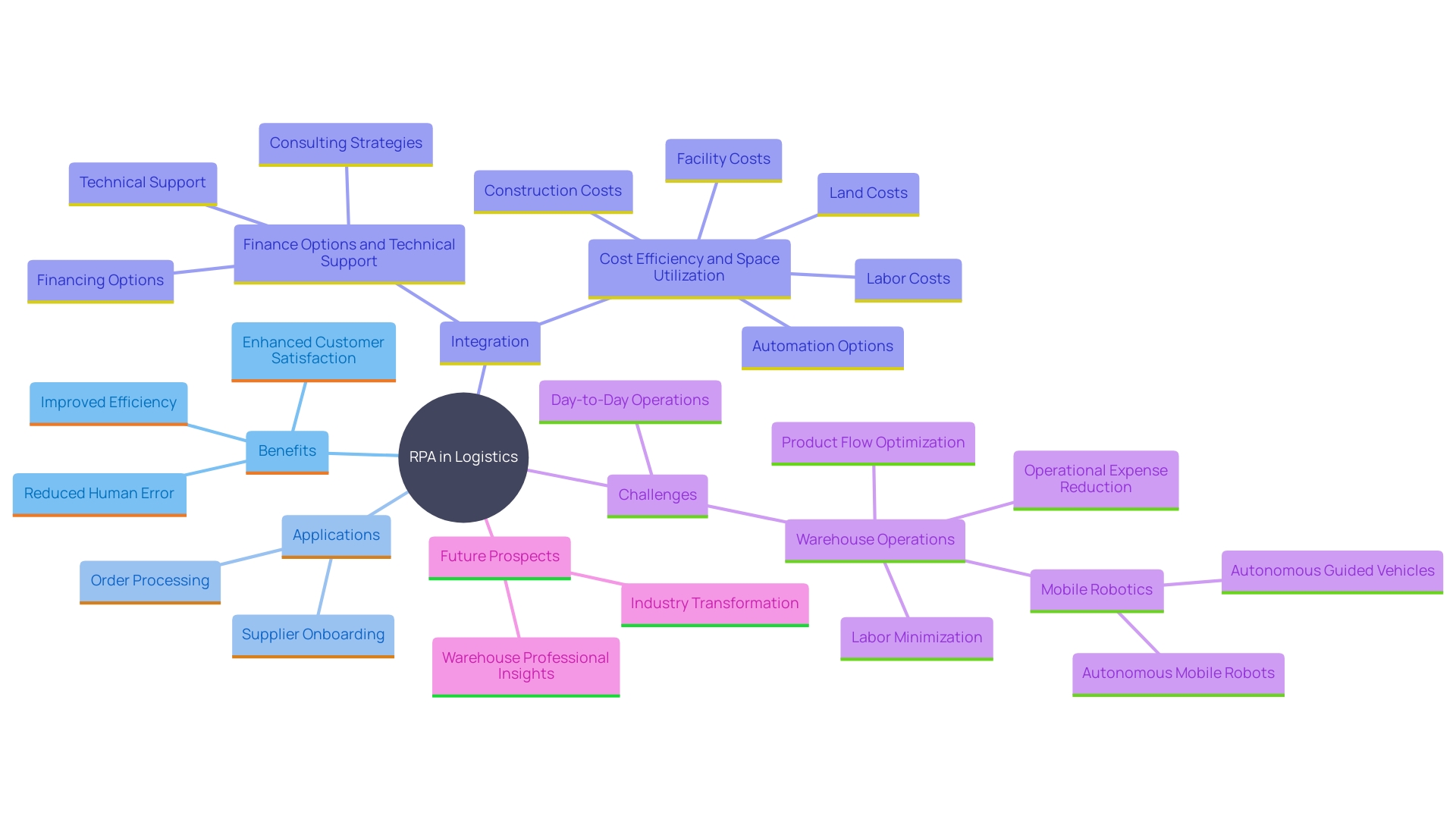
Best Practices for Implementing RPA in Supply Chain
Introducing RPA in the logistics network necessitates a strategic method beginning with a precise recognition of business requirements, including cost efficiency, service levels, and productivity. Engaging stakeholders across departments is paramount to ensure alignment and address potential resistance. Establishing guiding principles for technology selection is necessary to navigate the complexities of available tools. For instance, understanding the nuances of different RPA tools and evaluating vendors can make a significant difference.
Regular monitoring and continuous improvement of automated processes are crucial for maximizing the benefits of RPA. This ensures that the technology evolves alongside business demands. A lack of cohesive vision and poor understanding of technology for processes can lead to project failures, as evidenced by a consumer goods company that invested over $150 million in this technology but failed to achieve its goals due to inaccurate forecasts.
Furthermore, recent disruptions have underscored the significance of resilient networks. Companies are now utilizing technology to enhance speed, reliability, flexibility, and productivity. For instance, some are using intelligent workflows to orchestrate logistics processes, thereby minimizing human intervention. Automation in logistics and fulfillment is expected to account for more than a third of capital spending, underscoring its importance.
To address the challenges, companies should secure business-wide alignment on core beliefs and design principles. Establishing a cross-functional transformation office that includes key stakeholders from finance, operations, IT, and HR can govern the critical design principles and designate leaders for implementation. This approach ensures efficient use of resources, setting clear budget, timeline, and KPI targets.
Furthermore, evaluating diverse scenarios while allowing for future growth is essential. For instance, a larger initial investment in an AMR deployment might be beneficial if it allows for scalability. This staged funding strategy guarantees that automation expenditures stay in sync with organizational requirements over time, thereby offering a solid structure for the effective execution of RPA in the logistics network.
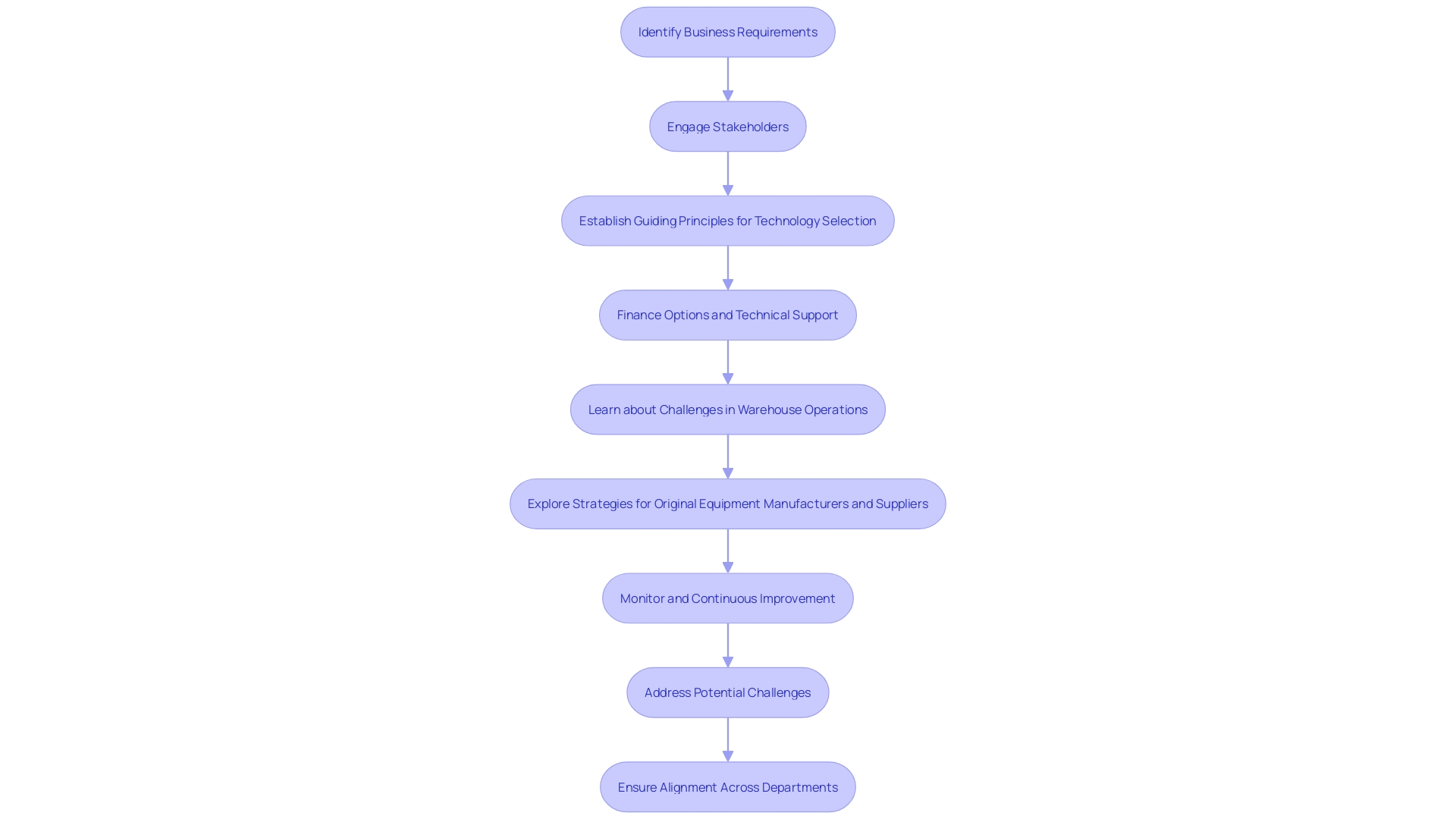
Future of RPA in Supply Chain Management
The future of RPA in logistics management is set for remarkable expansion, fueled by the rising acknowledgment of its revolutionary capabilities. As organizations lean into the capabilities of artificial intelligence and machine learning, RPA is set to evolve into a more sophisticated tool for smarter decision-making and predictive analytics.
Real-world examples, such as Renault’s digital transformation, underscore the tangible benefits of integrating RPA with emerging technologies. Since 2017, Renault has invested greatly in digital applications, culminating in the establishment of a comprehensive data lake that contains all logistical data. This foundation has allowed Renault to create a control tower for accurate oversight of resources, attaining an anticipated €45 million in digital value through AI-driven initiatives.
Additionally, the market for supply chain mechanization is expanding rapidly, with robot shipments anticipated to increase by up to 50% each year through 2030. Businesses are progressively concentrating on mechanization to improve the speed, reliability, flexibility, and productivity of their operations. This trend is evidenced by the growing investment in warehouse automation, which is anticipated to account for more than a third of capital spending in logistics and fulfillment sectors.
In this changing environment, cooperative networks enhanced by Industry 4.0 are becoming standard. Cloud-based platforms facilitate real-time communication and data sharing among stakeholders, ensuring seamless coordination from production to delivery. These innovations are not just theoretical; they are actively reshaping material handling processes, enabling companies to stay competitive in an ever-changing industry.
In conclusion, the integration of RPA with AI and machine learning is not just a future possibility but a present reality that is driving operational excellence and strategic growth in supply chain management.
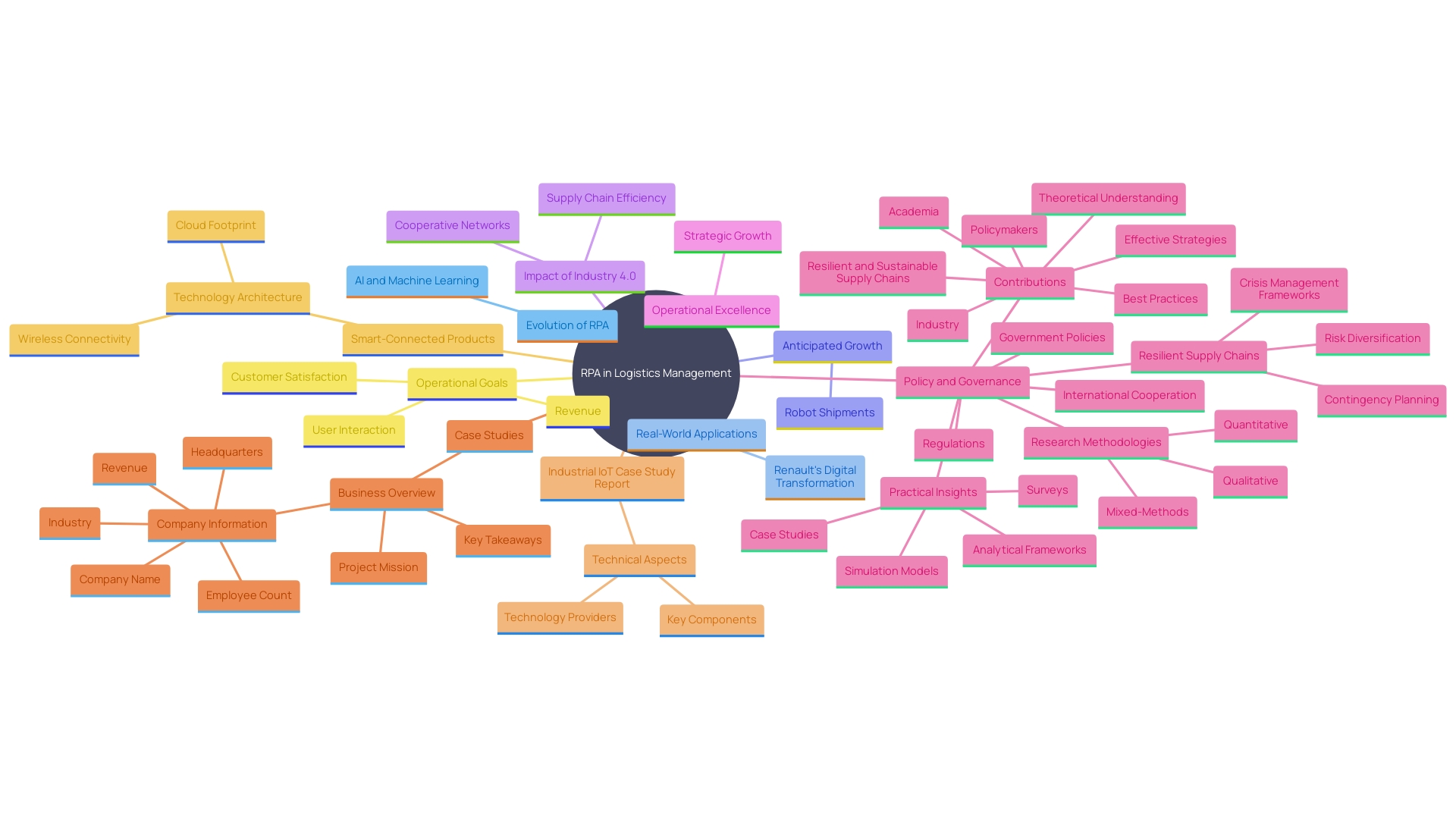
Conclusion
The transformative impact of Robotic Process Automation (RPA) on supply chain management is becoming increasingly evident. By automating repetitive tasks, RPA not only enhances operational efficiency but also significantly reduces processing times and minimizes errors. This capability allows organizations to manage peak demands more effectively and empowers human managers to concentrate on strategic initiatives, thereby boosting overall productivity.
As highlighted in various studies and real-world examples, the integration of RPA with AI and data-driven decision-making is crucial for achieving visibility and efficiency across the supply chain. Companies like OnProcess exemplify successful RPA implementation, demonstrating that a well-thought-out strategy can lead to remarkable improvements in logistics and fulfillment. However, the journey to effective automation is fraught with challenges, and a cohesive vision along with a deep understanding of technology is essential to avoid pitfalls.
Implementing RPA requires strategic planning, stakeholder engagement, and a commitment to continuous improvement. Establishing guiding principles and a cross-functional transformation office can facilitate alignment and governance throughout the process. Moreover, companies must remain agile, ready to adapt their automation strategies to meet evolving business needs and market conditions.
Looking ahead, the future of RPA in supply chain management is bright, with growth driven by advancements in AI and machine learning. Organizations that embrace these technologies will be better positioned to enhance their operational capabilities, ensuring they remain competitive in an increasingly complex landscape. By harnessing the full potential of RPA, companies can achieve not only operational excellence but also sustainable growth, paving the way for a more resilient supply chain ecosystem.
Introduction
The manufacturing landscape is undergoing a seismic shift with the advent of Industry 4.0 technologies. This new era of production, characterized by the seamless integration of digital technologies, heralds unprecedented efficiency, customization, and quality control. Since 2016, the concept has gained momentum, leading to groundbreaking advancements in automation, robotics, and IoT by 2019.
These innovations have paved the way for smart factories, where interconnected devices optimize resource management and enhance productivity. As the industry continues to evolve, the focus on data-driven and intelligent solutions promises to redefine manufacturing, enabling businesses to meet increasing demands with improved performance and higher margins.
Advancements in Industry 4.0 Technologies
Industry 4.0 represents a transformative phase in manufacturing, fueled by the incorporation of digital innovations into production processes. This revolution, highlighted since 2016 by Klaus Schwab of the World Economic Forum, has brought forth unprecedented efficiency, customization, and quality control in manufacturing. Advanced machinery equipped with IoT-powered sensors now enhances productivity, opening new dimensions in business operations.
In 2019, significant advancements in automation, robotics, and the Internet of Things (IoT) marked a pivotal year. These advancements enabled real-time data exchange, optimizing resource management and reducing operational costs. For instance, smart factories emerged, leveraging interconnected devices that seamlessly communicate to improve production efficiency. Companies like St. James have already realized higher production speeds and better margins by measuring ROI in terms of labor per case.
The potential of Industry 4.0 innovations to transform manufacturing processes is immense. With the advent of smart factories, businesses are achieving higher production speeds and better margins. Prominent producers are embracing these innovations to remain ahead of rising demands and enhance performance. As manufacturing continues to evolve, the focus on data-driven and intelligent concepts for control and visualization will shape the future of the industry.
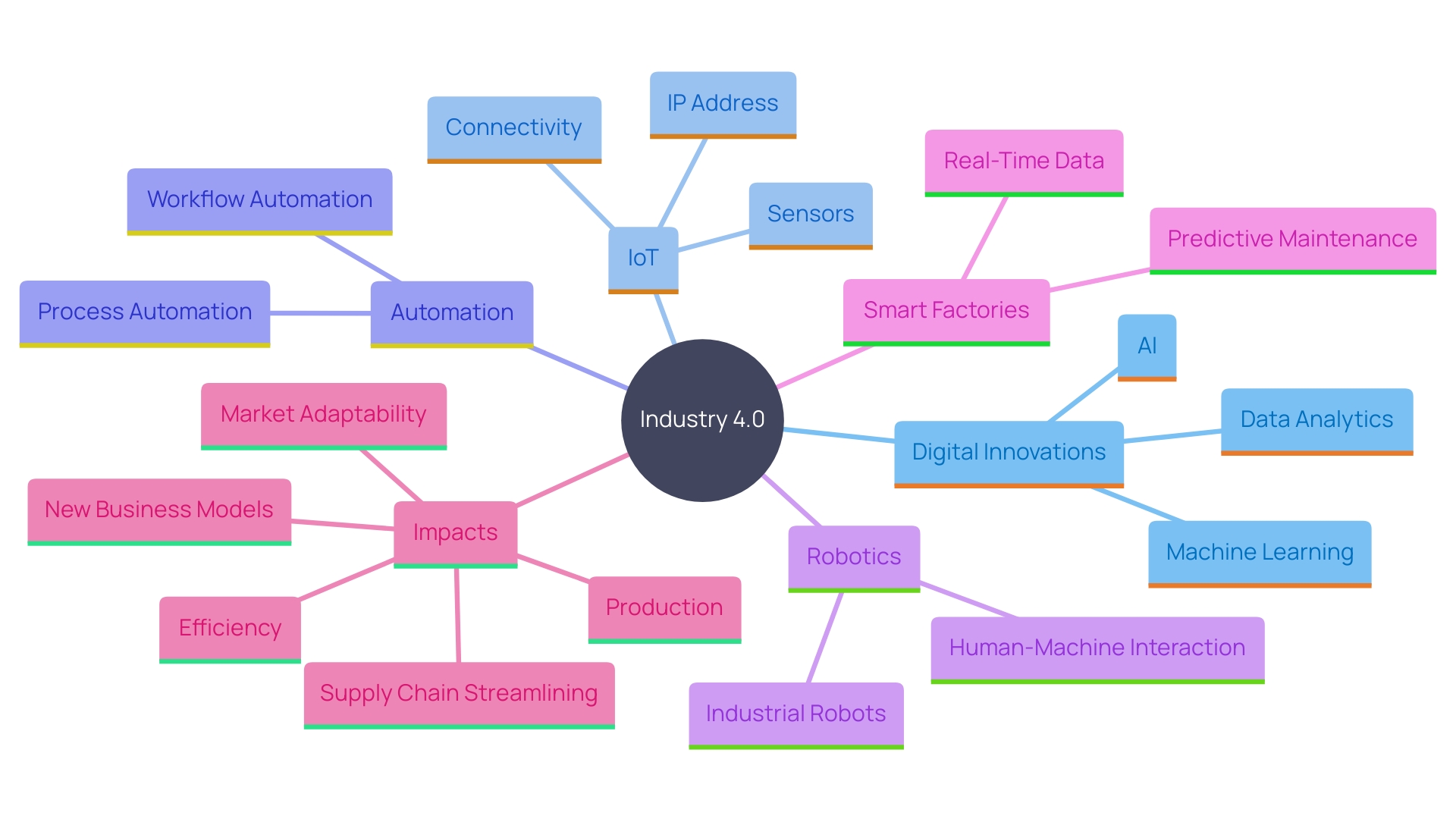
The Rise of Big Data Analytics and IoT in Supply Chain Management
‘Large-scale analytics and IoT are transforming supply chain management by offering improved visibility and greater understanding of operations.’. By 2019, businesses increasingly adopted these technologies to improve real-time tracking of inventory and shipments, which has become essential for effective supply chain management. This transition has enabled better forecasting, reduced delays, and a more responsive approach to market demands, fostering data-driven decision-making.
However, the implementation of IoT and large-scale analytics is not without its challenges. Organizations frequently encounter challenges in acquiring real-time information on asset locations and status, which is essential for making prompt and informed decisions. Data accuracy remains a significant hurdle, often leading to errors in inventory levels and causing stockouts or overstock situations. Moreover, integrating IoT devices with existing systems requires robust network infrastructure and reliable sensors, along with considerable upfront costs and ongoing maintenance.
Despite these obstacles, the results are transformative. The worldwide large information as a service market is anticipated to hit $474.9 billion by 2033, demonstrating the increasing dependence on information-driven solutions. “Companies are now utilizing IoT advancements to optimize various aspects of logistics, including real-time tracking and tracing, inventory management, warehouse operations, and predictive maintenance.”.
As noted by Ben Tucker from Digi, scalability remains a challenge, particularly as inventory sizes grow and span multiple locations worldwide. Additionally, security concerns, both data-related and physical, must be addressed to ensure the integrity and safety of supply chain operations.
In essence, while the journey to fully integrated IoT and big data analytics in supply chain management involves overcoming significant challenges, the potential for improved efficiency, responsiveness, and cost savings makes it a worthwhile endeavor.
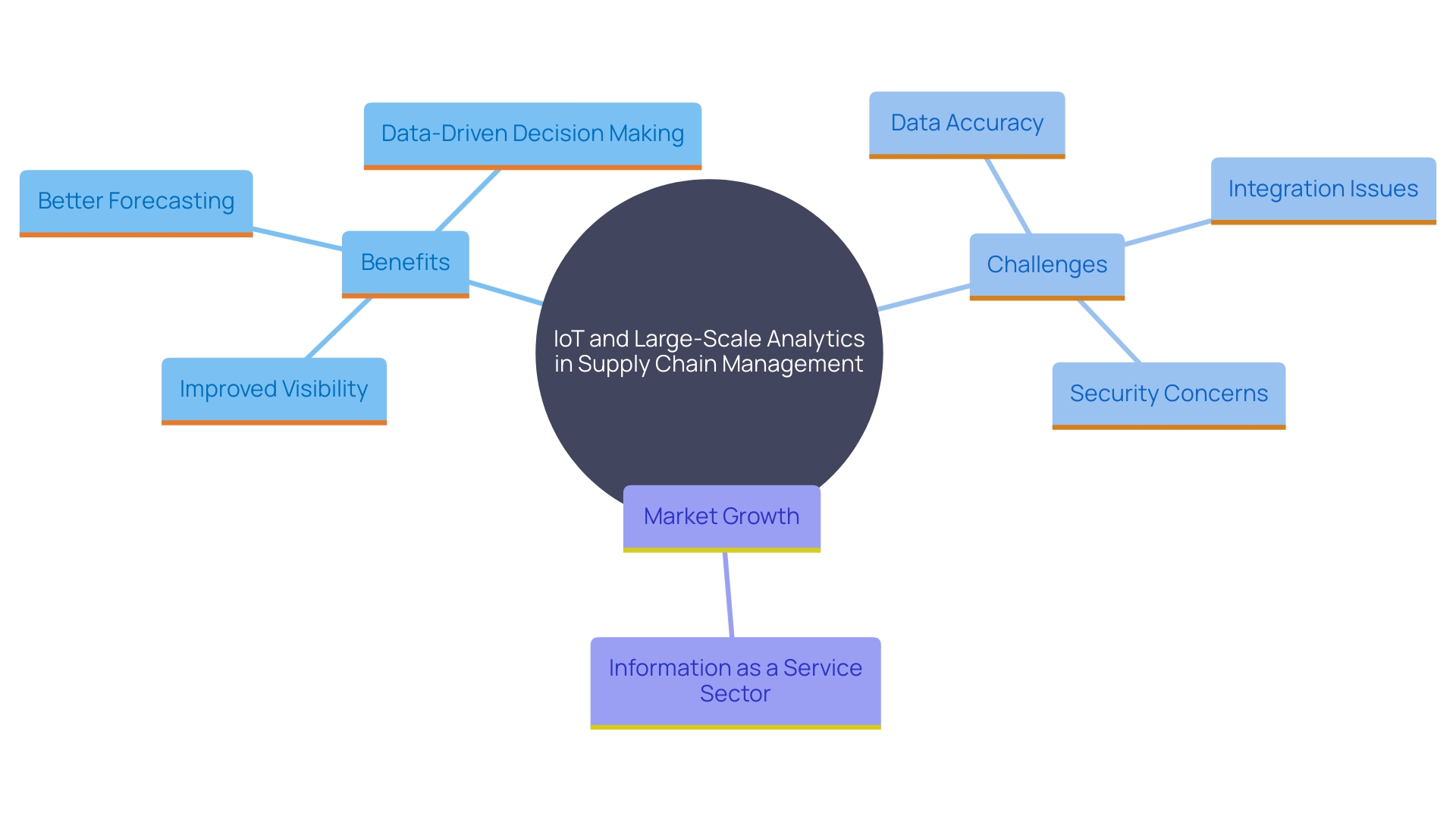
Emergence of Artificial Intelligence in Organizational Decision Making
Artificial Intelligence (AI) has significantly influenced decision-making processes since 2019, providing organizations with advanced tools to analyze extensive datasets swiftly and accurately. Machine learning algorithms, a core component of AI, facilitate predictive analytics, enabling businesses to forecast market trends and customer preferences effectively. This data-driven approach allows decision-makers to derive actionable insights, resulting in more informed and timely choices. The integration of AI in various industries, from supply chain management to risk assessment, demonstrates its versatility and potential for cross-sector applications. In financial services, for instance, AI has revolutionized fraud detection and prevention, safeguarding assets and enhancing customer trust. Similarly, in manufacturing, AI-driven systems have optimized production processes and boosted employee productivity, showcasing its transformative impact on operational efficiency. As AI continues to evolve, its role in ethical decision-making and human-AI collaboration becomes increasingly pivotal, ensuring that technology aligns with human values and enhances overall business success.
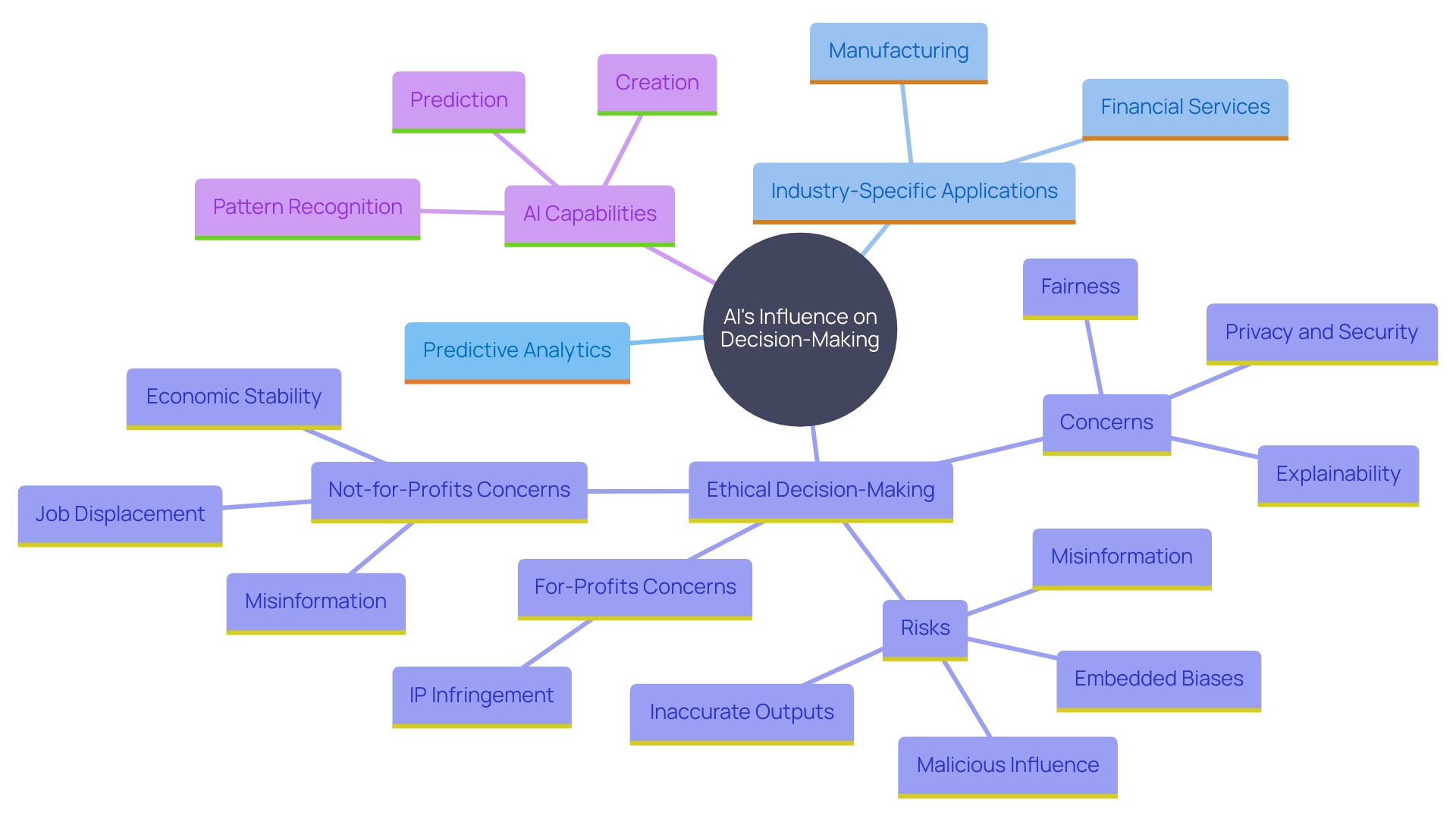
Digitalization and Globalization Trends
In 2019, digitalization continued to redefine industries, enhancing globalization and unlocking new market opportunities. Companies increasingly adopted online tools to expand their reach and engage with global customers, a trend underscored by the flourishing of e-commerce platforms. This technological transformation enabled small and medium enterprises to enter international markets with unprecedented ease.
For example, the UN Trade and Development initiative emphasizes how online economies can promote sustainable and inclusive development. Major organizations like the OECD and the G20 are actively exploring ways to harness e-commerce and the online economy for global growth. The online sector is a significant engine for economic growth and job creation, with the IT services sector expanding twice as quickly as the overall economy and generating jobs at six times the rate of the global economy.
However, the benefits of digitalization are not uniformly distributed. ‘While firms in high-income nations continue to incorporate technological solutions to streamline processes, many small and medium enterprises in low- and middle-income countries still lack basic technological infrastructure.’. For instance, from 2020 to 2022, the percentage of micro firms investing in technological solutions doubled, but it tripled for large firms. ‘East Asia has been a frontrunner, with the share of firms investing in technological solutions quadrupling during the same period.’.
Real-world examples like the transformation projects undertaken by companies such as Nets, which shifted from traditional training methods to online platforms, illustrate the profound impact of technological change. These efforts not only meet global and local market needs but also ensure compliance with international regulations.
As online strategies become essential for competitiveness, organizations must embrace these changes to thrive in a rapidly evolving landscape. The digital economy, through strategic initiatives and collaboration, promises a future where progress is inclusive and sustainable, ensuring no nation or community is left behind.
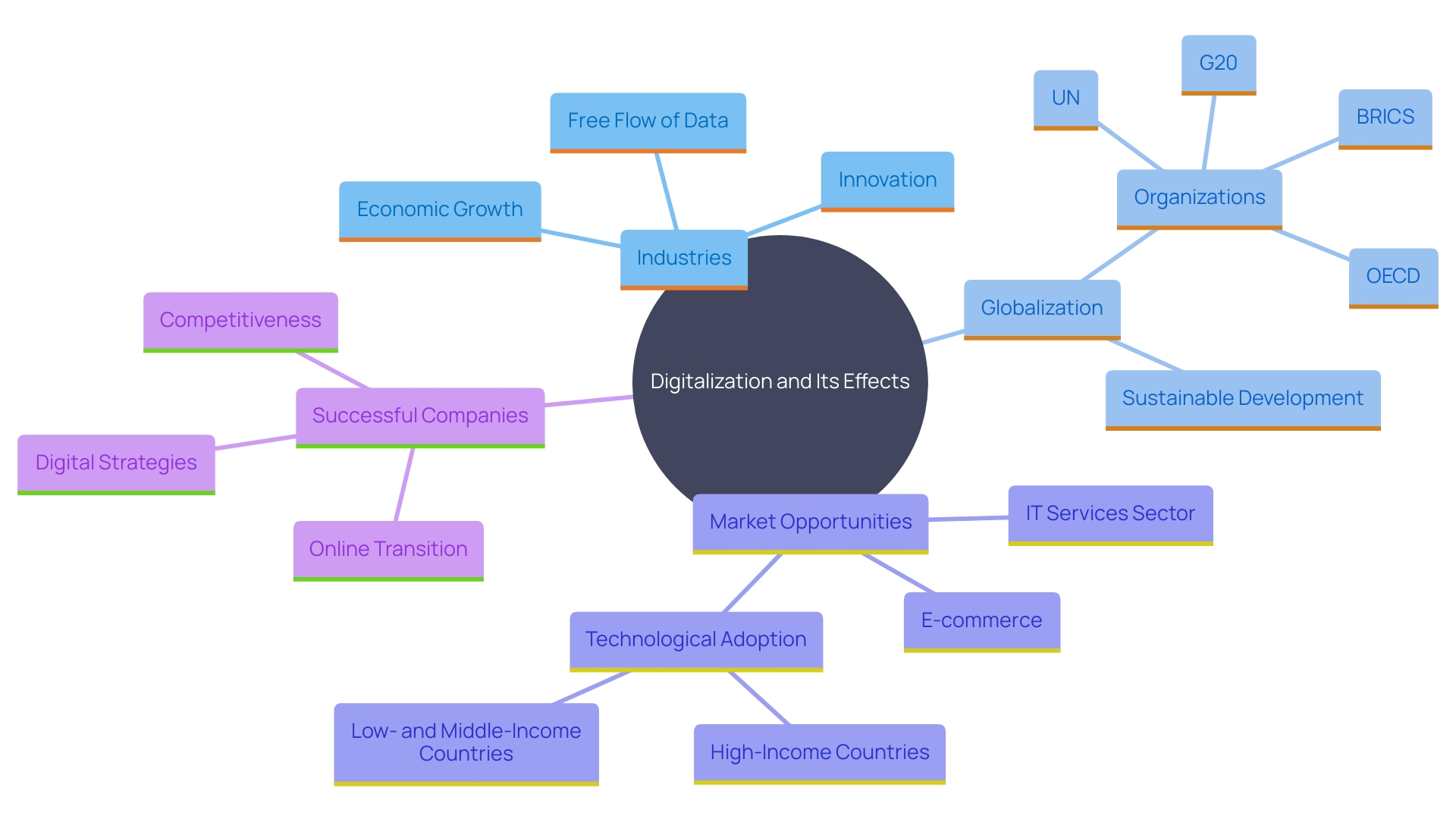
Conclusion
Advancements in Industry 4.0 technologies are revolutionizing manufacturing by enhancing efficiency, customization, and quality control. The integration of IoT, automation, and robotics has led to the rise of smart factories, optimizing production processes and enabling organizations to meet increasing market demands through data-driven decision-making.
Simultaneously, big data analytics and IoT are transforming supply chain management, offering improved visibility and insights. While challenges like data accuracy and infrastructure requirements persist, the potential for enhanced efficiency makes these technologies essential for agile operations.
Artificial Intelligence has also become a vital tool for decision-making, allowing organizations to analyze large datasets for informed choices. Its applications across various sectors demonstrate its capacity to boost operational efficiency and align technology with human values.
Digitalization further reshapes industries, unlocking new market opportunities. While benefits may not be evenly distributed, strategic initiatives can promote inclusive growth. Embracing digital tools is crucial for organizations striving to remain competitive in a rapidly evolving landscape.
In summary, the integration of Industry 4.0 technologies, big data analytics, AI, and digitalization provides organizations with pathways to enhance operations and achieve sustainable growth. By addressing challenges and leveraging these advancements, businesses can effectively navigate the complexities of modern manufacturing and position themselves for future success.
Introduction
In the dynamic landscape of modern business operations, Directors of Operations Efficiency are increasingly turning to Robotic Process Automation (RPA) to streamline workflows, enhance productivity, and drive sustainable growth. This comprehensive guide offers a step-by-step approach to successfully implementing RPA within an organization. From assessing automation opportunities and identifying suitable processes to building a compelling business case and selecting the right vendor, each phase is meticulously designed to maximize the impact of RPA.
Additionally, insights into managing the RPA lifecycle, change management, and overcoming common challenges provide practical solutions to ensure seamless integration and long-term success. Embrace these strategies to harness the full potential of RPA and transform operational efficiency.
Step 1: Assessing RPA Opportunities
Start by thoroughly analyzing your organization’s current processes to pinpoint where RPA can offer the most value. Focus on identifying repetitive, rule-based tasks that are time-consuming and resource-intensive. Interact with staff to acquire understanding of their everyday difficulties, ensuring a comprehensive perspective on possible opportunities for mechanization. A comprehensive analysis of the 300 largest companies by market capitalization showed that those implementing RPA observed a significant impact on their environmental, social, and governance (ESG) factors. The Total Economic Impact study by Forrester Research highlighted a $4.2 million improvement in employee experience and retention for companies using RPA. This highlights the significance of selecting the appropriate instruments and equipping the workforce for a seamless change, ultimately nurturing a culture of ongoing enhancement and optimizing the advantages of mechanization.
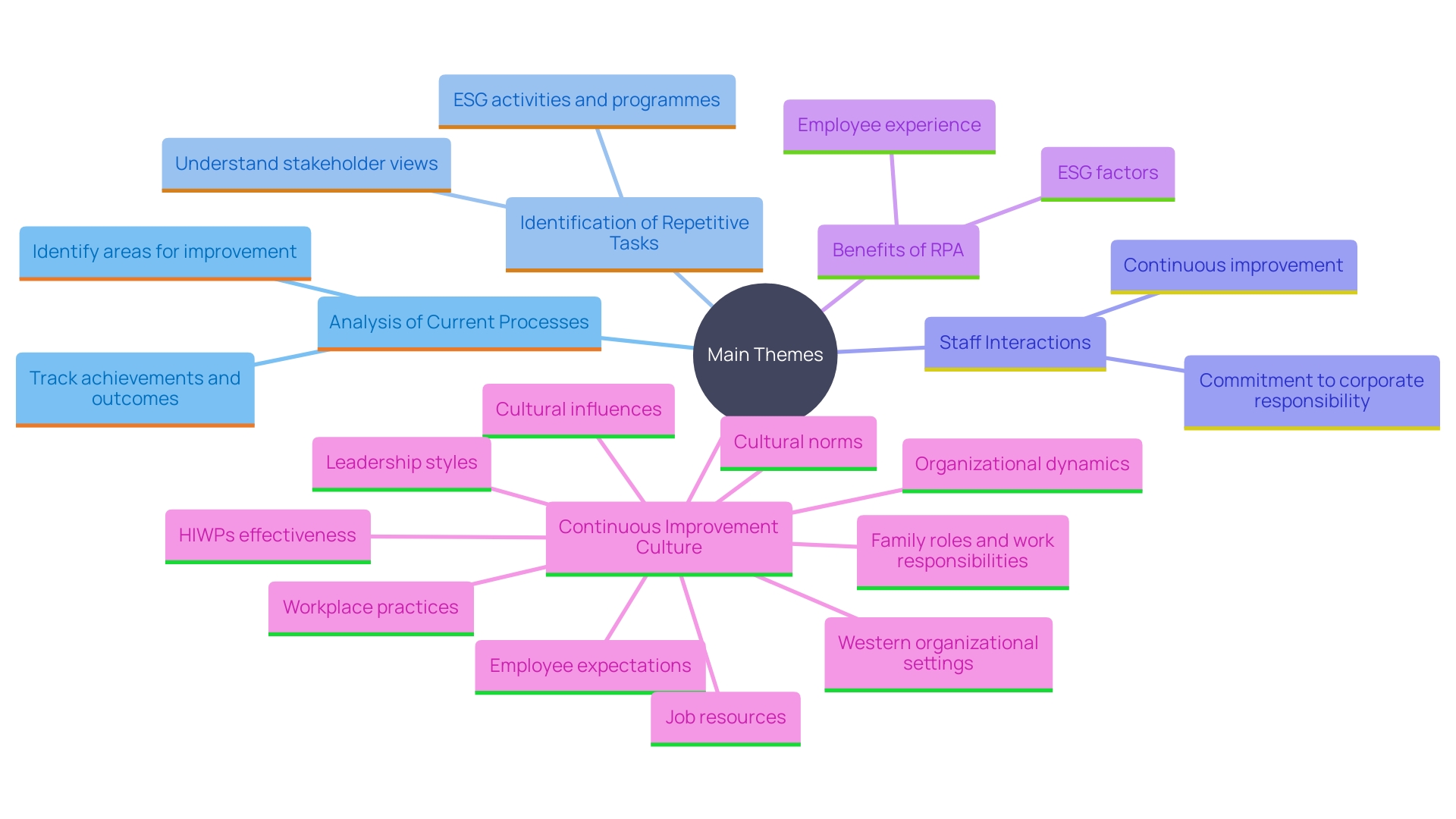
Step 2: Identifying Suitable Processes for Automation
‘Once opportunities are evaluated, prioritize methods that are the best fit for mechanization.’. Begin by evaluating criteria such as transaction volume, stability, and complexity. Simple, high-volume tasks are often prime candidates. Utilize tools like the Task Automation Index, which ranks tasks based on standardized input, well-defined rules, repetitiveness, data dependency, and objective outputs. This thorough ranking method guarantees that you concentrate on procedures that are not only appropriate for mechanization but also coincide with your organizational objectives.
For instance, when the finance division of Mass General Brigham hospital system encountered obstacles in monitoring healthcare providers, they reorganized their workflow for mechanization. By automating data collection and highlighting necessary actions, they significantly improved efficiency.
Additionally, always consider the resource allocation required for successful automation. Regular evaluations can identify inefficiencies and provide insights for enhancement. Gathering input from workers who engage with automated processes can reveal practical challenges and further improve efficiency. Aim to create a shortlist of methods that not only meet the technical criteria but also align strategically with your organizational goals.

Step 3: Building a Business Case and Defining Objectives
Developing a robust business case for Robotic Process Automation (RPA) is essential to outlining its potential benefits, such as cost savings, efficiency improvements, and error reduction. Start by selecting RPA and AI solutions that align with your specific needs and existing infrastructure. This alignment guarantees that the tools you invest in will integrate smoothly into your existing infrastructures and provide maximum value.
Next, clearly define measurable objectives and key performance indicators (KPIs) to track success. This could include metrics like the reduction in processing time, decrease in error rates, and cost savings. For example, RPA can perform repetitive tasks at a much faster pace than humans and work 24/7, eliminating the need for overtime pay or temporary staff during peak seasons.
Incorporate a continuous improvement approach, treating Hyperautomation as an ongoing journey. Continuously observe and enhance procedures to maximize the benefits, ensuring that the system evolves with your business needs. As emphasized in a recent Harvard Business Review article, companies like Shell are reengineering their supply chain, manufacturing, and maintenance methods with AI and RPA. This includes automating inspection processes using robots and drones.
Providing your team with the abilities and understanding to enhance the new technological frameworks is also essential. Upskilling employees prepares them for the transition and helps mitigate resistance to change. As emphasized by industry experts, automation has always required human partnership to ensure stability and effectiveness.
In summary, a well-defined business case with clear objectives, continuous improvement, and workforce readiness will guide your RPA project and secure stakeholder buy-in, ultimately leading to significant operational benefits.
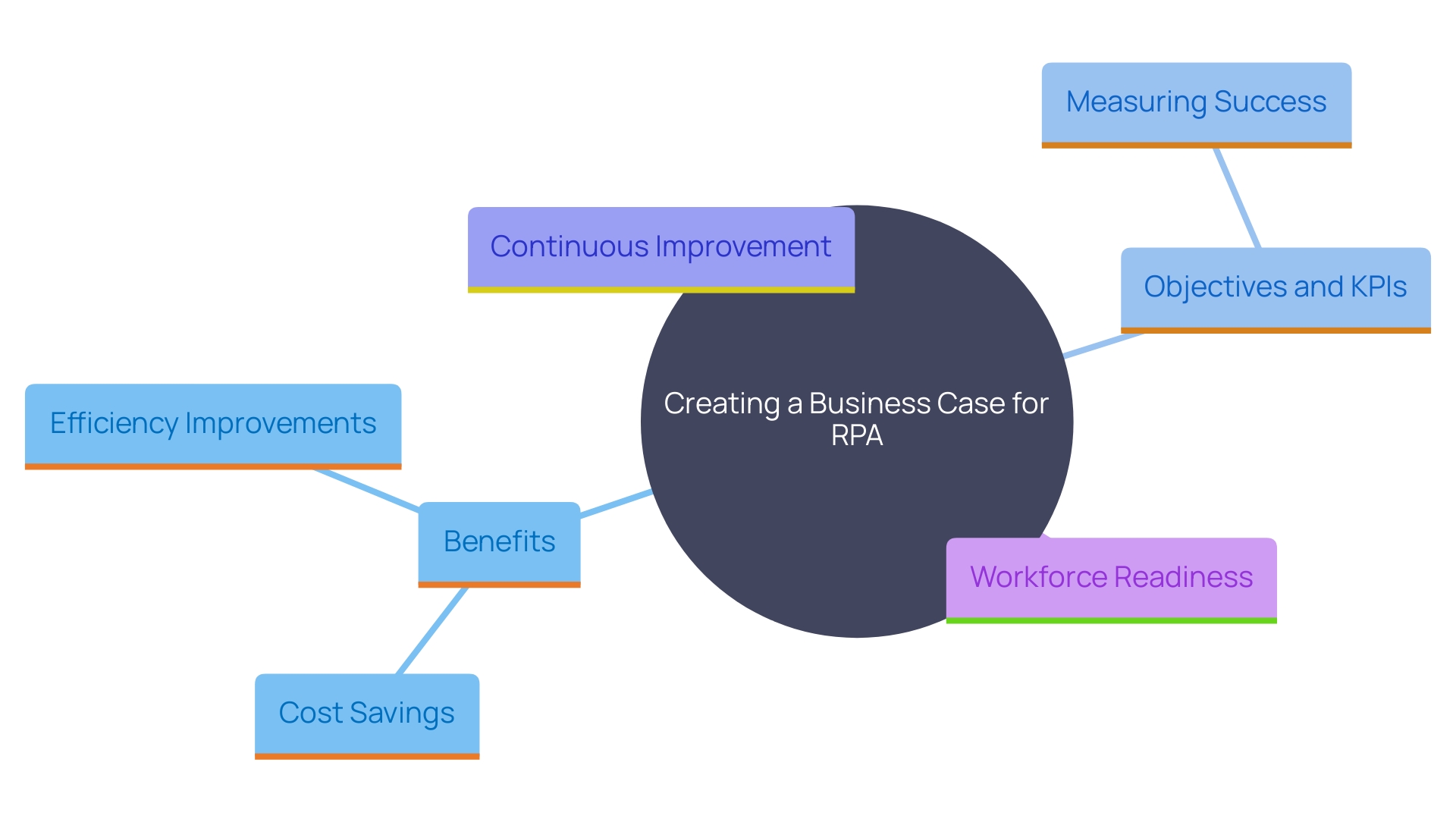
Step 4: Selecting the Right RPA Vendor
When researching and selecting an RPA vendor, it’s crucial to align their capabilities with your business needs. Consider scalability, user-friendliness, support services, and integration capabilities with existing systems. For example, Delivery Hero, operating in over 70 countries with 53,000 employees, faced significant challenges with employees being locked out of their accounts. By implementing an automated solution, they drastically reduced the time spent on account recovery, showcasing the importance of seamless integration and support.
Engage in demos and solicit feedback from other users to ensure the vendor’s solution meets your requirements. ‘Real-world success stories, like Delivery Hero’s, highlight the value of choosing a vendor that can provide robust support and smooth integration with existing systems.’. This approach will help you leverage RPA to its fullest potential, optimizing efficiency and productivity within your operations.
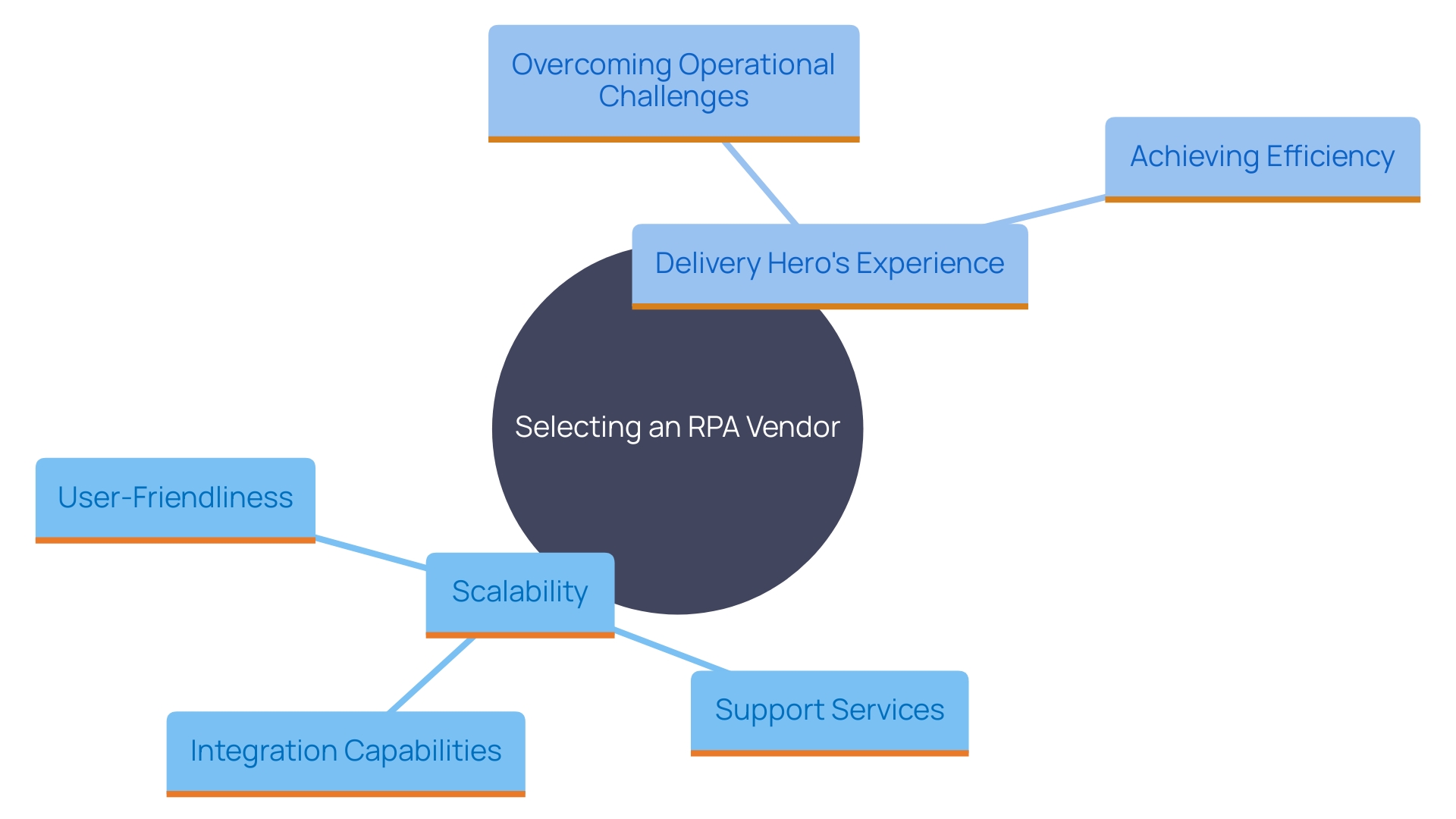
Step 5: Developing a Proof of Concept and Pilot Implementation
To effectively test your RPA solution, start by creating a proof of concept (PoC) in a controlled environment. Choose a method from your shortlist that is manageable yet representative of the larger implementation. For instance, Magic Valley Produce, a leading supplier of potatoes, faced challenges with labor shortages and limited floorspace in their palletizing area. By conducting a PoC, they identified that traditional industrial robots were impractical due to space constraints and safety requirements, while cobots lacked the necessary lifting power for their 52.5-pound boxes. This real-world example underscores the importance of a PoC in addressing unique operational challenges before full-scale deployment.
Monitor the results closely to refine your approach. For high-volume, repetitive processes, RPA can be the most cost-effective and efficient solution, as noted by industry experts. However, it requires continuous monitoring and management to ensure stability and effectiveness. The global sales of collaborative robots (cobots) reflect their growing importance, with sales doubling from 126 thousand units in 2020 to 242.03 thousand units in 2021. This trend highlights the increasing recognition of cobots’ benefits across various industries. By carefully analyzing the PoC outcomes, you can fine-tune your RPA implementation strategy, ensuring it aligns with your organization’s specific needs and goals.
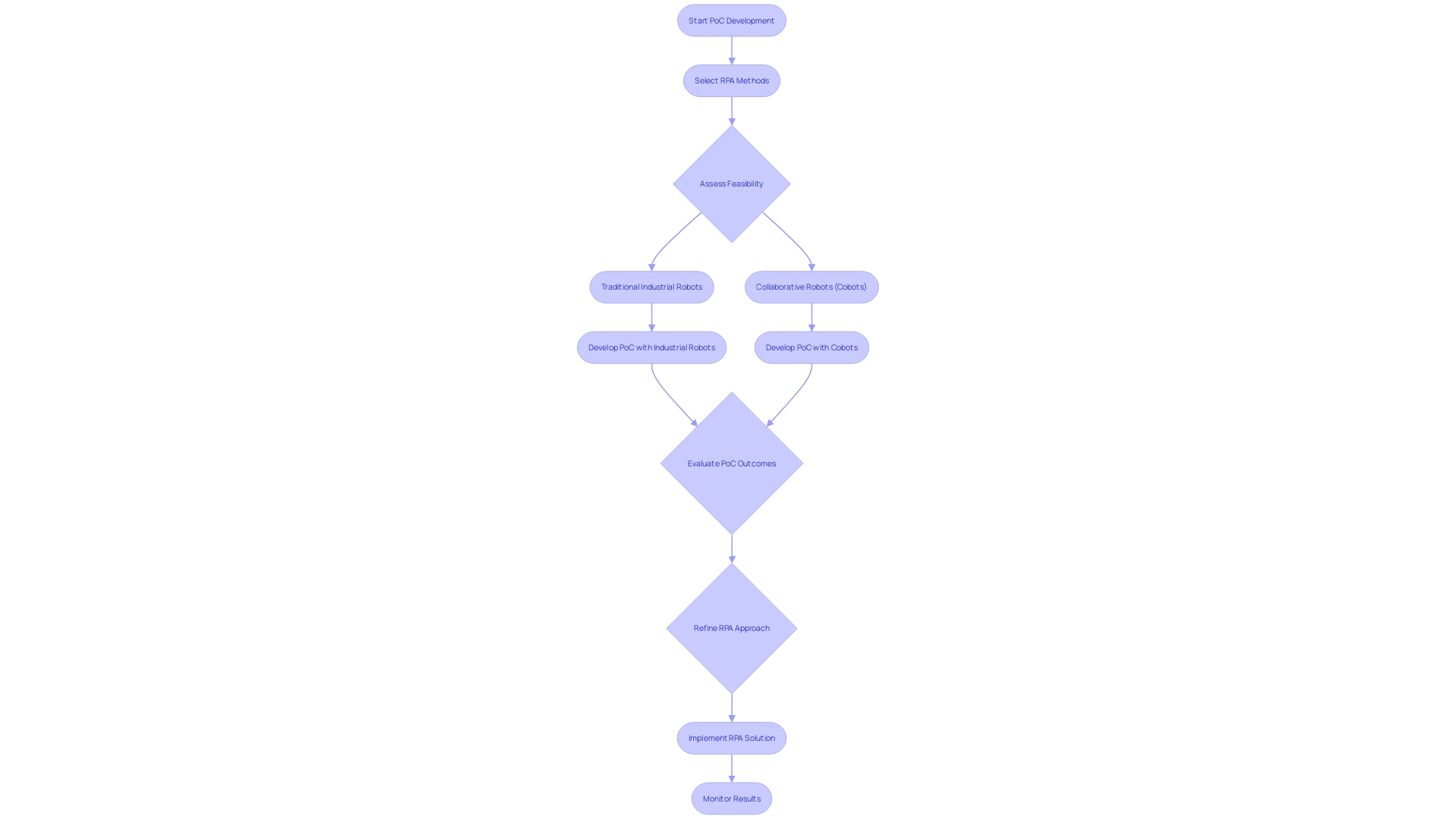
Step 6: Setting Up an Implementation Plan and Resource Organization
Creating a thorough execution strategy is essential for the success of any mechanization effort. Start by outlining clear timelines, resource allocation, and defining roles and responsibilities for all involved parties. This structured approach ensures that every stakeholder is informed and aligned with the project’s goals.
To illustrate, the finance department at Mass General Brigham hospital faced a bottleneck in tracking healthcare providers. By creating a dedicated team focused on automated processes that collaborated closely with the finance department, they restructured workflows and developed a mechanized tool. This tool significantly improved the efficiency of data collection and organization, showcasing the importance of collaborative efforts and clearly defined roles.
Moreover, establishing a robust governance structure is essential to oversee the implementation process and address any challenges. This is particularly relevant in sectors like healthcare, where the integration of automation must comply with strict regulations and standards. A well-defined governance framework ensures that the project remains on track and any issues are promptly addressed.
In the context of technological advancements, companies like 1X Technologies are pioneering new models to train robotics systems more efficiently. Their approach highlights the importance of continuous innovation and adaptation in the implementation process. By leveraging raw sensor data from robots, 1X Technologies has bridged the gap between simulation and real-world application, underscoring the need for dynamic and responsive governance structures.
Statistics further support the increasing significance of mechanization. For instance, the global sales of collaborative robots have seen a significant rise, from 60.9 thousand units in 2018 to an estimated 242.03 thousand units in 2021. This trend suggests an increasing acknowledgment of the advantages of mechanization across diverse sectors, highlighting the necessity for well-structured and carried out execution plans.
Integrating these components into your execution strategy will not only simplify the process but also improve overall effectiveness, guaranteeing that your organization gains the maximum advantages of mechanization.
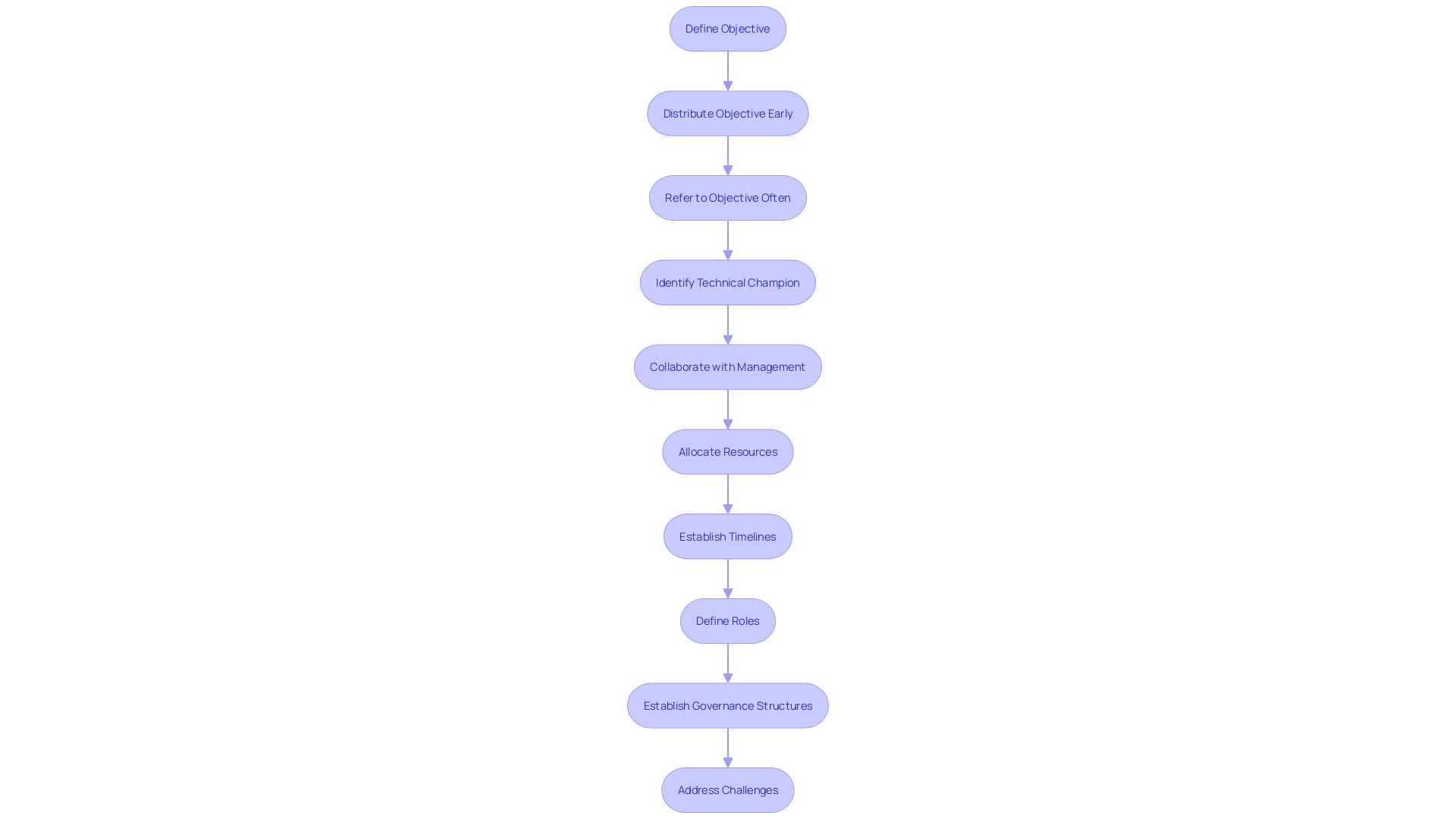
Step 7: Managing the RPA Lifecycle and Change Management
Managing the RPA lifecycle effectively requires a structured approach, starting from development and extending through maintenance. A noteworthy example is the finance department at the Mass General Brigham hospital system in Boston. Confronting inefficiencies in monitoring healthcare providers, they established a team focused on technology that worked with finance specialists to reorganize workflows, ultimately creating a tool that simplified data collection and organization. This not only alleviated bottlenecks but also enabled front-line employees to focus on higher-value tasks.
Change management strategies are crucial to easing transitions for employees. According to Dieter Kern, Cindy Zhong, and Lukas David Hoffmann, combining new technologies with proven methods can significantly mitigate change fatigue and enhance the effectiveness of change management programs. This is particularly important as organizations navigate evolving customer needs, technological advancements, and competitive pressures.
Training and support play a pivotal role in encouraging acceptance and engagement with new RPA processes. The achievement of the Mass General Brigham hospital network demonstrates the significance of providing staff with the essential abilities and understanding to enhance mechanized processes. This approach aligns with the insights from UiPath’s global survey, which emphasizes the need for continuous learning and adaptation in the automation journey. By investing in the right tools and fostering a culture of continuous improvement, organizations can unlock the full potential of RPA and drive operational efficiency.
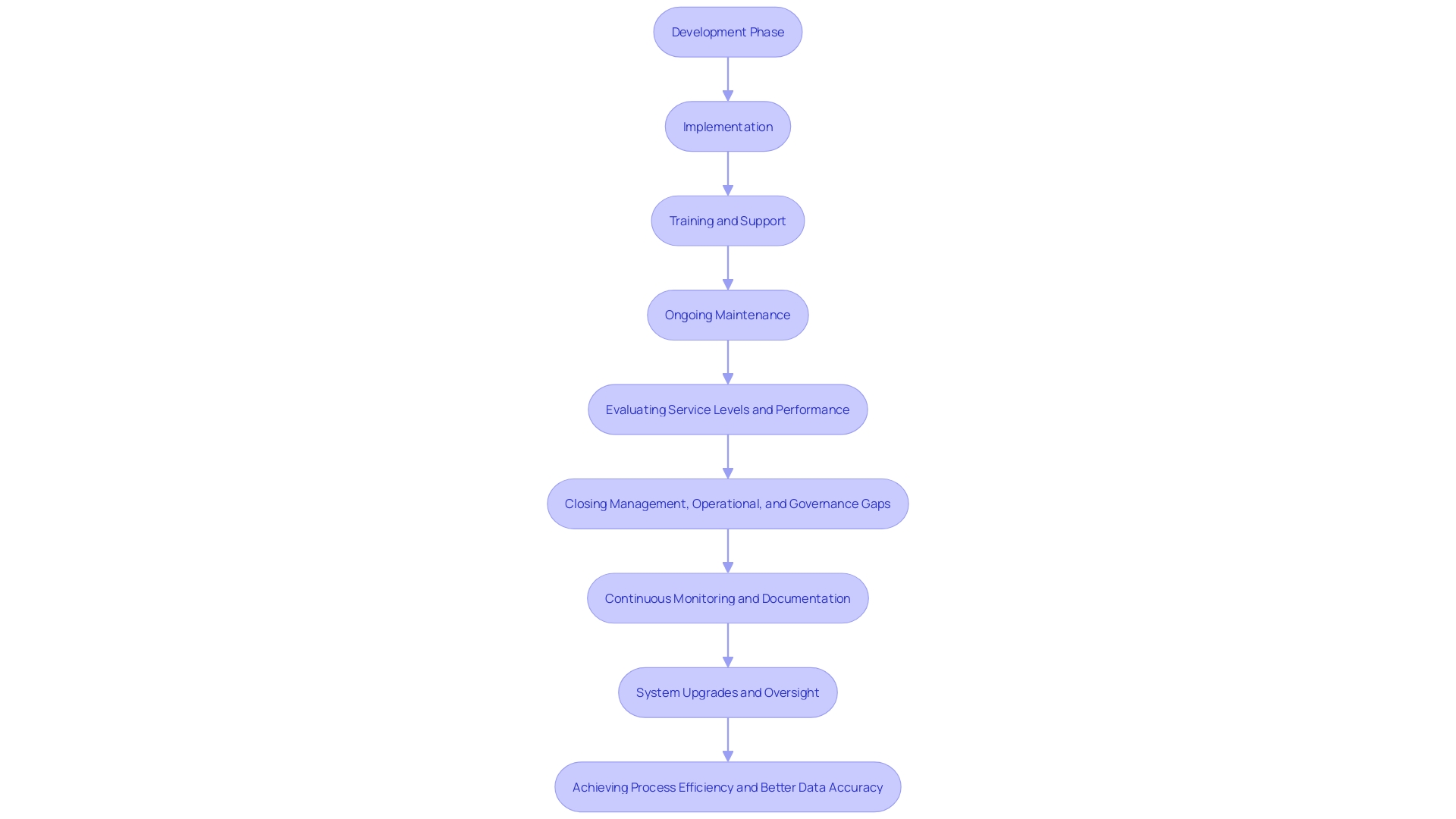
Key Considerations for Successful RPA Implementation
Monitoring compliance, security, and data management is crucial during RPA implementation. Take M&T Bank, for example, which faced stringent regulatory requirements due to the highly sensitive data involved in banking transactions. They addressed this by establishing organization-wide Clean Code standards to maintain software quality and compliance. Similarly, regular strategy reviews and adjustments are necessary to adapt to changing business needs. The experience of HUD during the government shutdown highlights the importance of agility. Within 90 days, they deployed a UiPath bot to automate housing contract expirations, demonstrating the need for continuous improvement and stakeholder validation. As reiterated by industry specialists, “You can automate, but you still have to engage.” This continuous involvement guarantees your RPA solutions provide the best ROI while adapting to your organization’s needs.

Common Challenges and How to Overcome Them
Anticipate challenges such as resistance to change, integration issues, and scalability concerns. Address these proactively by fostering a culture of collaboration and transparency. Engage stakeholders early and provide continuous support to mitigate resistance and facilitate a smoother transition. For example, the finance department of Mass General Brigham hospital system faced significant bottlenecks in managing provider data. By forming a dedicated automation group and engaging a specialist in workflows, they reorganized procedures and created a tool that streamlined data collection and organization. This approach not only alleviated the burden on front-line employees but also allowed for scalability to manage future growth. Additionally, effective communication channels and regular updates ensure that team members understand their roles and responsibilities, paving the way for successful implementation. Embracing a structured approach to organizational change management, which involves preparation, implementation, and follow-through, can further enhance the transition process and maximize the benefits of the change.
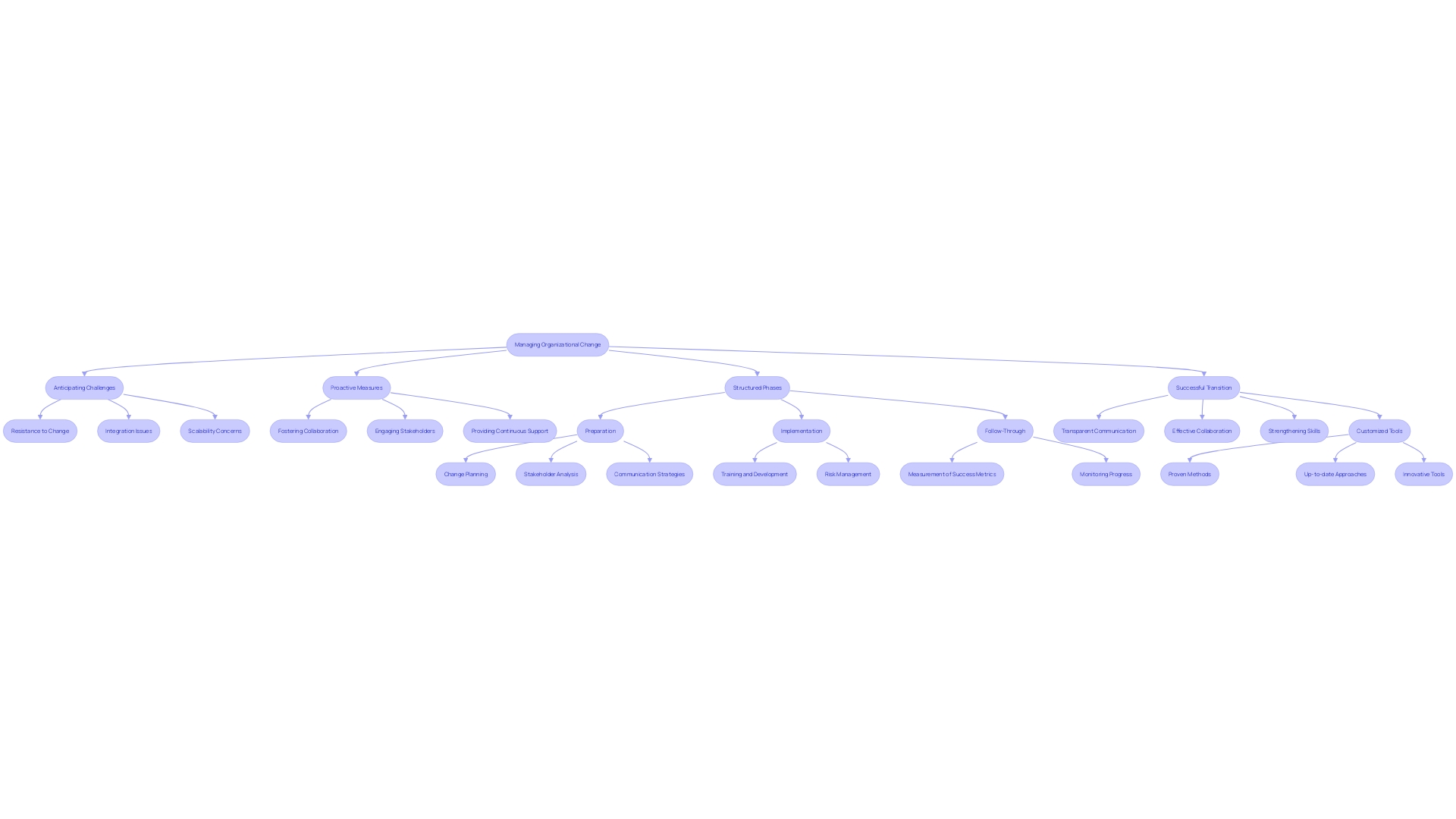
Conclusion
The implementation of Robotic Process Automation (RPA) presents a transformative opportunity for organizations aiming to enhance operational efficiency. By assessing RPA opportunities, identifying suitable processes, and building a solid business case, organizations can lay a strong foundation for successful automation initiatives. Engaging employees and utilizing tools like the Task Automation Index ensures that the right processes are prioritized, aligning automation efforts with strategic goals.
Selecting the right RPA vendor is equally crucial, as it determines the scalability and integration capabilities of the solution. A well-planned proof of concept and pilot implementation can identify potential challenges early, allowing for adjustments before full-scale deployment. Establishing a comprehensive implementation plan with clearly defined roles and responsibilities enhances collaboration, ensuring that all stakeholders are aligned and informed throughout the process.
Managing the RPA lifecycle effectively requires ongoing change management strategies to support employees during transitions. Continuous training and support foster a culture of acceptance and engagement, ultimately unlocking the full potential of automation. Monitoring compliance and addressing common challenges such as resistance to change and integration issues are essential for maximizing the return on investment.
In summary, harnessing RPA’s capabilities requires a structured and proactive approach, emphasizing collaboration, continuous improvement, and adaptability. By embracing these strategies, organizations can navigate the complexities of automation and achieve significant operational benefits, driving sustainable growth and enhanced productivity.
Introduction
Optical Character Recognition (OCR) and Intelligent Character Recognition (ICR) technologies are revolutionizing the way organizations handle text and data. OCR transforms printed and handwritten text from documents, images, and videos into digitally editable and searchable data, significantly reducing manual data entry and enhancing data accessibility. This technology is vital in modern document management, offering solutions such as reading product identifiers on assembly lines and digitizing entire books.
ICR takes this a step further by focusing on handwritten or cursive text, leveraging machine learning models to adapt to different handwriting styles, thus enhancing accuracy. This advancement opens up broader applications, especially in sectors like finance and healthcare, where automated data capture is crucial. The integration of ICR with natural language processing and machine learning by leading companies further boosts its performance and versatility, providing substantial business advantages.
The distinctions between OCR and ICR highlight their respective strengths: OCR excels in recognizing printed text, making it ideal for digitizing books and documents, while ICR is tailored for handwritten text, improving its accuracy over time with advanced machine learning techniques. These technologies streamline data entry and retrieval processes, transforming operations to meet modern demands for speed, precision, and security. As industries continue to adopt OCR and ICR, the benefits of enhanced productivity, reduced errors, and improved operational efficiency become increasingly evident.
What is Optical Character Recognition (OCR)?
Optical Character Recognition (OCR) is a transformative technology that converts both handwritten and typed content from various sources, such as scanned documents, PDFs, images, and videos, into digitally editable and searchable data. The process starts with image gathering, where a scanner captures the content and converts it into a black-and-white image. This image undergoes preprocessing to enhance its quality by removing digital noise, aligning characters, and improving contrast.
Next, the OCR software analyzes the preprocessed image using advanced algorithms like pattern recognition and feature extraction. Pattern recognition compares visual representations character by character against a database of known characters, while feature extraction focuses on identifying key features of the characters. Optical Word Recognition, a variation of OCR, identifies whole words instead of individual characters, which is particularly useful for stylized writing.
OCR methods are widely employed in diverse applications, ranging from reading product identifiers on assembly lines to digitizing entire books. It significantly reduces manual data entry and enhances data accessibility, making it a vital component in modern document management and productivity enhancement. The system’s adaptability includes identifying logos, watermarks, and symbols using Optical Mark Recognition and converting handwritten characters with Intelligent Character Recognition, which utilizes machine learning to enhance precision gradually.
By automating these processes, OCR streamlines data entry and retrieval, allowing organizations to focus on more strategic tasks. This not only boosts operational efficiency but also ensures that critical information is readily accessible and actionable.
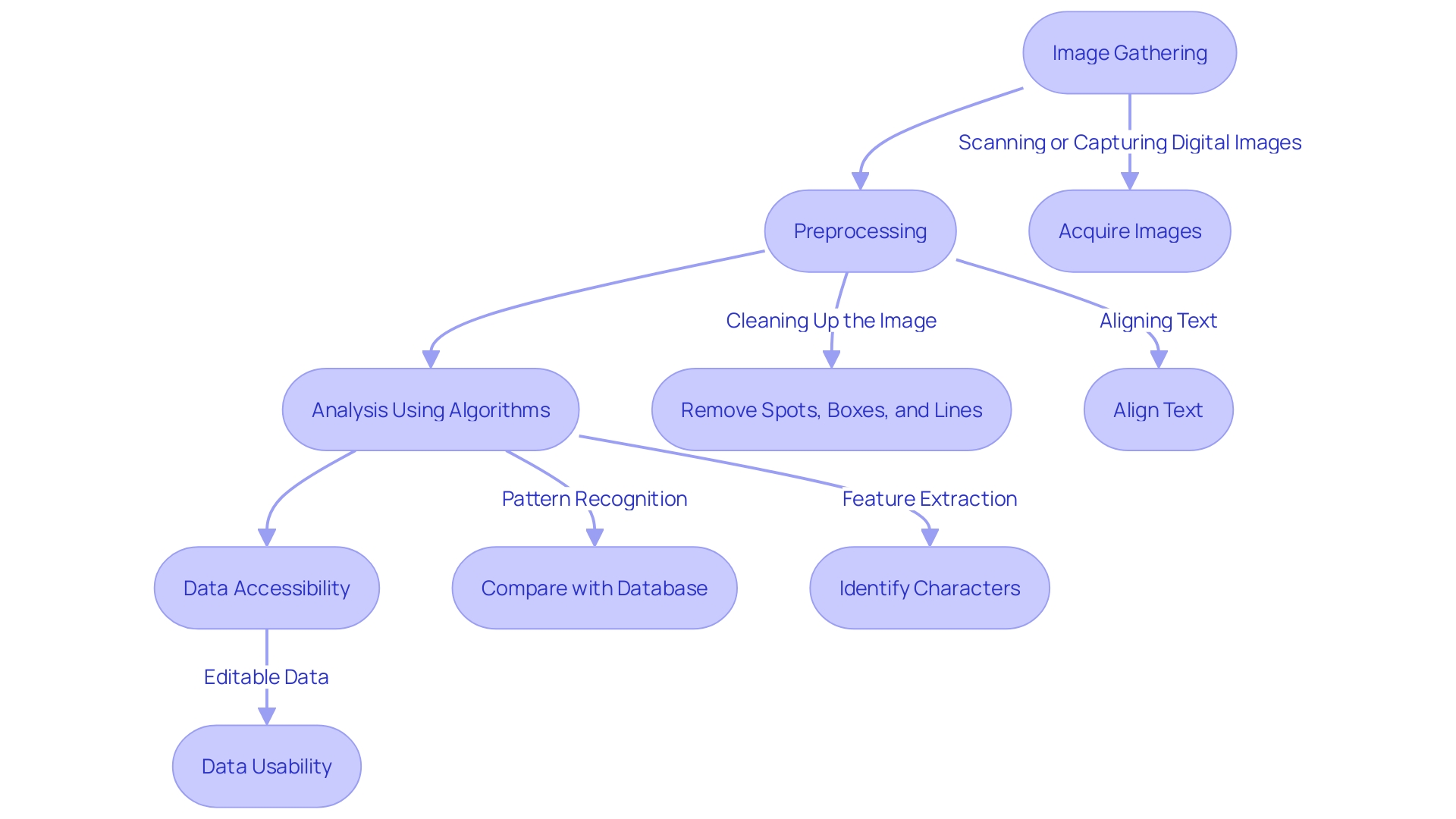
What is Intelligent Character Recognition (ICR)?
Intelligent Character Recognition (ICR) enhances traditional OCR by focusing on the identification of handwritten or cursive writing. Unlike OCR, which excels in interpreting printed characters, ICR leverages advanced machine learning models to adapt to different handwriting styles, significantly enhancing accuracy. This capability opens up broader applications for automated data capture, making it particularly valuable in sectors like finance and healthcare. For example, at Gusto, the integration of OCR technology has streamlined data extraction processes, enabling efficient and precise service delivery. Similarly, the advancements in natural language processing and machine learning by companies like Intel and Red Hat further bolster the performance and versatility of ICR, providing enterprises with substantial business advantages.
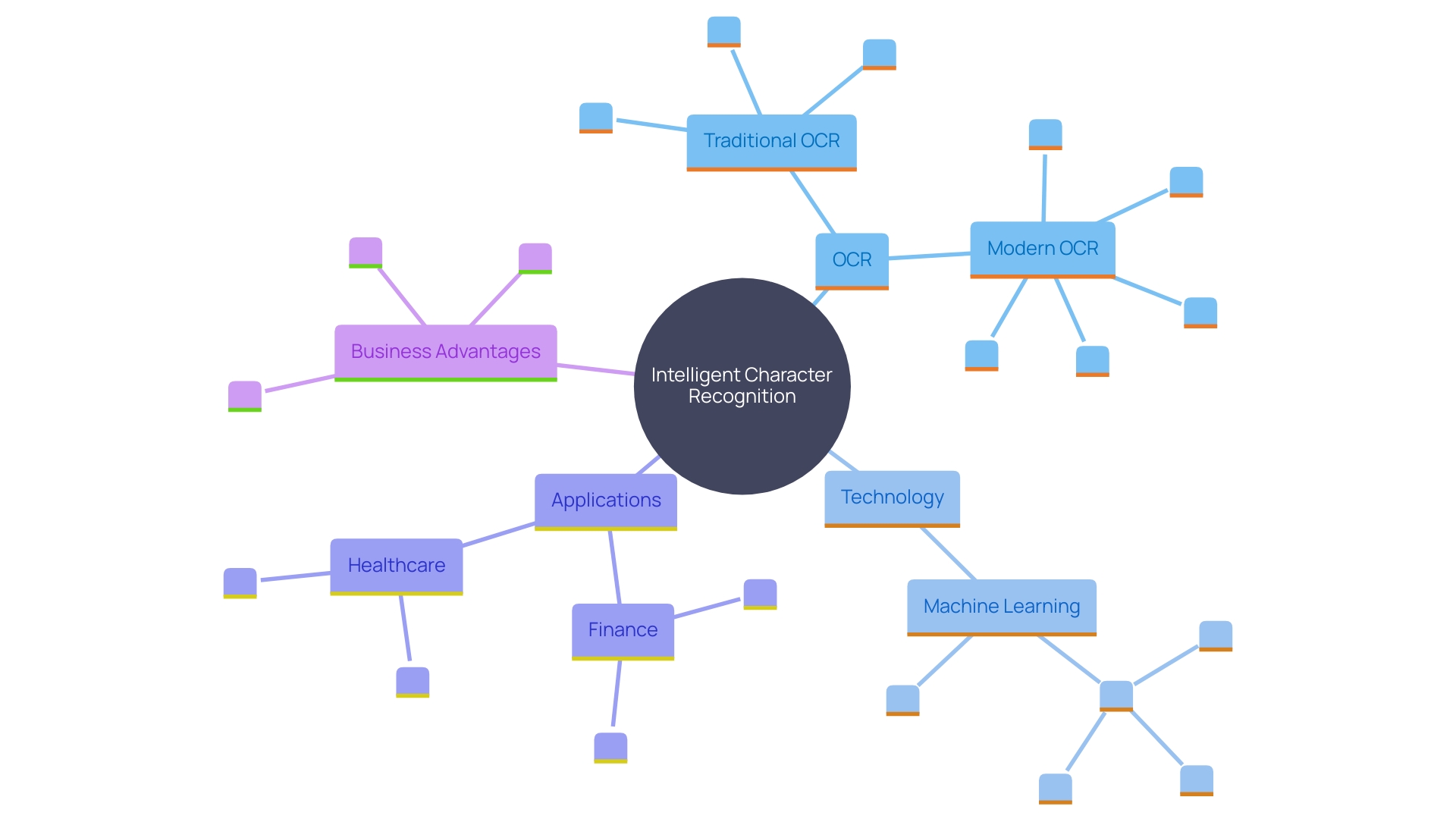
How ICR Differs from OCR
The primary distinction between Intelligent Character Recognition (ICR) and Optical Character Recognition (OCR) lies in their respective functionalities. OCR is skilled at identifying printed characters, making it ideal for digitizing books and documents with uniform fonts. In contrast, ICR is specifically designed for handwritten text, leveraging machine learning techniques to adapt and improve its accuracy over time. This capability allows ICR to handle a diverse range of handwriting styles and formats, which is particularly beneficial in processing forms and surveys.
ICR’s adaptability is a game-changer in environments where data entry involves varying handwriting levels. For instance, in the healthcare sector, the digitization of handwritten patient records has historically been time-consuming and prone to errors. ‘The integration of ICR methods has streamlined this process, significantly reducing manual input and enhancing accuracy.’. Similarly, financial institutions benefit from ICR through faster processing times and reduced operational costs, as the technology automates the recognition and digitization of handwritten documents.
Moreover, contemporary OCR systems incorporate deep learning methodologies such as Convolutional Neural Networks (CNNs) and Long Short-Term Memory (LSTM) networks, which improve recognition capabilities. These advancements have established a new benchmark in OCR precision, making it a robust solution for recognizing printed characters in diverse applications. Meanwhile, ICR continues to evolve, leveraging these machine learning techniques to enhance its efficiency and accuracy, thus providing a comprehensive solution for handwritten character recognition.
Applications of OCR and ICR
OCR and ICR methods are essential across various sectors because of their capacity to optimize workflows and improve productivity. OCR is pivotal in digitizing printed documents, automating office data entry, and making text searchable in archives. For example, in financial institutions, OCR systems automate the digitization of voluminous paperwork such as invoices, checks, and loan documents, significantly reducing processing times and operational costs. This automation not only improves customer service but also enhances fraud detection and loan processing accuracy.
ICR, conversely, excels in extracting handwritten information from documents like forms, invoices, and surveys. This capability is particularly transformative in sectors like healthcare, where managing patient records, including handwritten notes and prescriptions, has traditionally been labor-intensive and error-prone. ‘The introduction of cloud-based ICR solutions has automated the digitization of these records, enabling seamless integration into electronic health systems and reducing manual entry errors.’.
In practical uses, firms managing large amounts of documentation gain significant advantages from these tools. Consider a company with 20 employees generating 84 tax-related documents annually. The manual processing of these documents is not only time-consuming but also prone to errors. By leveraging OCR and ICR, these companies can automate data extraction and processing, ensuring accuracy and efficiency.
‘These innovations are not just about reducing manual tasks; they are about transforming operations to meet modern demands for speed, precision, and security.’. As industries continue to adopt OCR and ICR, the benefits are clear: enhanced productivity, reduced errors, and improved operational efficiency.
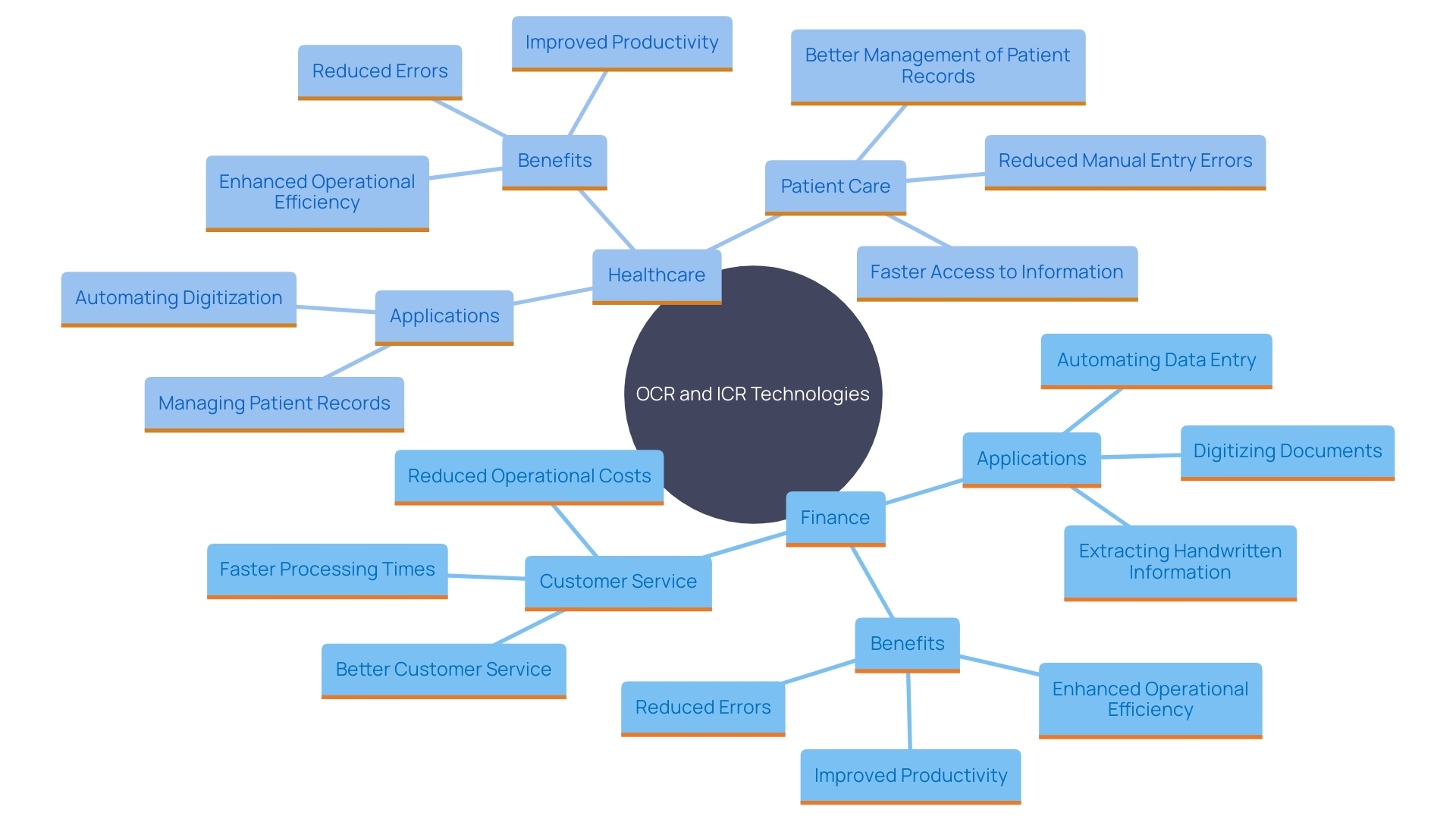
Benefits of Using ICR
Applying Intelligent Character Recognition (ICR) systems can transform data management procedures within organizations. By automating the recognition of handwritten characters, ICR significantly reduces the time and expenses related to manual data entry. This advanced form of OCR leverages machine learning techniques to enhance accuracy over time, minimizing the risk of errors common with human input. According to a report by Gusto, automating document processing has allowed them to maintain high accuracy and serve customers efficiently.
Moreover, ICR’s capacity to process various handwriting styles enables businesses to streamline customer interactions and documentation, leading to improved operational effectiveness. The integration of ICR in Intelligent Document Processing (IDP) systems provides a cutting-edge solution to the traditionally labor-intensive and error-prone task of manual data entry. As noted by Indico Data, the adaptability and scalability of these systems are expected to drive digital transformation, enhancing productivity across various sectors.
By converting unstructured data into machine-readable text, ICR bridges the gap between physical documents and digital systems, allowing for more efficient data extraction and management. As the volume of business documents continues to grow exponentially, the implementation of ICR technology becomes increasingly indispensable for maintaining operational efficiency and accuracy.
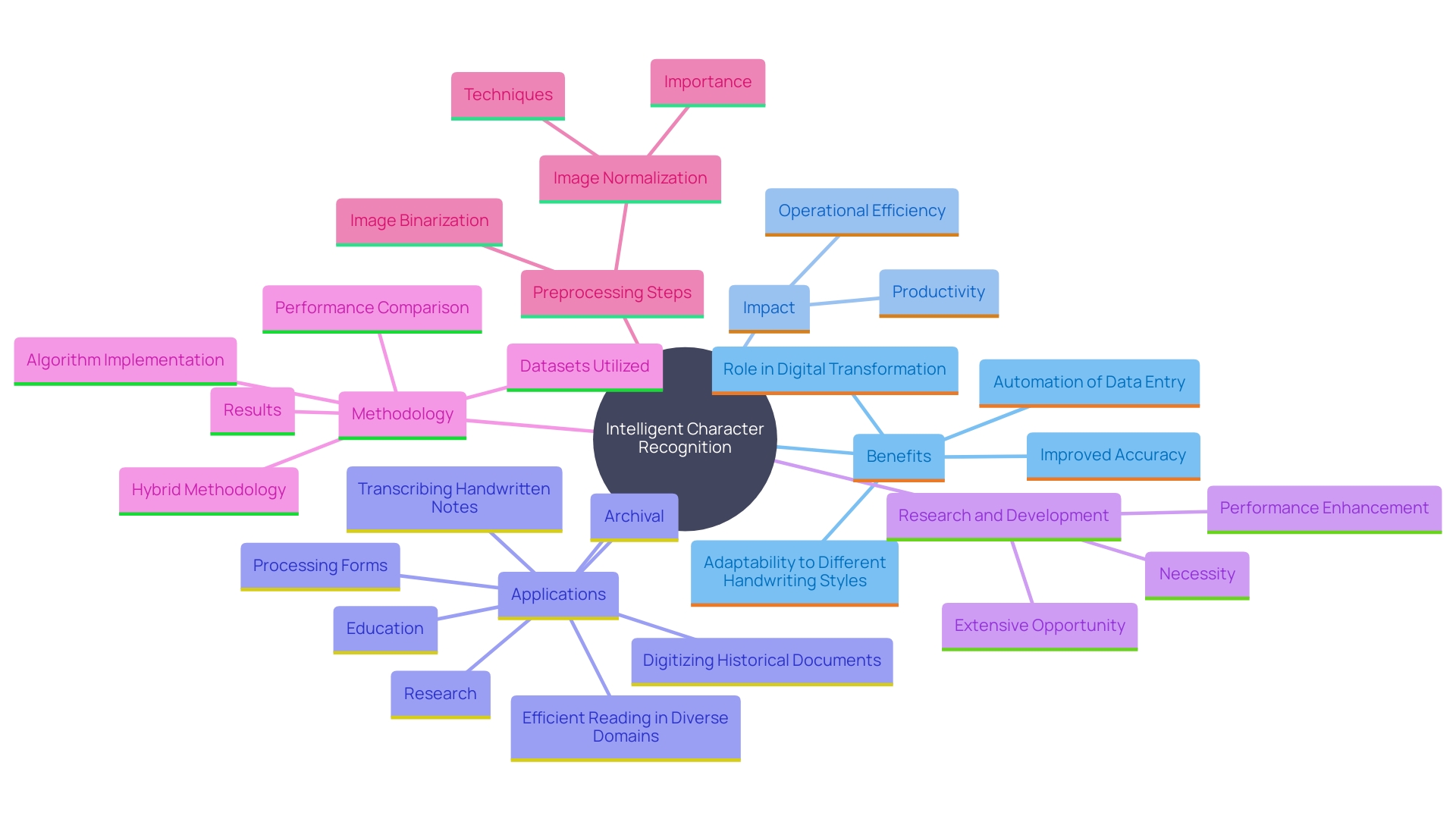
Conclusion
The advancements in Optical Character Recognition (OCR) and Intelligent Character Recognition (ICR) technologies are reshaping the landscape of data management across various industries. By automating the conversion of printed and handwritten text into digitally editable formats, these technologies streamline workflows and significantly reduce the time and costs associated with manual data entry. This not only enhances productivity but also ensures that critical information is readily accessible and actionable.
OCR excels in digitizing printed documents, making it an invaluable tool for sectors that rely on processing large volumes of paperwork, such as finance and healthcare. The ability to automate tasks such as invoice processing and loan documentation leads to increased operational efficiency and improved accuracy. Meanwhile, ICR takes this a step further by effectively handling diverse handwriting styles, thus addressing the challenges associated with traditional data entry methods.
Its application in sectors like healthcare demonstrates its potential to transform labor-intensive processes into seamless, efficient operations.
The integration of machine learning techniques into both OCR and ICR continues to enhance their capabilities, ensuring that organizations can keep pace with the growing demands for speed, precision, and security. As these technologies evolve, their role in fostering digital transformation becomes clear. Embracing OCR and ICR not only mitigates errors but also empowers organizations to leverage their data more effectively, paving the way for improved decision-making and operational success.
Introduction
In the rapidly evolving landscape of automation, the Blue Prism Robotic Operating Model (ROM) emerges as a beacon for organizations striving for operational excellence. Integrating critical elements such as governance frameworks, standardized process designs, and robust support infrastructures, Blue Prism ROM offers a structured pathway to achieve seamless automation. These components are not just theoretical constructs; they are practical tools that align automation initiatives with strategic objectives, ensuring compliance and fostering collaboration across business, IT, and data governance teams.
As organizations navigate the complexities of scaling RPA initiatives, the insights and real-world applications of Blue Prism’s digital workforce demonstrate the profound impact of intelligent automation on productivity and employee experience. With a focus on continuous improvement and adaptability, the Blue Prism ROM sets the stage for organizations to unlock significant economic benefits and maintain a competitive edge in the market.
Key Components of Blue Prism ROM
Blue Prism’s Robotic Operating Model (ROM) integrates several foundational elements that are crucial for the successful implementation of automated processes. One essential element is the management structure, which guarantees adherence and aligns mechanization efforts with strategic goals. ‘This framework is supported by contributions from experts actively participating in technical management and decision-making processes, as noted by leaders in the industry.’.
Standardized process design is another core element, promoting consistency across various mechanization projects. This standardization is essential in fostering cross-functional collaboration among business, IT, and data governance teams. By establishing clear communication channels and regular meetings, stakeholders can share insights and work towards common goals, ensuring that projects involving automated processes are cohesive and efficient.
A robust support infrastructure is indispensable for managing and scaling RPA initiatives. This includes technical infrastructure capable of managing the complexities of automated technologies. For instance, SS&C Blue’s digital workforce enhances human abilities by handling repetitive and high-volume tasks, thus enabling employees to concentrate on more value-added activities. This approach not only enhances productivity but also leads to significant improvements in employee experience and retention.
Furthermore, the changing environment of smart technology requires a thorough support system that can adjust to new challenges and opportunities. With more than 2,800 clients globally, SS&C Blue demonstrates how smart technology can lead to substantial financial advantages, such as a 73% rise in total NPV benefit and a 5.4% compound annual growth rate over three years for composite clients. These statistics underscore the importance of a well-rounded support infrastructure in realizing the full potential of RPA.
In summary, Blue’s ROM offers a structured method for task execution through governance, standardized procedures, and a robust support framework. By leveraging these components, organizations can achieve greater consistency, compliance, and scalability in their automation efforts, ultimately leading to more efficient and productive operations.
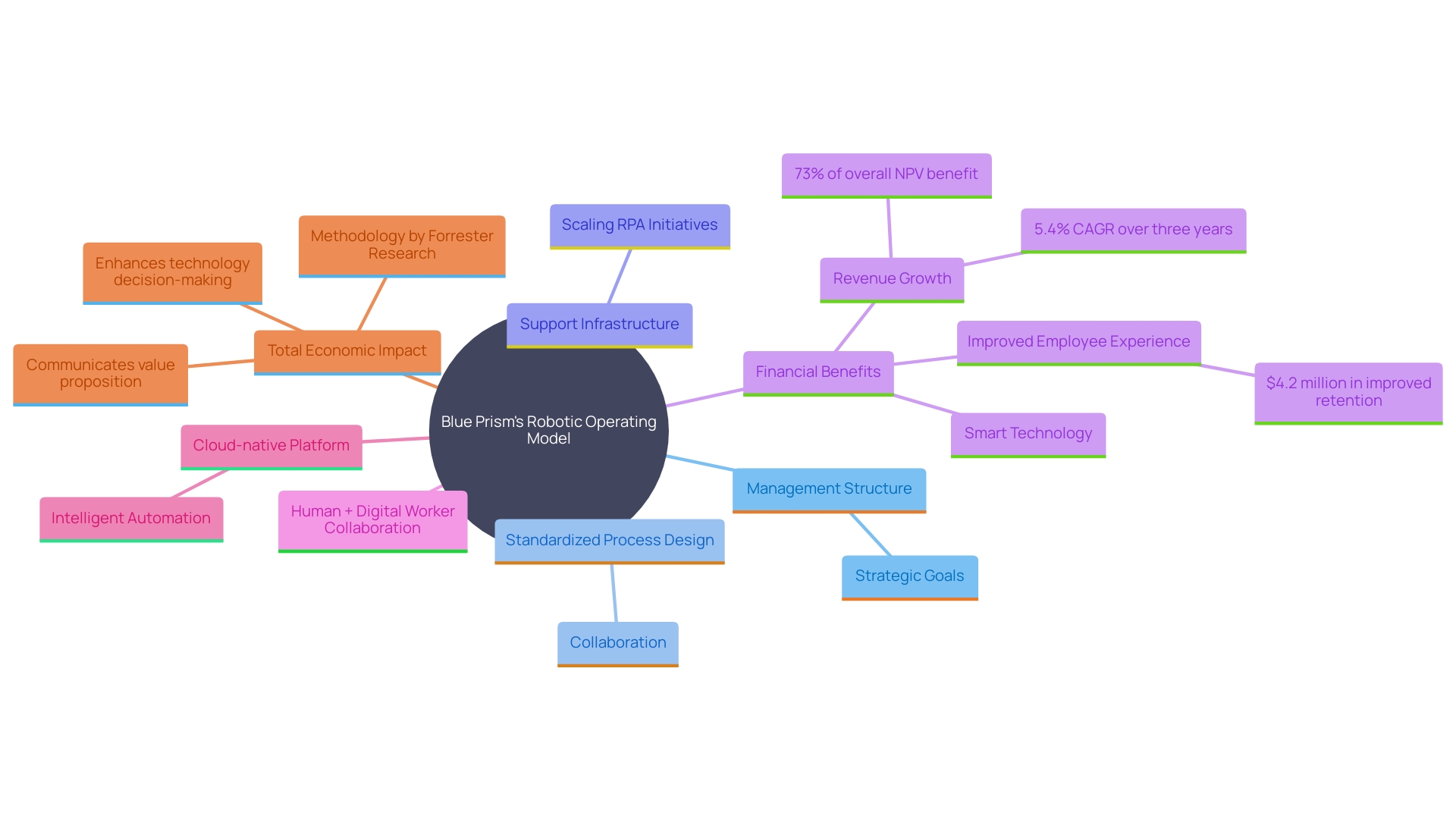
Benefits of Implementing ROM in Automation
Embracing the Blue Optical Robotic Operating Model (ROM) offers unparalleled advantages to organizations. This model significantly boosts operational efficiency by automating repetitive tasks, allowing employees to focus on higher-value activities. The structured framework of Blue Prism ROM ensures rapid deployment and scalability, enabling businesses to adapt swiftly to evolving market conditions. By cultivating a culture of ongoing enhancement, ROM not only promotes innovation but also optimizes the return on investment in mechanization.
According to a report by Allied Market Research, the Robot Operating Systems market is projected to reach $1.8 billion by 2032, growing at a CAGR of 12.9%. This surge reflects the increasing acknowledgment of technology’s critical role in maintaining competitive edge. Real-world examples further illuminate these benefits. For example, SS&C Blue has changed many sectors by incorporating smart processes, which has resulted in a $4.2 million enhancement in employee experience and retention throughout its clientele.
Furthermore, the thorough strategy of Blue Prism ROM corresponds with the wider trend of utilizing intelligent processes to address technical challenges and promote organizational change. By orchestrating comprehensive processes with machine learning applications, businesses can achieve new levels of efficiency and agility. As Chhavi Arora from McKinsey emphasizes, adopting such frameworks is crucial for capturing the complete value of mechanization and preparing the workforce for upcoming challenges.
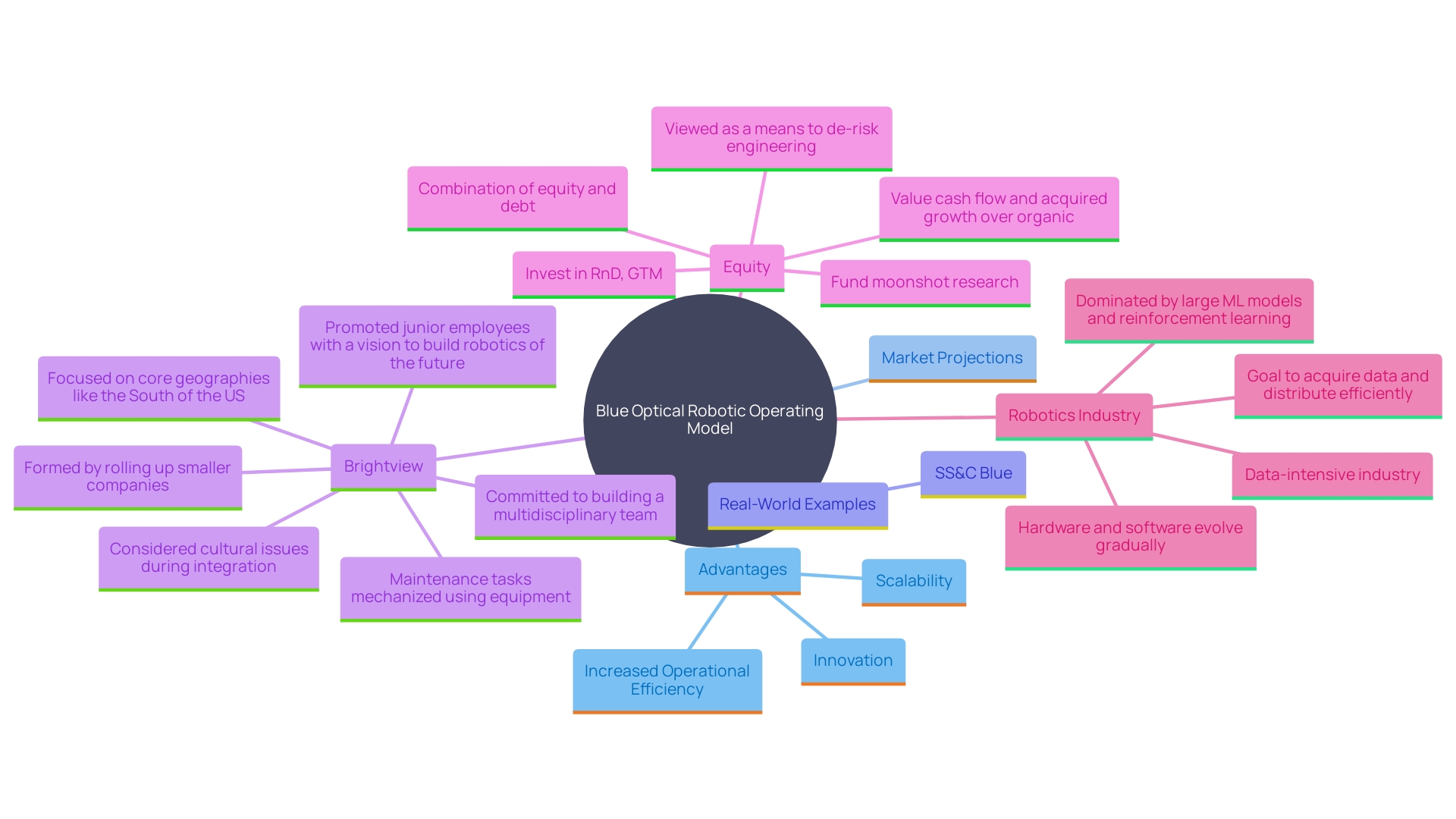
Design and Optimization Strategies
To maximize the effectiveness of RPA, organizations should focus on design and optimization strategies aligned with the Blue Prism ROM. This involves conducting thorough process evaluations to identify opportunities for mechanization, followed by designing user-friendly workflows. Continuous optimization is essential; leveraging analytics to monitor bot performance can lead to iterative improvements, ensuring that RPA solutions remain efficient and aligned with business objectives. As per a study conducted by Forrester Research, firms that invested in smart systems experienced a 73% increase in revenue and a 5.4% compound annual growth rate (CAGR) over three years. Monitoring, management, and upgrades continue to be a part of the process, including Artificial Intelligence (AI). Like all technological advancements throughout history, AI has aimed to improve efficiency, productivity, and convenience, but it still requires a human partnership to ensure stability. For example, a welding and steel fabrication company reduced touch-up work by 50% through an automated solution, saving significant time. Additionally, the Robot Operating Systems Market is projected to reach $1.8 billion by 2032, growing at a 12.9% CAGR. This growth emphasizes the rising dependence on technology to remain competitive. By starting with smaller tasks and continuously monitoring results, organizations can ensure that their RPA initiatives yield tangible benefits and align with long-term goals.
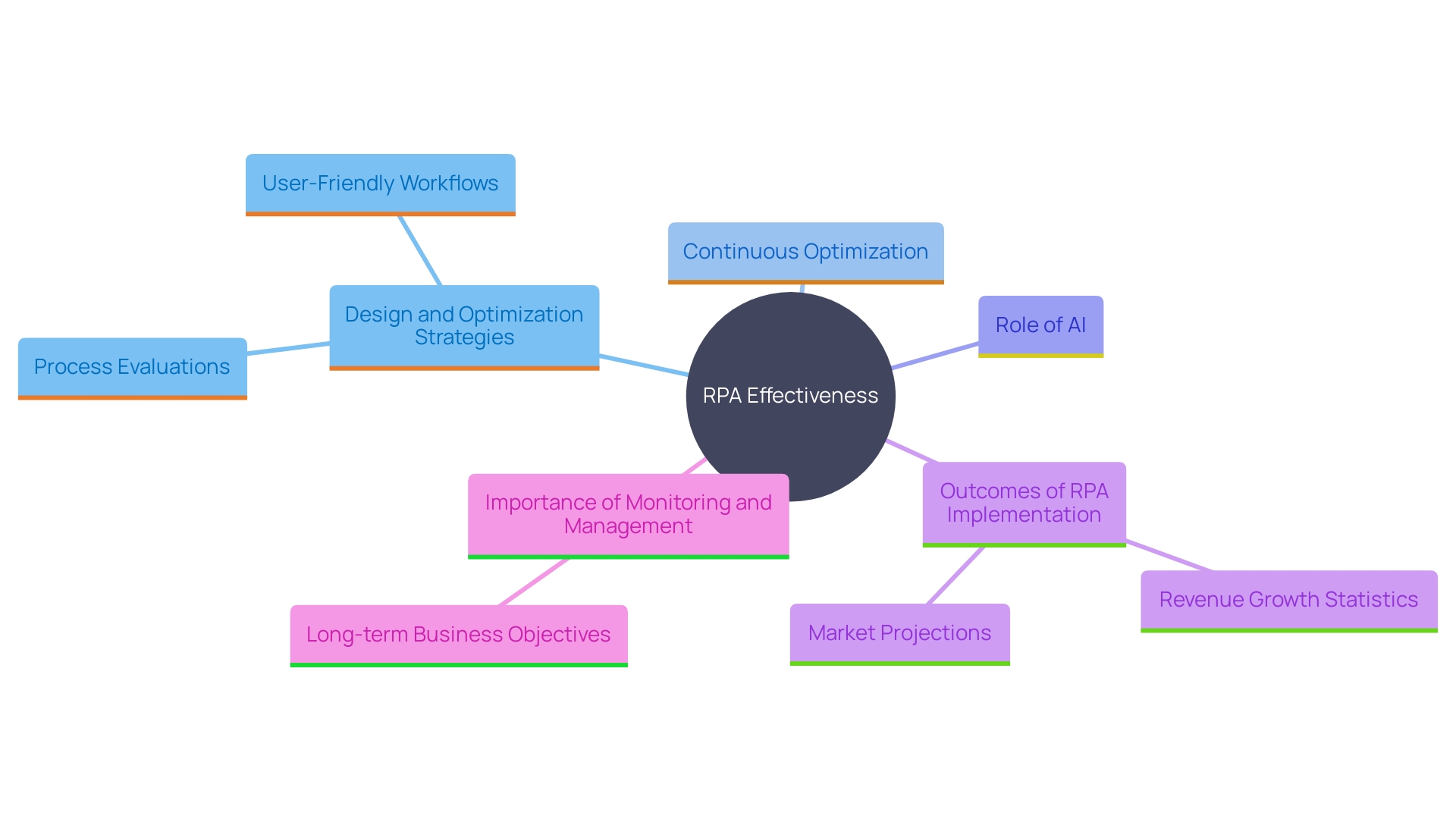
Governance and Scalability Considerations
Efficient management is essential for overseeing RPA initiatives within the Blue Prism ROM framework. Establishing clear policies and performance metrics ensures accountability and transparency, particularly when scaling operations. As noted in the finance department of Mass General Brigham hospital, a streamlined approach to automation enabled them to overcome significant bottlenecks, demonstrating the importance of oversight in achieving operational efficiency.
Scalability should be a primary consideration in RPA planning. As organizations anticipate growth, they must ensure their infrastructure can support an increasing number of bots without compromising performance or security. This approach is echoed by the recent advancements from ConnectWise, which integrated RPA into its foundational technology, enabling companies to handle more tasks efficiently and cost-effectively.
Furthermore, the necessity for strong management frameworks is highlighted by the EU’s comprehensive AI regulations. These regulations set clear obligations for high-risk AI systems, emphasizing the importance of transparency and risk mitigation. This corresponds with findings from a study involving the 300 largest companies, which highlighted the positive impact of RPA on environmental, social, and management (ESG) factors. By focusing on effective governance, organizations can not only enhance their efficiency but also contribute to broader ESG goals.
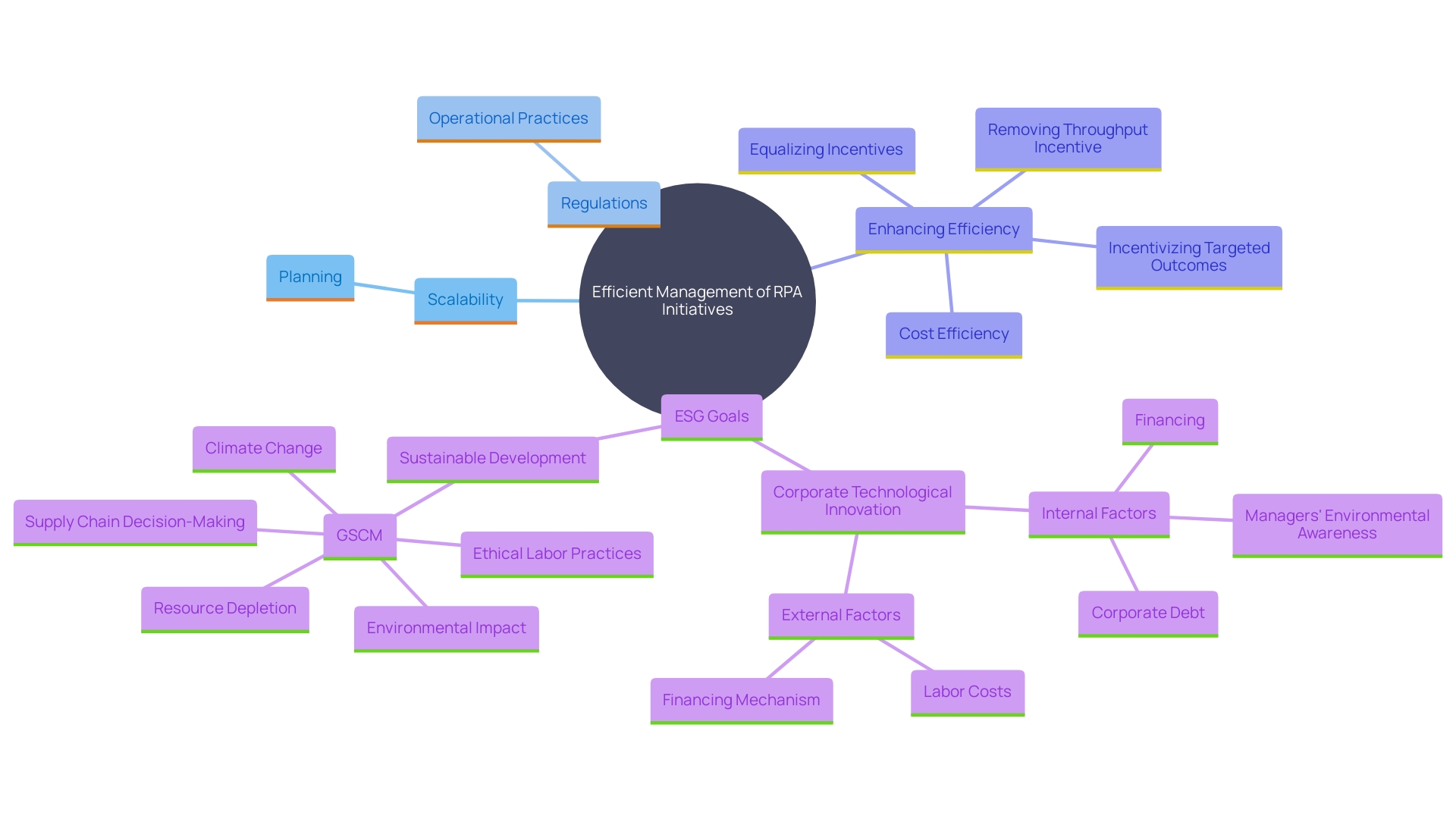
Conclusion
The Blue Prism Robotic Operating Model (ROM) stands as a transformative framework for organizations seeking to harness the full potential of automation. By integrating essential components such as governance frameworks, standardized process designs, and robust support infrastructures, Blue Prism ROM provides a structured pathway that aligns automation initiatives with strategic goals. This alignment fosters compliance and encourages collaboration among business, IT, and data governance teams, laying the groundwork for successful automation initiatives.
Implementing the Blue Prism ROM yields significant benefits, including enhanced operational efficiency and improved employee experiences. The model’s structured approach allows for rapid deployment and scalability, enabling organizations to swiftly adapt to changing market conditions. Real-world examples underscore the economic advantages of adopting intelligent automation, highlighting how businesses can achieve substantial returns on their automation investments while fostering a culture of continuous improvement.
To maximize the effectiveness of RPA, organizations must prioritize design and optimization strategies that align with the Blue Prism ROM. Conducting thorough process assessments and continuously monitoring bot performance through analytics ensures that RPA solutions remain efficient and aligned with business objectives. Effective governance and scalability considerations are vital for managing RPA initiatives, ensuring accountability, transparency, and the capacity to scale operations without compromising performance.
In conclusion, embracing the Blue Prism Robotic Operating Model equips organizations with the tools necessary to navigate the complexities of automation. By leveraging its comprehensive framework, businesses can unlock significant economic benefits, enhance operational efficiency, and prepare for future challenges in the ever-evolving landscape of intelligent automation.
Introduction
In the rapidly evolving landscape of business operations, Robotic Process Automation (RPA) stands out as a transformative force. The Director of Operations Efficiency faces the daunting task of optimizing processes while maintaining high levels of productivity and accuracy. This article provides a structured roadmap, detailing each critical step to successfully implement RPA and achieve significant operational improvements.
From defining clear objectives and selecting the right tools to developing proof of concept and ensuring robust security measures, these steps offer practical solutions tailored to meet organizational needs. Real-world examples and industry insights illustrate the tangible benefits of automation, highlighting the importance of meticulous planning, continuous improvement, and stakeholder engagement. Dive into this comprehensive guide to unlock the full potential of RPA and drive your organization toward unparalleled efficiency and innovation.
Step 1: Define Objectives and Scope
To implement RPA successfully, begin by clearly defining your objectives and understanding the specific outcomes you aim to achieve. Charting the procedure and identifying stakeholders and systems involved, such as inventory management or online shop software, is crucial. Comparing the complexity and estimated ROI of potential automation candidates can help focus efforts on high-impact areas. Keep in mind, significant immediate successes often arise from automating simple tasks instead of more sophisticated methods.
Consider common use cases like automating identity verification and simple order inquiries, which have proven effective for many companies. For instance, retailers have successfully automated the initial identity verification procedure and basic order status inquiries, such as ‘Where is my order?’.} This approach not only streamlines operations but also increases customer satisfaction.
Defining the extent of your mechanization project will guarantee resources are distributed efficiently. As emphasized by industry experts, utilizing tools such as Tungsten’s automated features can greatly improve process efficiency and customer service. This is reflected in the experience of public service units that adopted innovative technological solutions to transform their operations, capturing much richer detail from invoices and improving overall service delivery.
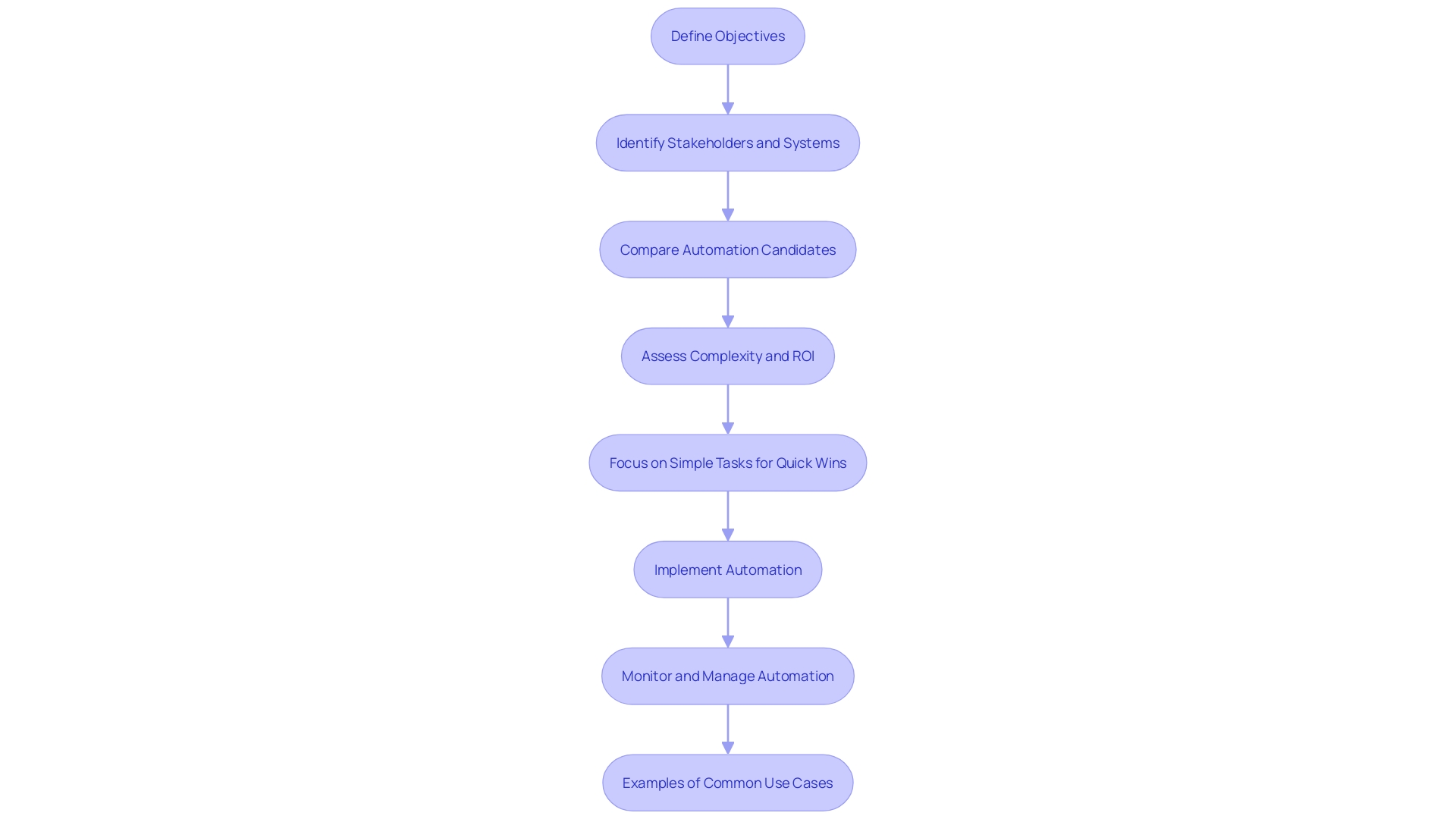
Step 2: Select the Right RPA Tool
Selecting the ideal RPA tool is pivotal for a successful implementation. Start by conducting a thorough evaluation based on your organization’s unique requirements, such as scalability, ease of integration, and vendor support. For instance, many organizations have found that their existing solutions already encompass functionalities they were seeking, emphasizing the importance of diligent assessment. Moreover, the right RPA tool should align with your strategic objectives and ensure it delivers both business and technical value. Keep in mind that automated solutions, whether no-code, low-code, or high-code, should be chosen based on the specific use cases and the technical proficiency of the users. ‘As mechanization continues to be a cornerstone of modern business operations, integrating a well-suited RPA tool can significantly enhance productivity and operational efficiency.’.
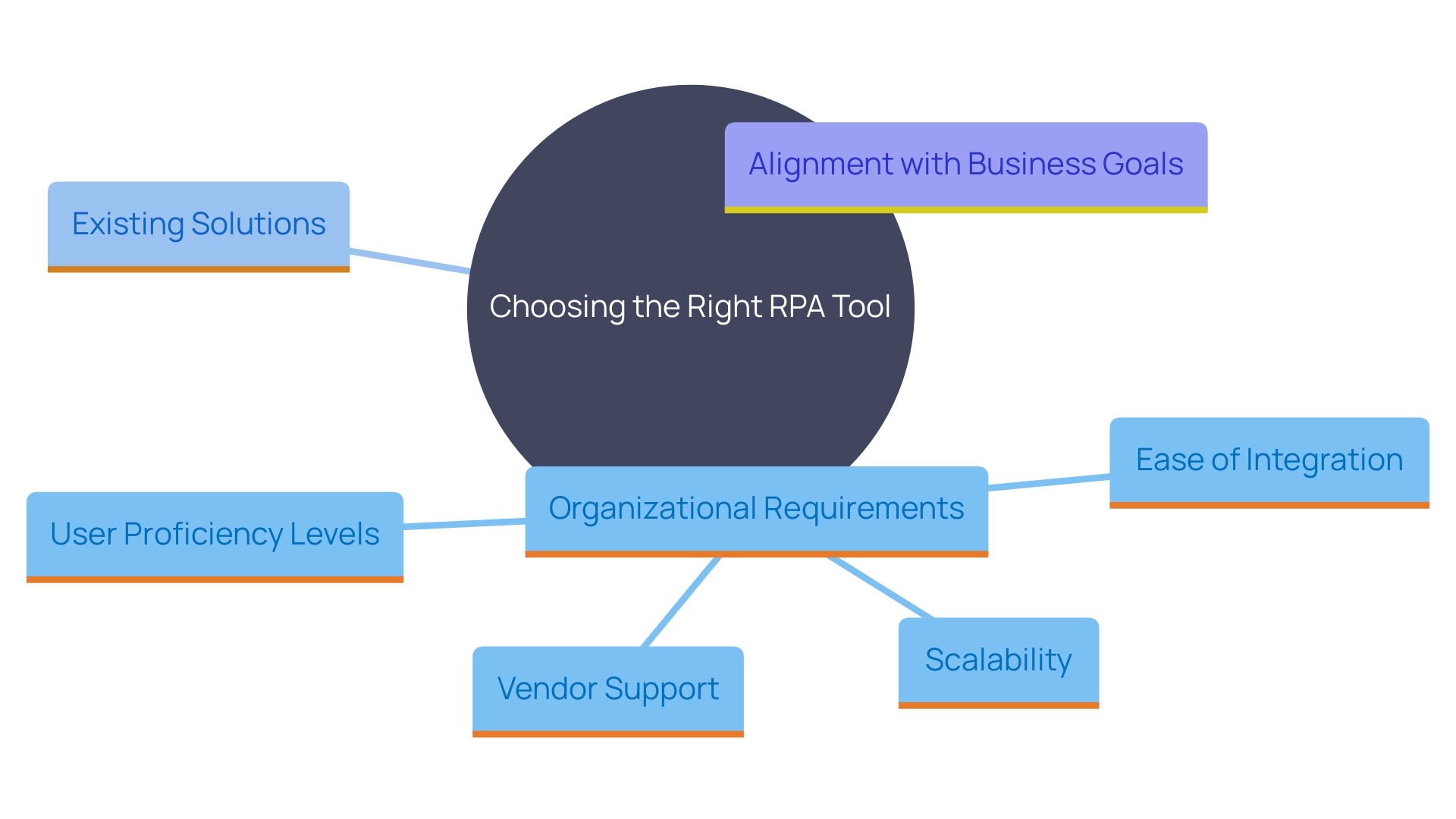
Step 3: Assess Potential Opportunities and Process Analysis
Start with a thorough analysis of your existing methods to identify where mechanization can be most advantageous. Prioritize identifying repetitive tasks that significantly drain time and resources. Documenting workflows is crucial—this allows for a clear understanding of existing procedures and helps highlight inefficiencies. Engage stakeholders to gather insights on pain points, as their perspectives can be invaluable in recognizing areas ripe for improvement.
For instance, Surrey County Council, which serves 1.2 million people, has introduced technology to enhance both citizen and employee experiences. This initiative highlights the significance of thorough examination and stakeholder involvement. Likewise, Specsavers, a worldwide organization with a complicated supply network, has created in-house technologies to tackle particular operational issues, showcasing the benefits of customized mechanization solutions.
Remember, the procedure of integrating automation involves several steps: digitization (converting data into digital form), digitalization (using digital data to modify processes), and digital transformation (leveraging digital technologies to create additional value). Each stage builds on the prior one, enabling a seamless transition from manual to automated systems. As stated, ‘They place technology at the center of end-to-end process execution, allowing humans to focus on providing high-value subject matter expertise.’
By following these steps and leveraging real-world examples, you can effectively implement mechanization to optimize your operations, leading to significant improvements in efficiency and productivity.
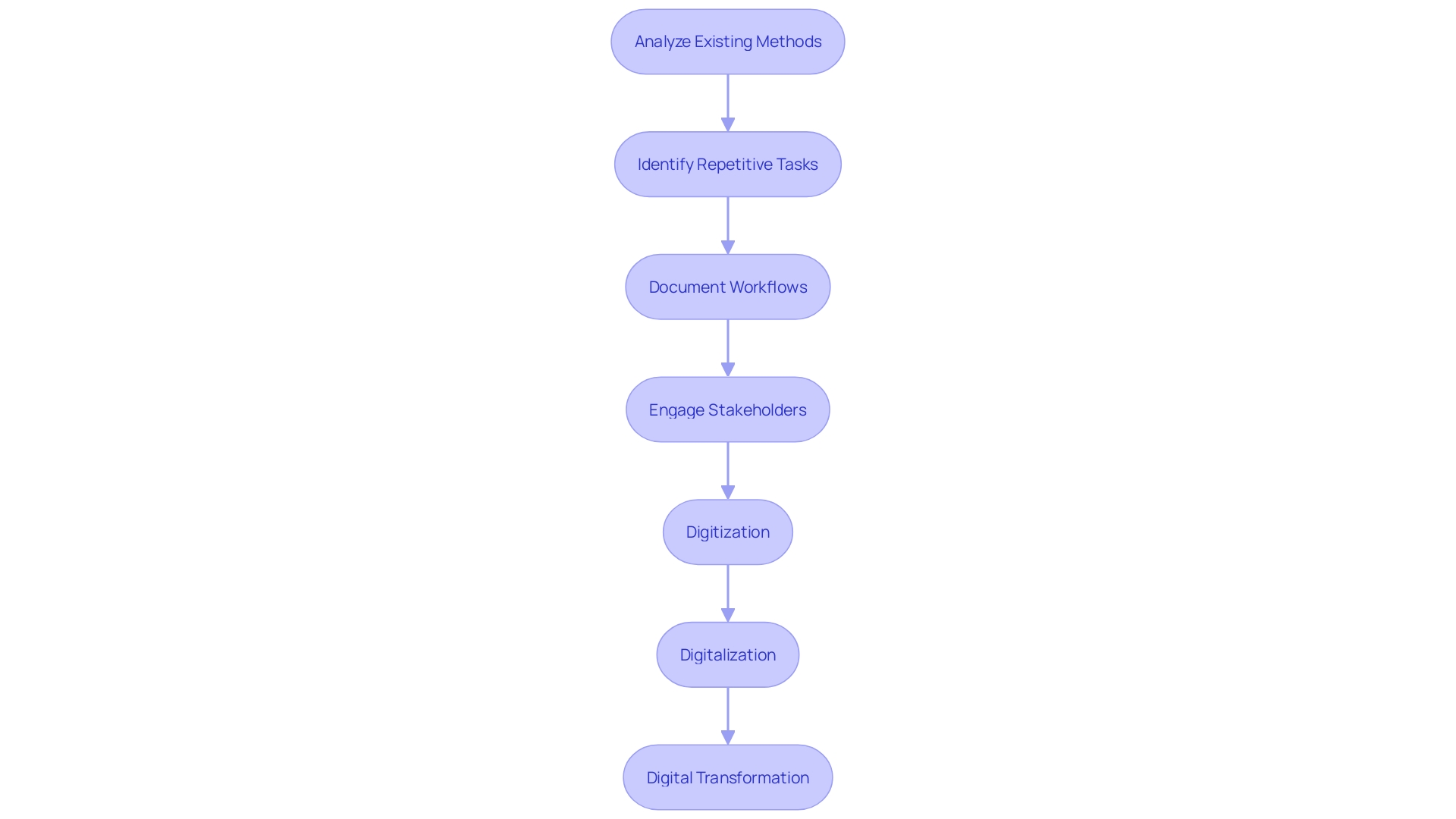
Step 4: Develop Proof of Concept and Pilot Testing
Initiating a proof of concept (PoC) is a crucial step before a full RPA rollout. This pilot phase allows you to test the RPA solution on a smaller scale, ensuring its effectiveness and identifying potential areas for improvement. For example, Millennium Recycling, an industry leader in recycling technology, continually adapts and tests emerging technologies before full implementation. By validating the system through a PoC, you can gather valuable feedback and make necessary adjustments to optimize performance. As emphasized by industry specialists, addressing unmet needs and refining the approach are fundamental to the innovation framework. Therefore, a well-executed PoC not only minimizes risks but also paves the way for successful, full-scale automation deployment.
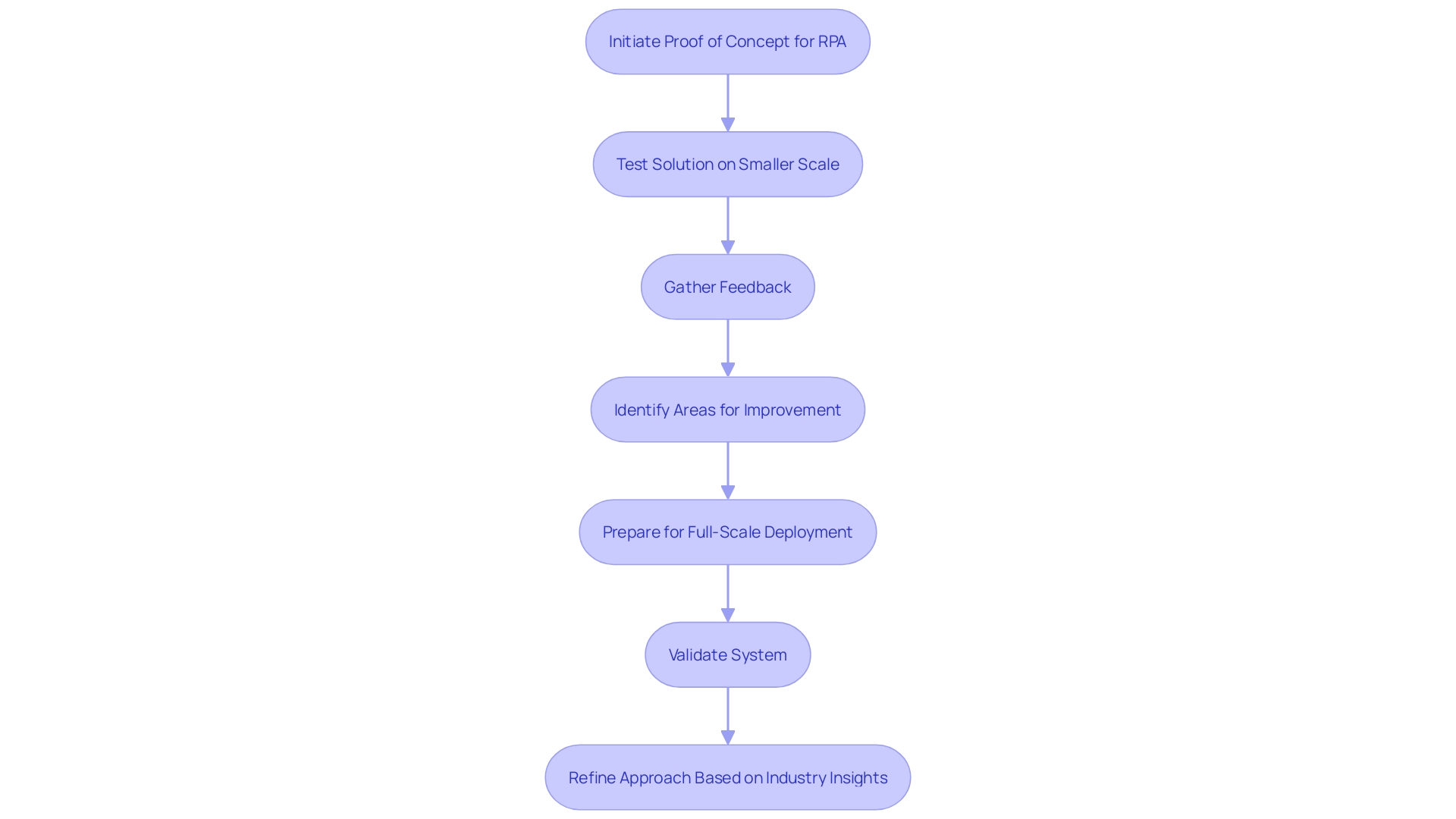
Step 5: Resource Organization and Implementation Planning
Effectively organizing resources is paramount for a successful implementation phase. Begin by crafting a meticulous plan detailing timelines, responsibilities, and necessary resources. Ensure every team member is aligned with their roles and responsibilities.
For instance, Renault’s supply chain digitalization journey offers valuable insights. Between 2018 and 2021, Renault dedicated 10% of its IT budget to data structuring, creating a robust data lake. This structured approach laid the groundwork for developing a control tower, connected with partners like Shippeo, enabling precise factory supply management. As Ludovic Doudard, General Manager Process Engineering Supply Chain at Renault, noted, ‘In the supply chain department, while we have digitized and organized our operations well, our data depends on information systems, it is thus naturally organized.’ This meticulous planning and resource allocation were pivotal in achieving high operational efficiency, showcasing the importance of a well-structured implementation plan.
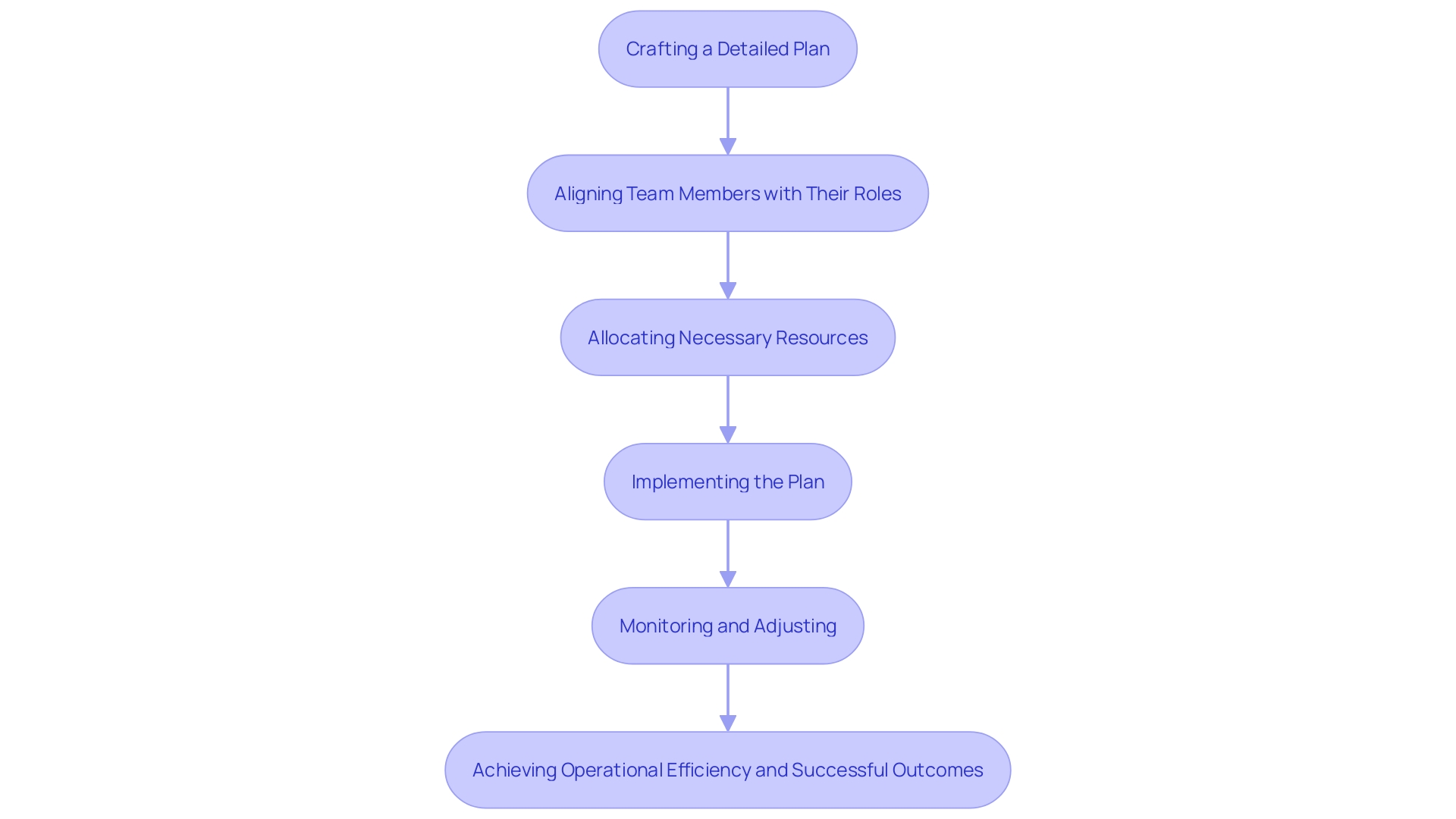
Step 6: Bot Development and Integration with Existing Systems
After finalizing the planning phase, the next step is to initiate bot development. Collaborate closely with technical teams to ensure seamless integration of bots with existing systems. This is crucial for maintaining operational continuity and avoiding disruptions. Focus on developing user-friendly bots that demand minimal intervention, thus enhancing productivity and reducing the time spent on manual tasks.
A key consideration during development is the complexity of integrating multiple systems and services. For instance, Lindy, an AI assistant designed for tasks like medical scribing and customer support, faced significant challenges in integrating a large network of apps and services. This procedure required extensive research, planning, and development time, which threatened to delay their market entry by up to a year. To mitigate this, Lindy used n8n, a workflow automation tool, to streamline these integrations.
Moreover, the progress in AI and machine learning has led to more functional and smarter bots. These advancements enable bots to provide instant and efficient user interactions, automate customer service tasks, and deliver personalized content. However, the complexity of human language and context nuances still pose challenges. Specialized AI agents, designed to excel in specific domains, are proving to be an effective solution. These agents can leverage the strengths of existing AI technology while bypassing many of its limitations.
Integrating these insights into the development stages can significantly improve the effectiveness and efficiency of your bots, ensuring they meet the evolving needs of your organization.
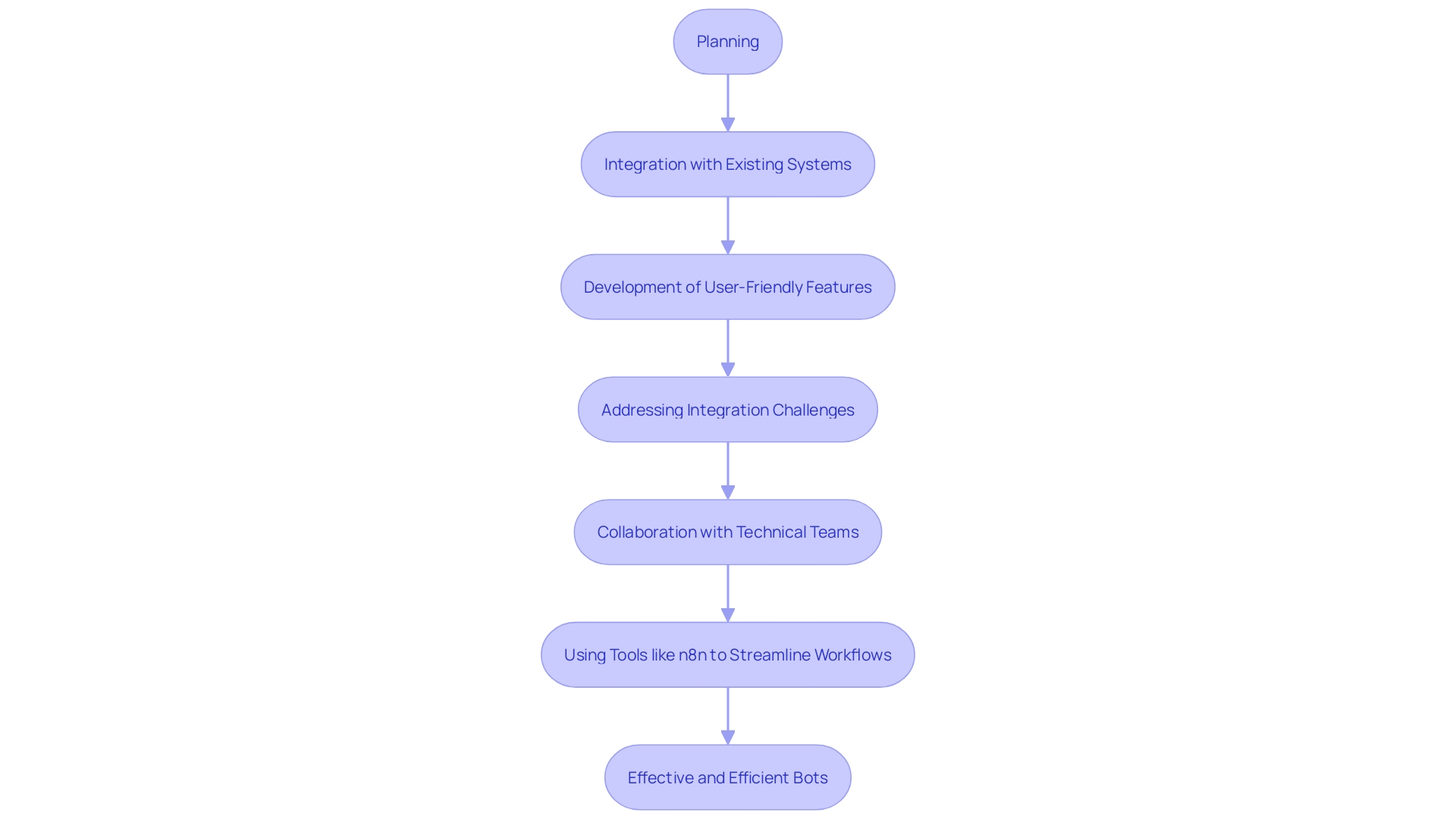
Step 7: Testing and Validation
Following the development stage, it is essential to carry out comprehensive testing to confirm that robotic task bots operate as expected. Rigorous validation involves simulating real-world scenarios to assess both functionality and accuracy. Additionally, using advanced simulations, such as those highlighted by the RialTo system, can help train robots effectively in physical spaces, ensuring they operate seamlessly once deployed.
Addressing any issues uncovered during these tests is essential for smooth deployment. According to the World Quality Report, quality assurance teams must ensure that software testing keeps pace with rapid innovation to avoid obsolescence. This perspective shift—from viewing testing as a cost center to recognizing it as a significant contributor to cost savings and ROI—underlines the importance of robust testing protocols.
ABB’s approach to deploying versatile collaborative robots worldwide demonstrates the importance of a well-executed testing phase. Their robots are designed to work safely alongside human operators, combining human adaptability with robotic precision. This ensures the assembly of various products on the same line, highlighting the benefits of thorough pre-deployment testing.
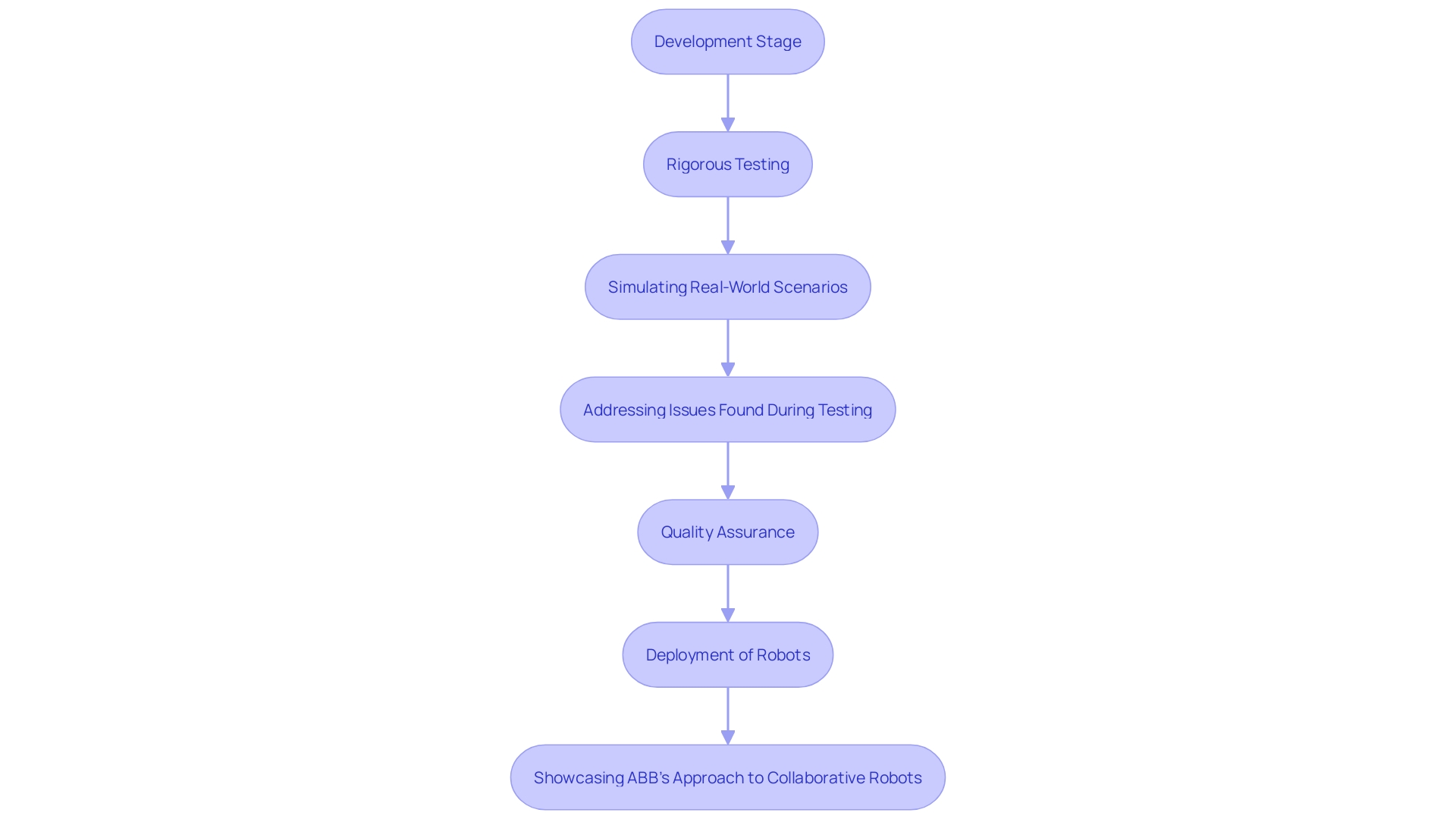
Step 8: Security and Compliance
Implementing robust security measures is crucial to protecting sensitive data and ensuring compliance with industry regulations. Conduct dynamic risk assessments to identify potential vulnerabilities and adopt security best practices for your RPA solution. According to Fouad Khalil, Senior Director of Enterprise Security, Risk, and Compliance, the increase in cyber threats such as ransomware and phishing attacks necessitates that security is essential to any system implementation, particularly in crucial areas like warehousing and logistics.
The introduction of the NIS2 Directive in 2022 further underscores the importance of stringent security measures. This directive expands coverage to essential sectors, including telecommunications and manufacturing, and imposes stricter security requirements for risk management and supply chain security. It highlights the necessity for organizations to adopt comprehensive security strategies tailored to their operations.
Real-world examples emphasize the significance of maintaining robust cybersecurity. For instance, the largest healthcare data breach of the year affected over 11 million individuals, illustrating the devastating impact of inadequate security measures. This breach serves as a stark reminder that safeguarding sensitive information is vital to maintaining trust and avoiding legal repercussions.
Incorporating these security measures not only protects your organization but also fosters a culture of trust and resilience. As the cybersecurity workforce continues to grow, with an estimated 4.7 million professionals globally, staying updated on the latest trends and threats is essential. Only 4% of organizations feel confident in their security, indicating a significant need for continuous improvement and vigilance in protecting against cyberattacks.
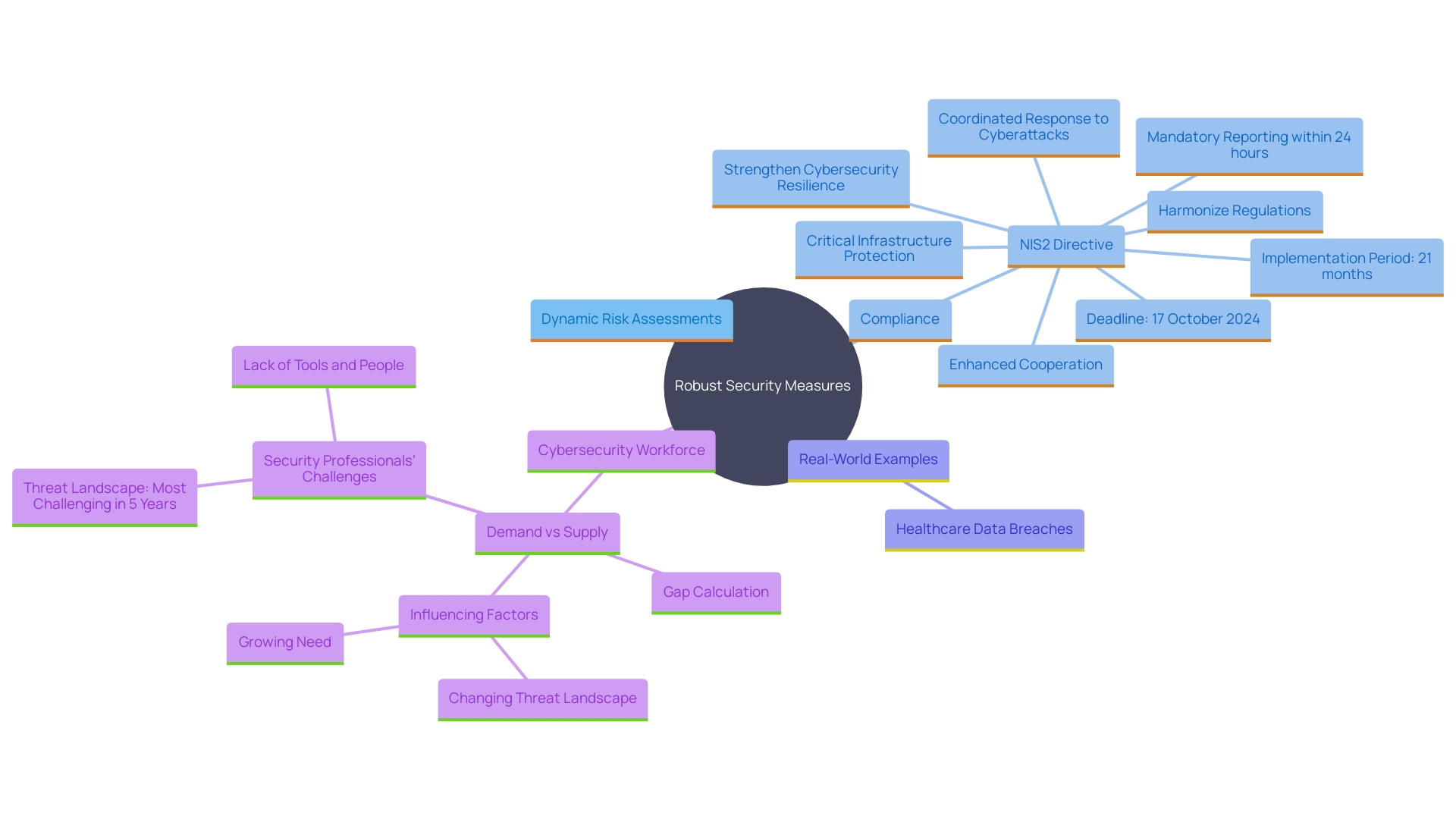
Step 9: Training and Change Management
To fully harness the benefits of Robotic Process Automation (RPA), prioritizing comprehensive training programs for employees is essential. This involves not only equipping them with the necessary skills but also fostering an environment that welcomes change. Implementing effective change management strategies can significantly ease the transition, addressing resistance and ensuring smooth adoption.
Engaging employees from the outset can help mitigate fears associated with new technologies. As Rosabeth Moss Kanter of Harvard Business School notes, understanding the root of resistance often reveals underlying anxieties rather than outright opposition. Encouraging a mindset shift towards continuous learning can transform apprehension into enthusiasm.
Working together is essential in this endeavor. By ensuring that all team members are on the same page and understand the value of automation, organizations can foster a culture of innovation and efficiency. As observed in the NHS Digital Service Team’s strategy, conducting thorough assessments and understanding existing capabilities within the organization can streamline the adoption phase, preventing duplication and maximizing resource utilization.
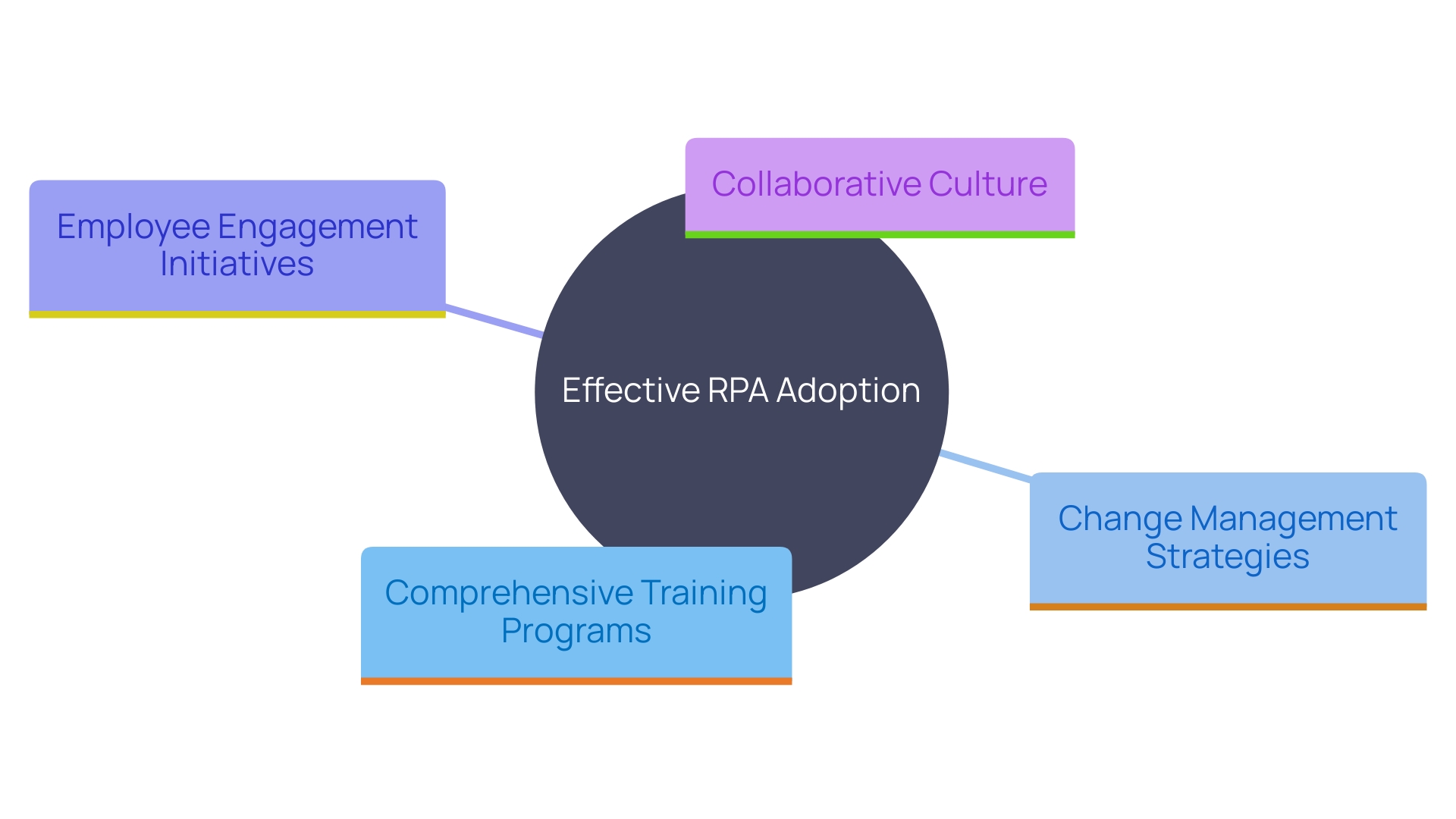
Step 10: Pilot Deployment and Scaling Up
Once the testing phase is completed and the staff are adequately trained, the next step is to initiate a pilot deployment. This phase is crucial for observing the real-world performance of the RPA system. Regular observation during this phase enables the gathering of important feedback, which is crucial for implementing necessary modifications to enhance the system.
If the pilot deployment proves successful, the focus should shift to scaling up the RPA implementation across other departments. ‘This multi-stage approach reflects the broader digital transformation journey, which includes digitization, digitalization, and ultimately, full digital transformation.’. Each step utilizes enhanced data collection and examination to improve organizational productivity and decision-making.
By placing technology at the core of process execution, organizations enable their human workforce to concentrate on delivering high-value expertise, thereby creating additional value for all stakeholders involved. This methodical approach ensures not only the stability of the RPA system but also its alignment with the long-term strategic goals of the organization.
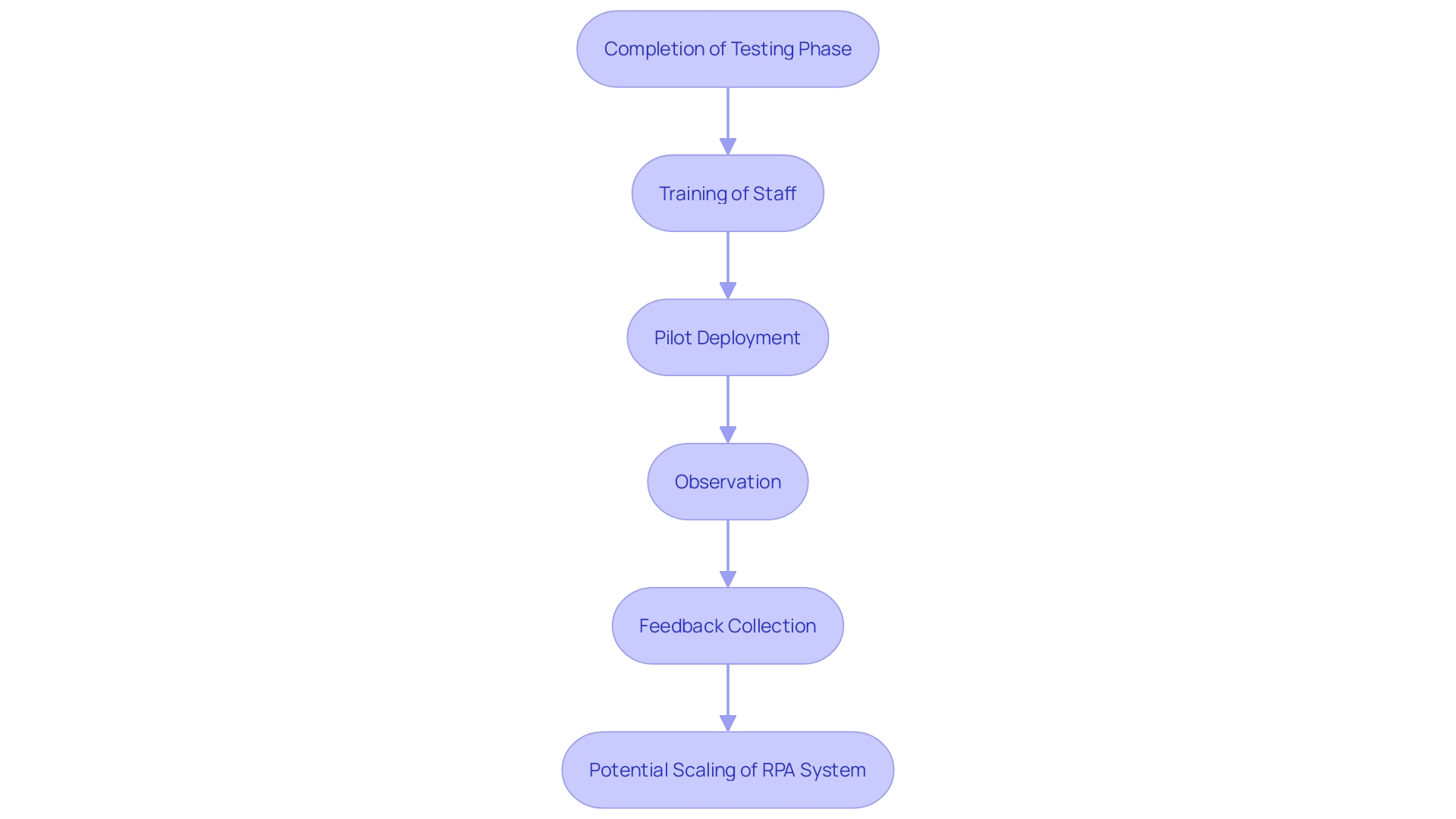
Step 11: Monitoring and Maintenance
To ensure your RPA bots operate efficiently, continuous performance monitoring is essential. Establish robust maintenance protocols to promptly address any issues, minimizing downtime and operational disruptions. The case of Medien Hub Bremen-Nordwest illustrates the significant benefits of proactive monitoring and maintenance. By collaborating with Parloa and SC Soft, they exceeded their goals and drastically reduced customer complaint processing times.
Unplanned downtime can be a costly setback for businesses. Traditional approaches to fixing robot downtime are not only inefficient but also expensive. As noted by Express Computer, the costs associated with such downtimes can be prohibitive for small and medium-sized enterprises (SMEs). By implementing a proactive maintenance strategy, you can avoid these pitfalls and optimize performance.
Automation, including RPA, has always needed human supervision to ensure stability and effectiveness. As highlighted by the CTO of Reveille Software, “Automation was never created to be hands-off.” Regular monitoring and management are essential for maintaining operational effectiveness and achieving long-term success.
In the case of Rippling, moving to a more robust AI agent solution significantly enhanced response accuracy and productivity. Their previous system required heavy manual oversight, limiting scalability. This shift underscores the importance of continuous system evaluation and upgrading to meet evolving business needs and maintain high performance.
The predictive maintenance market offers a strategic approach to monitoring industrial equipment, predicting failures, and optimizing maintenance efficiency. This approach not only promises significant cost savings but also enhances asset performance. By leveraging predictive maintenance techniques, businesses can ensure their RPA bots and other automated systems run smoothly and efficiently.
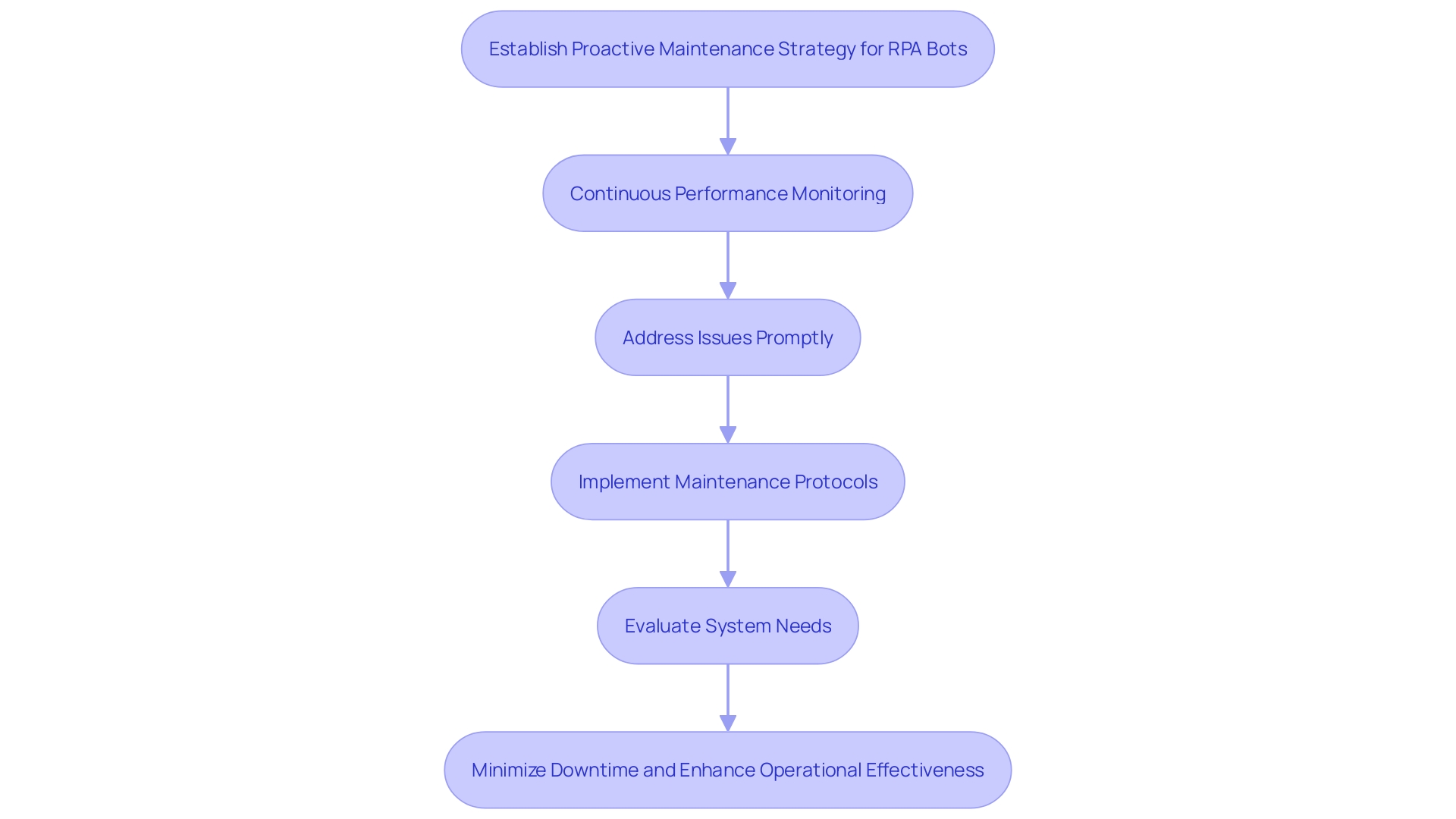
Step 12: Continuous Improvement and Reporting
Foster a culture of continuous improvement by consistently evaluating the performance and outcomes of your RPA initiatives. Utilizing data analysis is essential for monitoring success indicators, which not only emphasizes areas of achievement but also reveals additional opportunities for mechanization. Regular reporting is essential, as it provides stakeholders with clear insights into the impact of RPA on the organization. This method reflects the proactive strategies observed in other sectors, like the Mass General Brigham hospital system, where automation greatly enhanced data gathering and workflow activities. As Mark Twain aptly put it, “The secret of getting ahead is getting started.” By establishing a strong foundation in RPA, organizations can shift from reactive to predictive strategies, ensuring sustained efficiency and productivity gains.
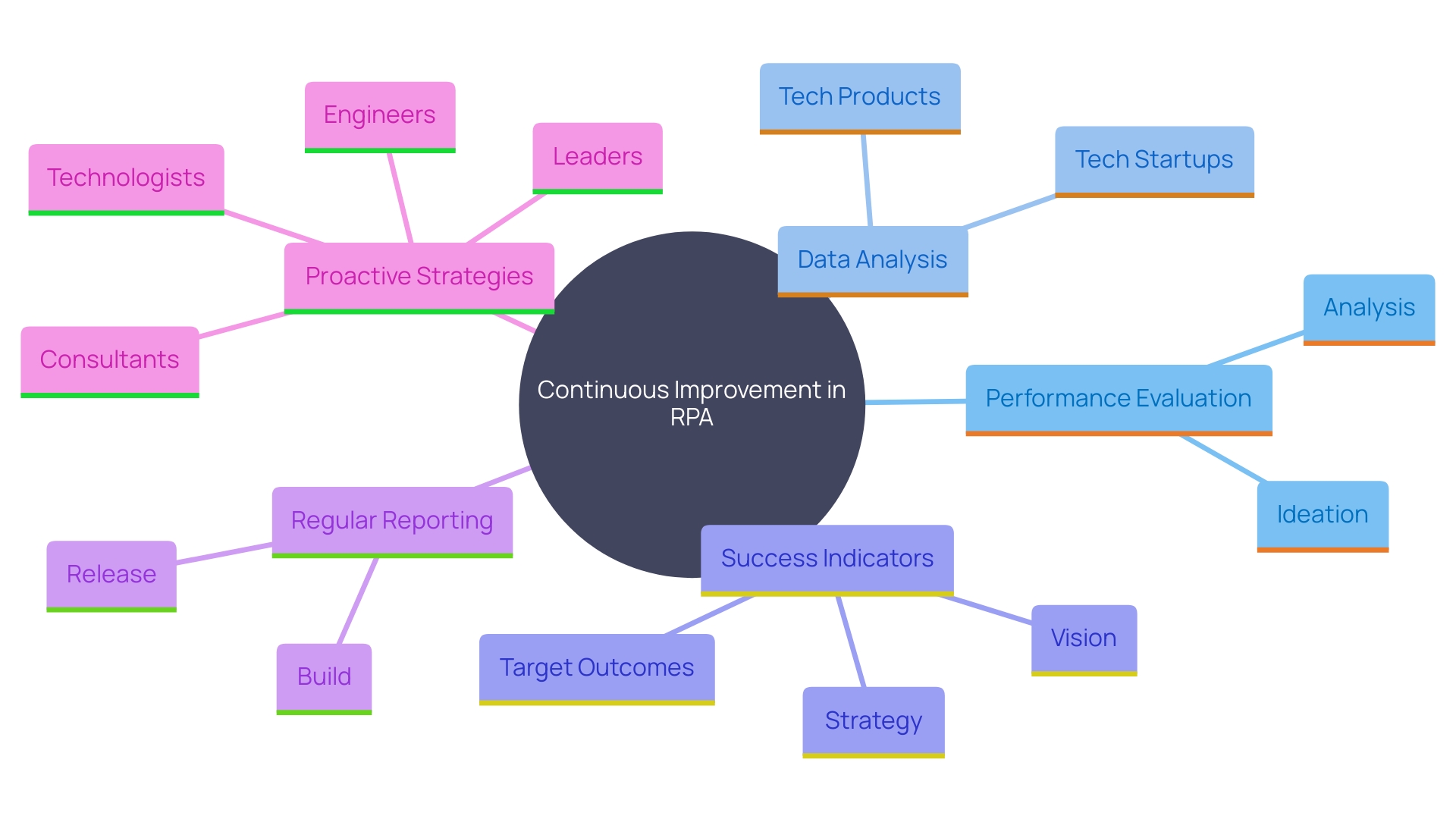
Best Practices for Successful RPA Implementation
Start by identifying the processes and stakeholders involved. Outline the systems, like inventory management and online shop software, to identify possible candidates for mechanization. Prioritize tasks based on complexity and expected ROI, focusing on low-complexity, high-impact tasks for quick wins. For instance, many companies have successfully automated identity verification and order inquiries, significantly improving efficiency.
Involve stakeholders from the beginning to ensure buy-in and smooth implementation. Clear communication is key to overcoming resistance and ensuring everyone understands the benefits and tradeoffs of automation. Establish guiding principles for selecting the right technologies, understanding the nuances within each category, and evaluating vendor options.
Providing ongoing support is crucial. Automation isn’t a hands-off process; it requires continuous monitoring and management. As the CTO of Reveille Software notes, even with advanced technologies like AI, human partnership is essential to maintain stability and drive success. By adhering to these best practices, you can effectively implement RPA and achieve substantial operational improvements.
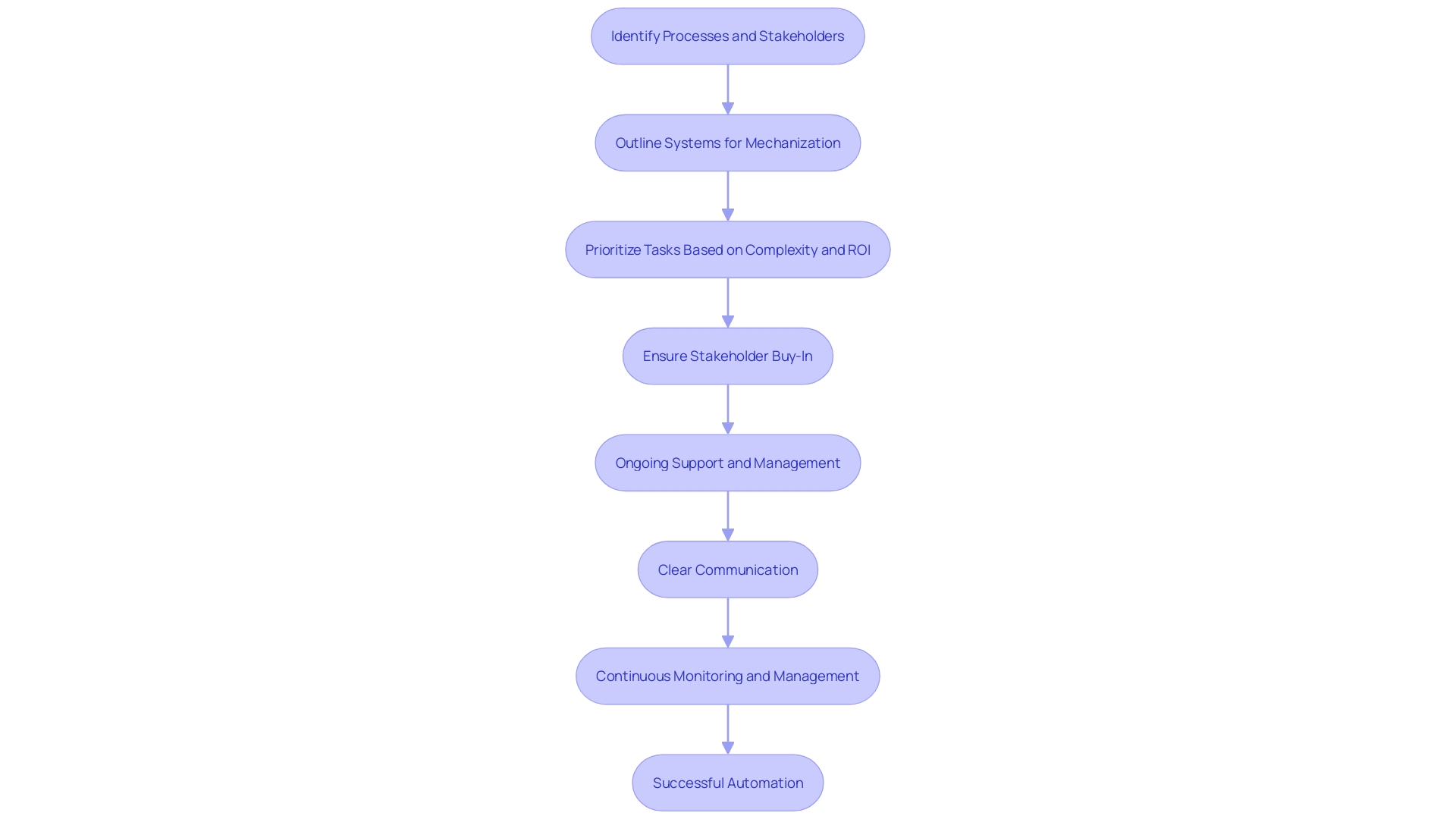
Common Challenges and How to Overcome Them
Navigating common challenges such as employee resistance, integration issues, and data quality concerns requires a multifaceted approach. Fostering a culture of innovation is essential, as trust and engagement are pivotal for successful digital transformation. As Jeremie Brecheisen notes, initiating a cultural shift is crucial when integrating AI, emphasizing the need for trust between leaders and employees. Additionally, robust testing and maintaining high data standards are critical to overcoming integration and data quality obstacles. Digitization, digitalization, and digital transformation are interconnected steps where technology enables humans to focus on high-value tasks, enhancing overall operational efficiency. Embracing these strategies will ensure a smoother transition and greater acceptance of new technologies.
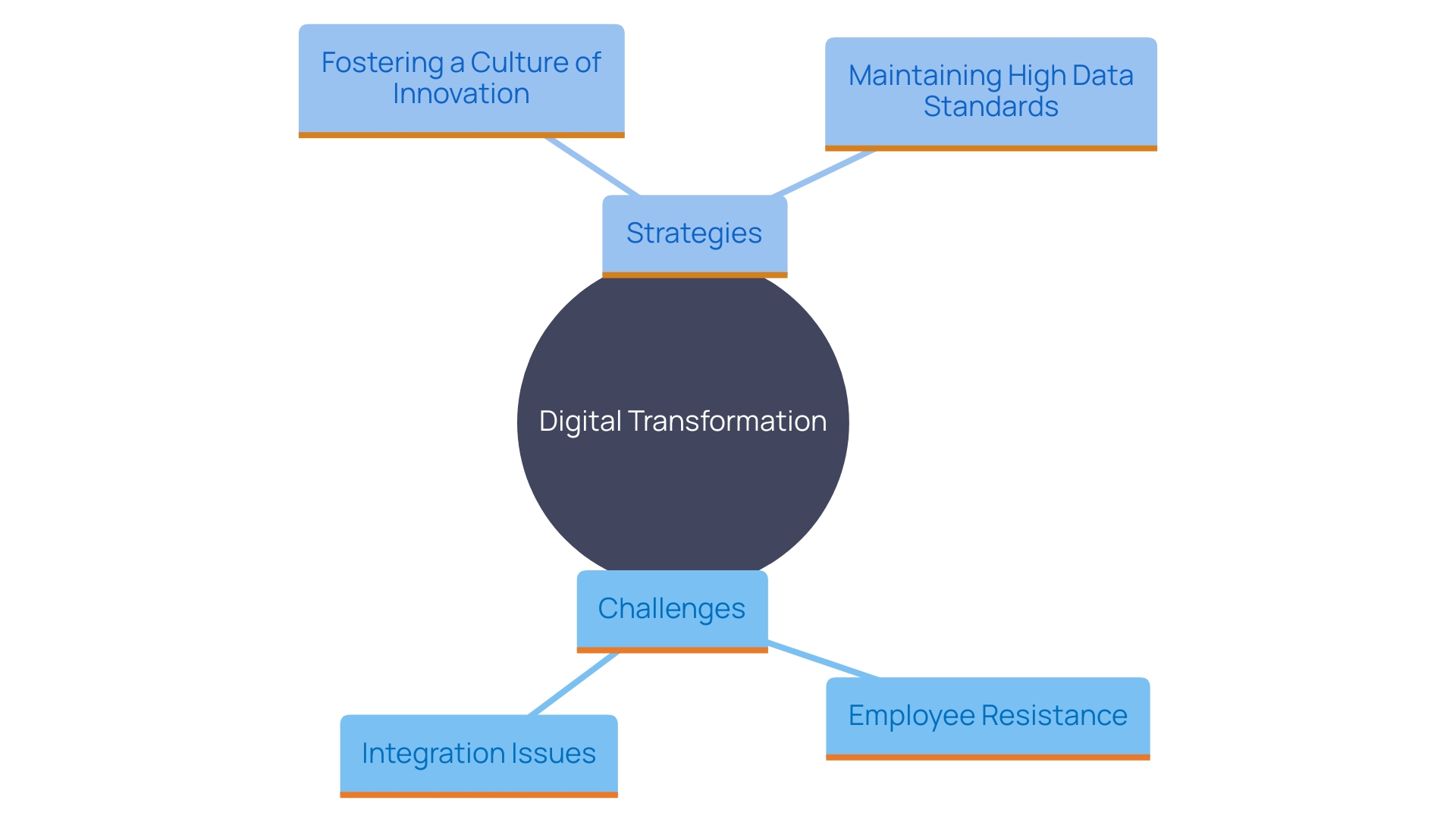
Conclusion
Successful implementation of Robotic Process Automation (RPA) hinges on a structured approach that addresses each critical step outlined in the roadmap. Defining clear objectives and selecting the right tools set the foundation for optimizing processes. Engaging stakeholders and thoroughly assessing potential opportunities ensure that automation efforts align with organizational goals and yield high-impact results.
Pilot testing and a phased deployment strategy are essential for mitigating risks and validating the effectiveness of RPA solutions. Continuous monitoring and proactive maintenance further enhance operational efficiency, while robust security measures safeguard sensitive data and ensure compliance with regulations. Training programs and effective change management strategies are vital in fostering a culture that embraces automation.
Ultimately, the journey toward automation is an ongoing process of continuous improvement. By leveraging data analytics and regularly reporting on performance metrics, organizations can identify new opportunities for automation, driving further operational enhancements. Embracing these best practices not only maximizes the benefits of RPA but also positions organizations to thrive in an increasingly competitive landscape.
The commitment to innovation and efficiency will unlock unprecedented potential, paving the way for long-term success.
Introduction
In an era where efficiency and accuracy are paramount, the insurance industry is increasingly turning to Artificial Intelligence (AI) to revolutionize claims management. As insurers grapple with the vast amounts of structured and unstructured data inherent to their operations, AI emerges as a beacon of innovation, drastically reducing processing times and enhancing customer satisfaction. By automating routine tasks and leveraging advanced analytics, AI not only accelerates decision-making but also plays a pivotal role in early fraud detection, thereby minimizing losses and boosting profitability.
Despite the promising benefits, the journey towards full AI integration is fraught with challenges. Balancing technological advancements with robust governance frameworks is essential to ensure sustainable digital transformation. Moreover, addressing data privacy concerns, integrating with legacy systems, and overcoming employee resistance are critical hurdles that need strategic solutions.
This article delves into the transformative potential of AI in insurance claims management, exploring how it enhances accuracy, streamlines processes, and offers practical solutions to the industry’s inherent challenges.
Benefits of AI-Driven Insurance Claims Management
Artificial Intelligence (AI) is transforming the management of requests by enhancing both efficiency and accuracy. By automating routine tasks, AI significantly decreases turnaround times, enabling insurers to settle claims faster and enhance customer satisfaction. According to Capgemini, organizations that have implemented AI show significant gains in speed, reduced expenses, and improved target achievement compared to those that haven’t.
AI-driven analytics also play a crucial role in early fraud detection, minimizing losses and enhancing profitability. In fact, property/casualty insurers were among the first to adopt AI and are already seeing benefits. However, the journey hasn’t been straightforward. While 91% of financial services and insurance leaders report launching AI proofs of concept, only 36% are using them widely across business functions. Despite these challenges, AI provides a solution for managing and processing the vast amounts of organized and unorganized information that insurers handle daily.
Moreover, AI helps in reallocating time spent on administrative tasks. Reports show that underwriters spend 41% to 43% of their time on administrative duties like data entry, leaving only 32% to 33% for essential tasks such as risk assessment and premium calculation. By automating these tasks, AI enables underwriters and adjusters to concentrate more on essential activities that require human intervention, thereby promoting better decisions and results.
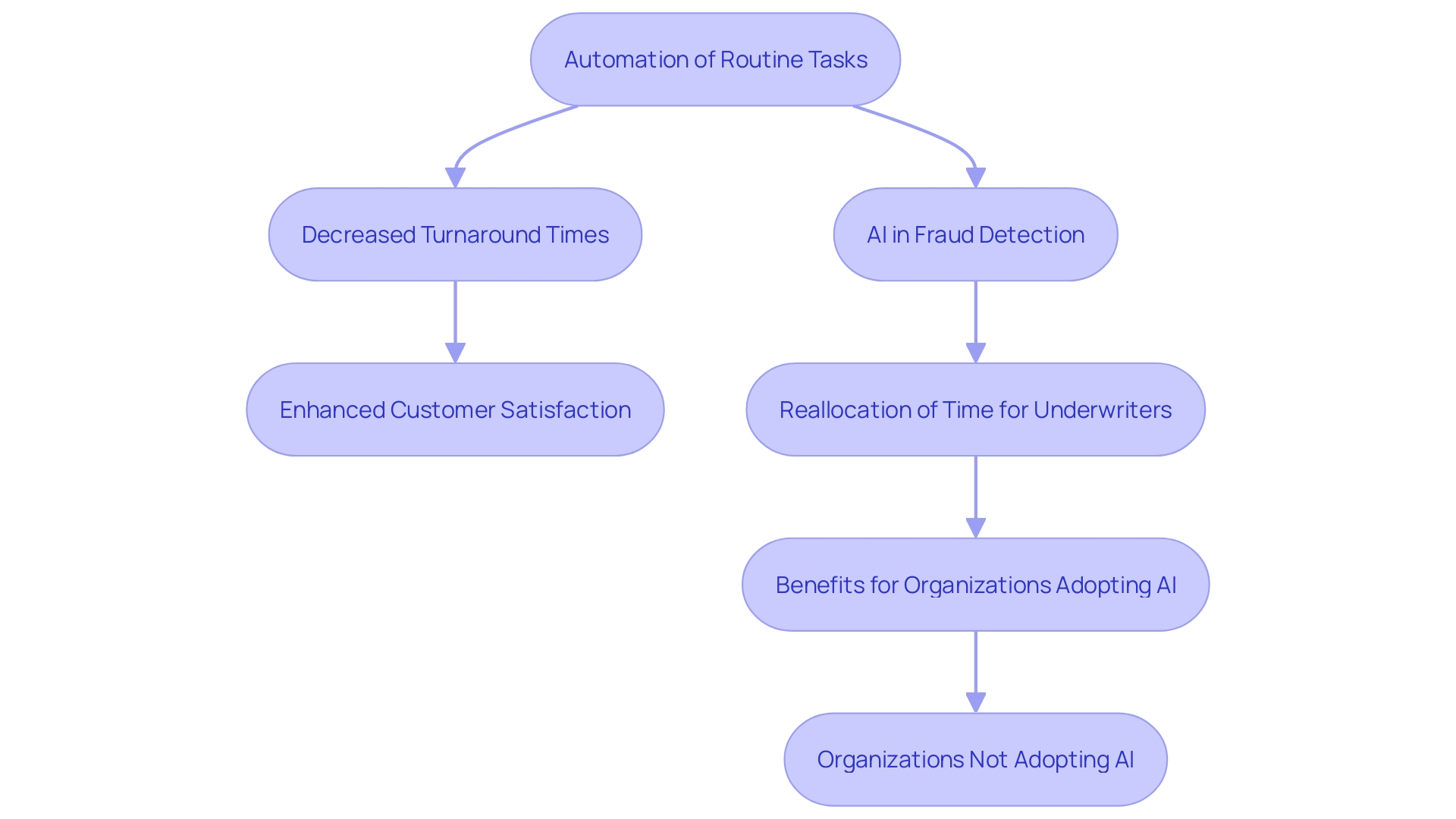
How AI Automates Claims Processing
‘The application of AI in insurance request handling transforms the complete workflow, from initial reporting to final settlement.’. Utilizing natural language processing (NLP), AI effectively examines claims information submitted through various channels, including chatbots and mobile applications. Furthermore, machine learning algorithms analyze historical information to speed up decision-making, thus guaranteeing a smooth workflow and reducing manual mistakes. This technological advancement not only streamlines operations but also significantly reduces operational costs.
Recent studies indicate that while 91% of financial services and protection leaders have initiated AI proofs of concept, only 36% have successfully integrated them across all business functions. Despite the challenges, property and casualty insurers have been pioneers in adopting AI to tackle real-world issues, and many are now reaping the benefits. This move towards AI-driven efficiency addresses the industry’s need to balance innovation with robust governance frameworks, ensuring sustainable digital transformation.
For instance, AI-driven systems can now manage and process the complex mix of structured and unstructured information that insurers deal with daily. This capability is crucial for efficiently handling applications in areas such as property casualty, reinsurance, and commercial lines. The adoption of AI thus emerges as a catalyst for efficiency and prioritization, revolutionizing the insurance sector by transforming how information is utilized and decisions are made.
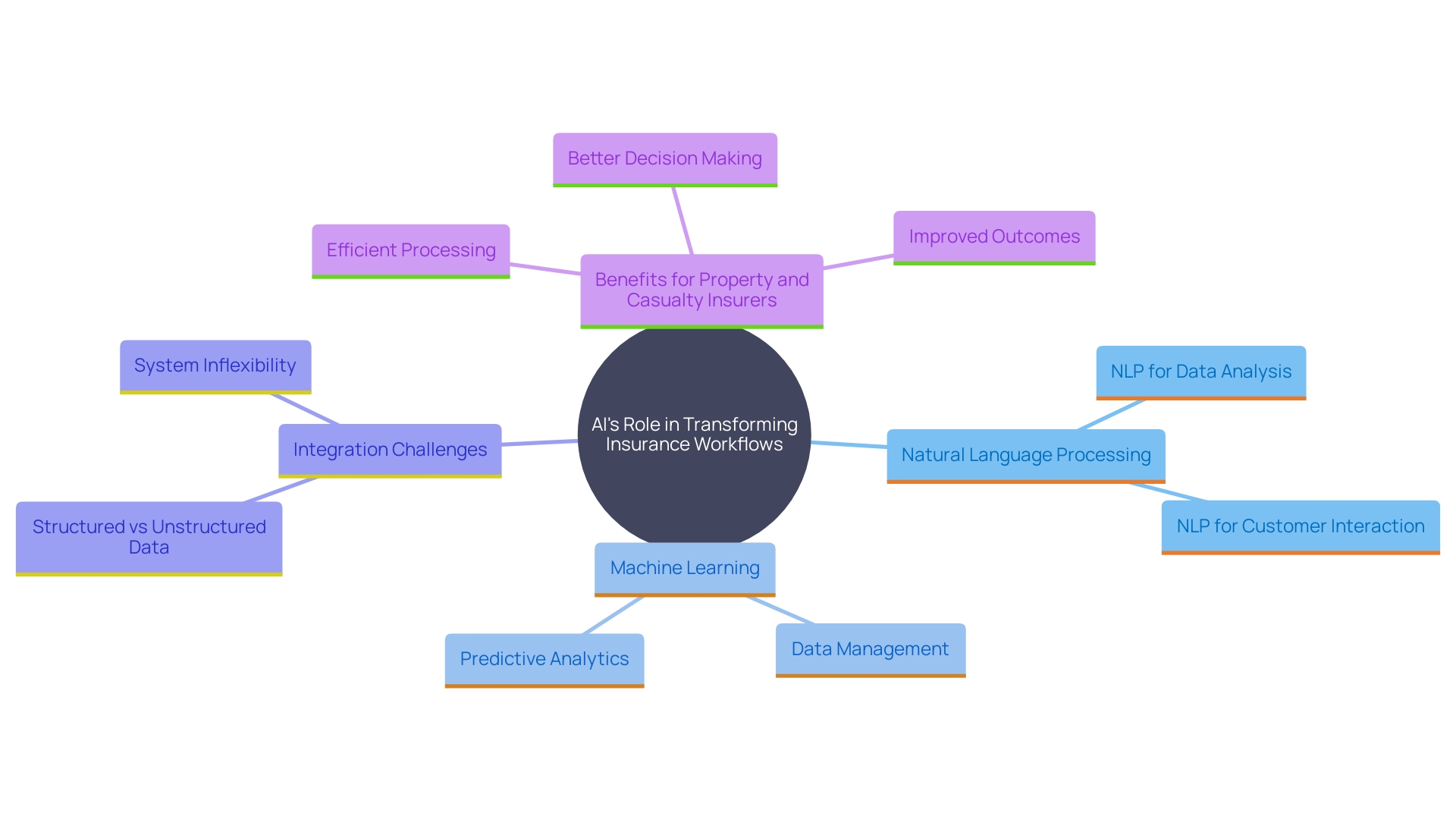
Enhancing Claims Accuracy and Efficiency with AI
AI significantly enhances accuracy by utilizing advanced data validation methods, cross-referencing information from various sources to reduce human errors and guarantee data integrity. This meticulous approach ensures that requests are processed based on precise and verified information. Additionally, AI algorithms excel in analyzing patterns and trends, allowing them to predict the probability of requests being legitimate or fraudulent. According to a Capgemini report, organizations that have adopted AI for automated decision-making have seen notable gains in speed and reduced expenses, outperforming their peers. By enhancing accuracy, insurers can make well-informed decisions, thus driving overall efficiency and productivity in their operations.
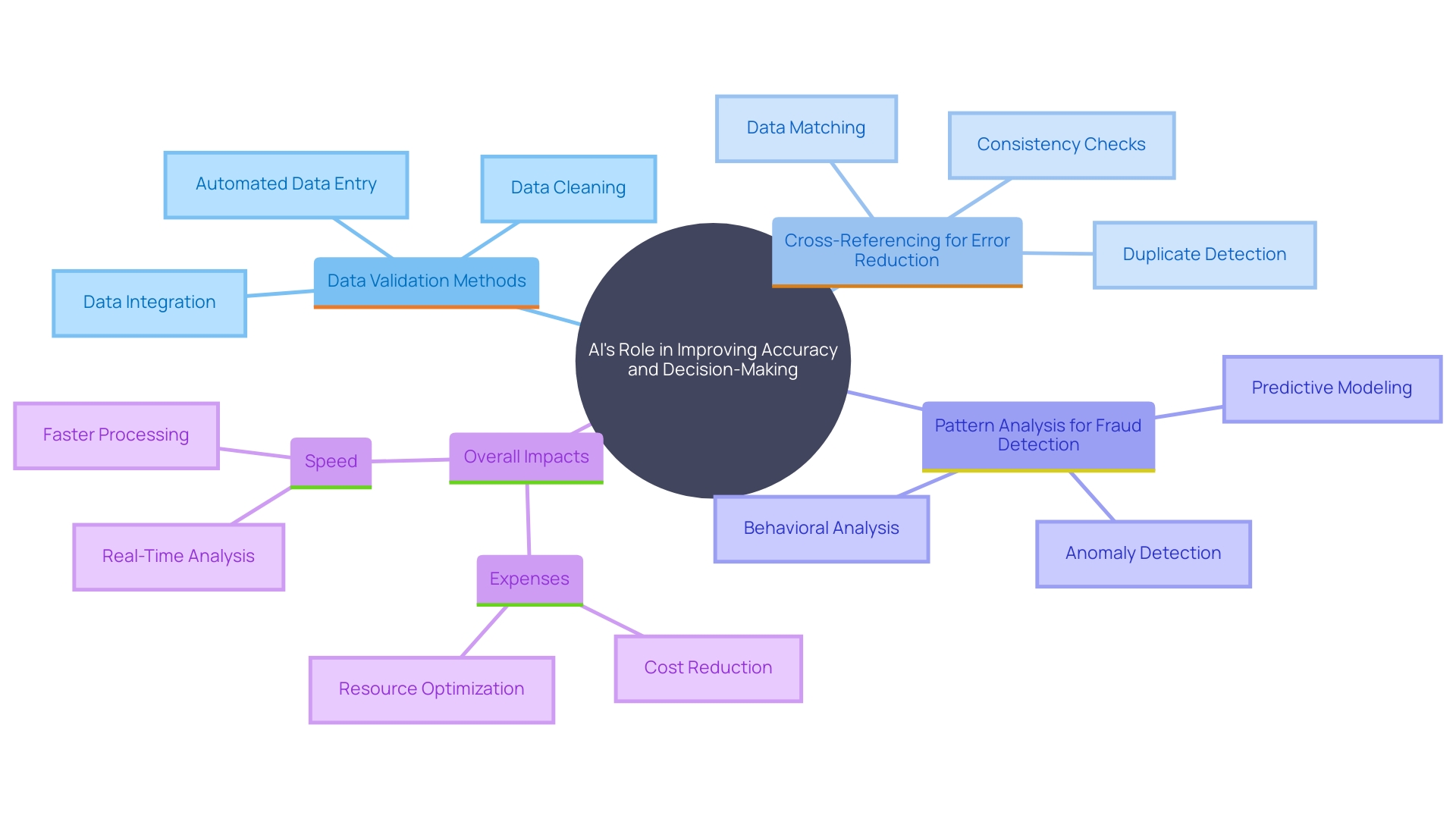
Challenges and Solutions in Implementing AI in Insurance Claims
The incorporation of AI into claims processing provides transformative advantages but also introduces several challenges. Tackling privacy issues is crucial. Recent studies highlight that balancing technological innovation with well-defined regulations is essential to ensure sustainable digital transformations within the sector. This balance helps build trust and protects user information, reducing privacy risks.
Integration with legacy systems is another significant hurdle. The coverage sector frequently handles extensive volumes of varied organized and unorganized information. Traditional systems struggle to manage this complexity efficiently. AI and machine learning can mitigate these issues by effectively prioritizing and processing data, but transitioning from outdated infrastructure requires careful planning and investment.
Employee resistance to change is a common obstacle. Clear and transparent communication about the benefits and impacts of AI can help address this resistance. Investing in comprehensive employee training is crucial, as it equips staff with the necessary skills to adapt to new technologies. A phased implementation strategy allows for gradual adaptation, making the transition smoother and less disruptive.
Overall, while AI adoption in insurance is challenging, it holds the promise of significantly improving operational efficiency. By focusing on transparent communication, robust training programs, and phased implementation, insurers can successfully navigate these challenges and harness the full potential of AI.
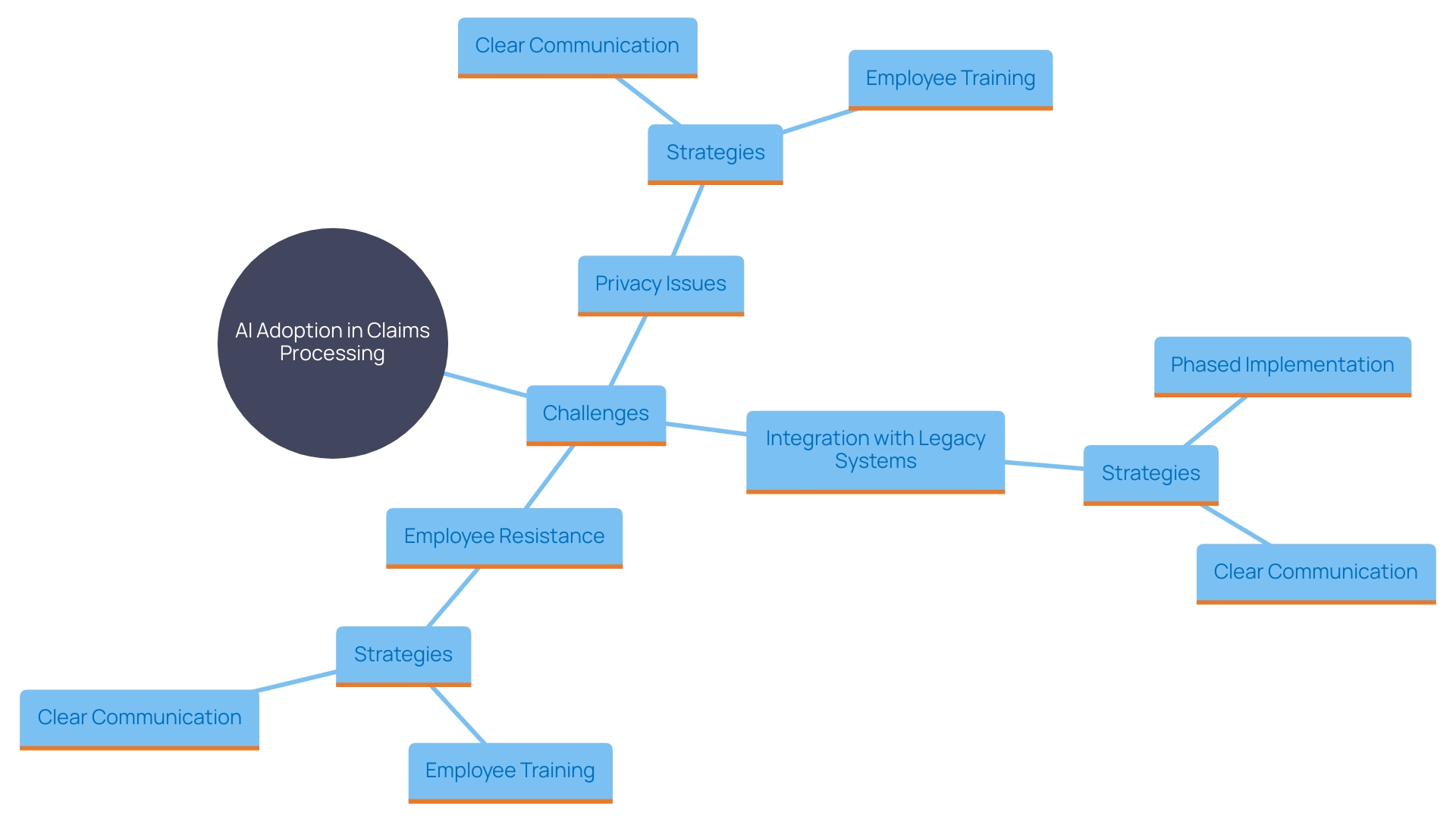
Conclusion
The integration of Artificial Intelligence in insurance claims management presents a transformative opportunity for the industry. By automating routine tasks and leveraging advanced analytics, AI enhances efficiency and accuracy, allowing insurers to process claims faster and improve customer satisfaction. The significant reduction in operational costs and the ability to detect fraud early are compelling reasons for the industry to embrace these technologies.
Despite the clear benefits, the path to full AI adoption is not without its challenges. Data privacy concerns, integration with legacy systems, and employee resistance are hurdles that require strategic solutions. Establishing robust governance frameworks and prioritizing transparent communication can build trust and facilitate smoother transitions.
Furthermore, investing in employee training ensures that staff are equipped to adapt to new technologies, ultimately driving better decision-making and operational outcomes.
In conclusion, while the journey toward AI-driven efficiency in insurance claims management may be complex, the potential rewards are substantial. By addressing the challenges head-on and focusing on sustainable implementation strategies, insurers can unlock the full capabilities of AI, leading to enhanced accuracy, streamlined processes, and improved profitability. Embracing this digital transformation will not only benefit individual organizations but also elevate the industry as a whole, paving the way for a more innovative and efficient future.
